The 10 best places to visit in Vietnam in 2024

Feb 24, 2024 • 8 min read

Experience the best of Vietnam with these top places to visit © hadynyah / Getty Images
With its rolling emerald landscapes, perfect beaches and energetic cities, Vietnam is unsurprisingly a magnet for visitors in search of an incredible travel experience.
This country is teeming with attractions, so it pays to plan your trip around the places you absolutely can't miss. Where you want to go will influence whether you fly into cultured Hanoi in the north or energetic Ho Chi Minh City (HCMC) in the south, or whether you bypass these two megacities for the laid-back beaches of tropical Phu Quoc.
Start your travel to-do list now with our ten favorite places to visit in Vietnam.
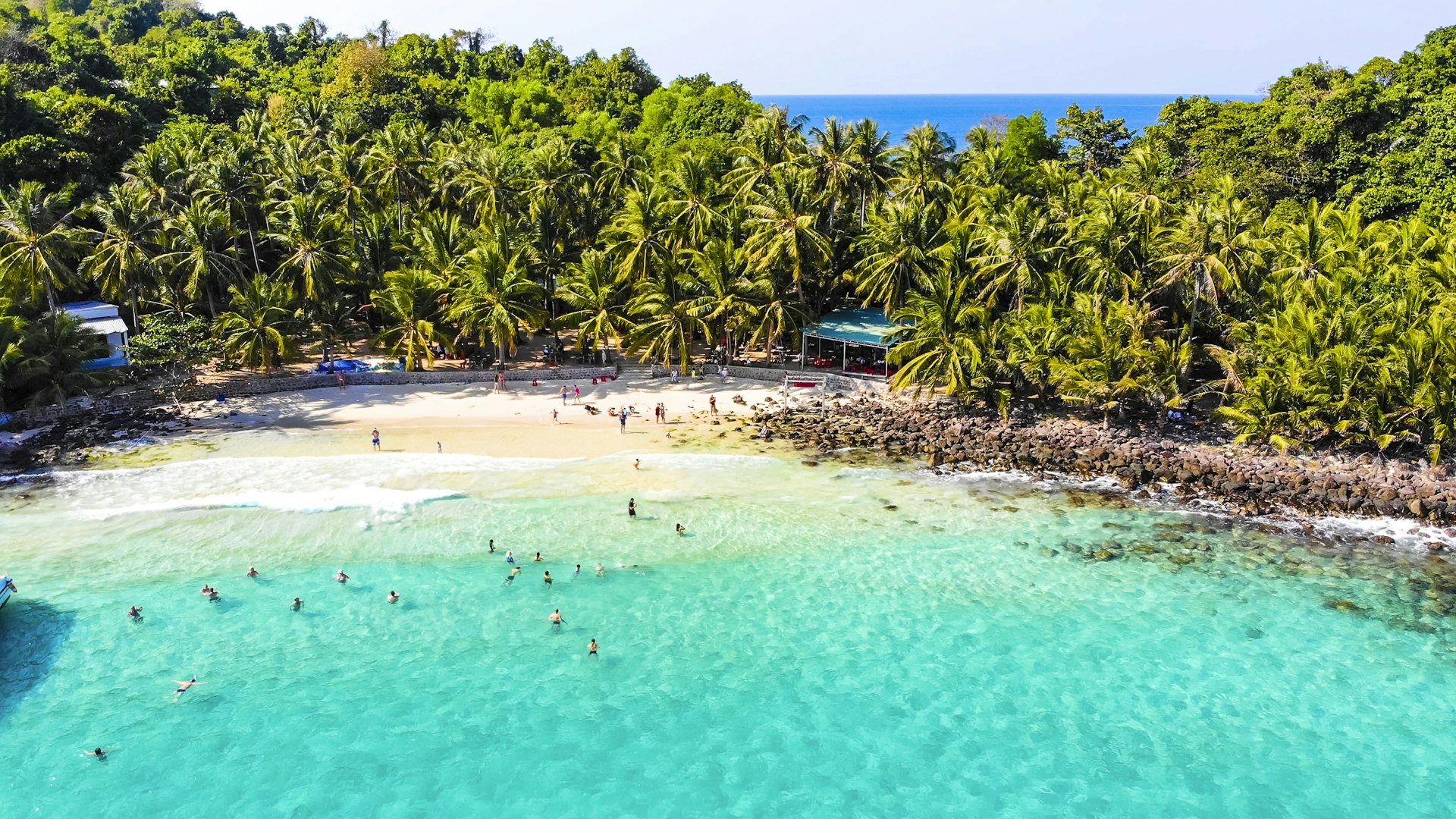

1. Phu Quoc
Best for beach lovers
About as far south as you can get from Hanoi without splashing into the Gulf of Thailand, the island of Phu Quoc is where beach worshippers come to pray. Lapped by jewel-blue waters and edged by fine sandy beaches, this is a place to slip into low gear, reaching for a cocktail as the ember-colored sun dips into the bay.
But it's far from undiscovered – local tourists come in droves for theme park thrills at VinWonders and giddying views over the sea from the world's longest over-sea cable car. Phu Quoc is a popular stop for families, and if you fancy a change from the tourist scene, there are dense jungles to explore inland from the sand.
Planning tip: If you're bound for Phu Quoc, there's no need to go via Hanoi and HCMC; numerous Asian airlines offer flights from hubs such as Bangkok, Kuala Lumpur and Seoul, connecting with long-haul flights further afield.
Best for city slickers
Every trip has to start somewhere, and the ideal point of arrival for first-timers is Vietnam's historic capital. As well as easy infrastructure, inexpensive accommodation, world-class dining and more history than you'll ever have time to take in, Hanoi is the leaping-off point for the islands and outcrops around Halong Bay and the forest-draped trails of the mountainous northwest. Give yourself time to graze through Vietnam's catalog of street food treats and pause to soak up the atmosphere in cozy cafes in the Old Quarter as well as rush around the sights.
Planning tip: To enjoy Hanoi nightlife on a budget, swing by the streetside bia hoi (draft beer) stalls at busy Bia Hoi Junction on the drinking strip of P Ta Hein.

3. Lan Ha Bay and Bai Tu Long Bay
Best for iconic photos
The crowds mob Halong Bay , but for our money, the shimmering bays to the north and south have a slight edge over Vietnam's most famous collection of outcrops and islands. While trips to Halong Bay are highly commercialized, with motorized luxury junks blowing diesel fumes around the eroded karst islands, Lan Ha Bay and Bai Tu Long Bay are a bit more laid-back, and you won't have quite so many cruise ships in your photos. Try kayaking between the outcrops, explore the tropical trails on Cat Ba Island – gateway to Lan Ha Bay – or kick back on the sand on Bai Tu Long's idyllic Co To Island.
Planning tip: If you visit Cat Ba Island, take time to explore the trails around Cat Ba National Park – if you trek with your own guide, it's easy to leave the crowds behind.
4. Ho Chi Minh City
Best for a sense of the past
Cosmopolitan Ho Chi Minh City (HCMC) is the southern counterweight to Hanoi in the north, taking its cultural cues from the Mekong Delta and neighboring Cambodia . It's fast-paced, frenetic and fun, particularly after dark, when the pavements transform into a mobile buffet of street food stalls and roadside bars.
A little of the frontier feel of the war years lives on in HCMC, and you can learn more about this violent period at sites such as the War Remnants Museum . The ghosts of French Indochina linger too – set aside some time to wander past the city's colonial-era landmarks, then settle into a coffee shop with a drip-brewed ca phi .
Planning tip: For a break from the city crush, swing out to nearby Tay Ninh, where the Cao Dai Holy See offers a fascinating introduction to the all-embracing Cao Dai religion.

5. Phong Nha-Ke Bang National Park
Best for unique experiences
Vietnam's biggest natural attraction – literally – is Hang Son Doong Cave, the largest cavern in the world by volume and a true wonder. An entire New York City block could fit inside its vast main passage, but this monster cavern is only accessible on expensive guided treks.
The good news is that Phong Nha-Ke Bang National Park is pockmarked with caverns that you can clamber, crawl, boat or zipline through for a fraction of the cost. Trips to the Tu Lan, Phong Nha and Paradise caves are possible on a shoestring budget; more cash will buy access to Hang En, where trekkers set up tents on an underground beach, illuminated by shafts of natural light.
Best for history
A stay in harmonious Hoi An is a journey into Vietnam's lavish, layered past. This was once one of the most important ports in Asia, and traders from as far afield as Japan, Spain and North America filled the pockets of its merchants with gold. Locals used their money wisely, packing the Old Town with teetering shophouses, tea warehouses, fanciful covered bridges, elaborate Chinese guildhalls, and colorful Confucian and Buddhist pagodas. History is only the beginning – many travelers stay for days, learning to make white rose dumplings and summer rolls on chef-led cooking courses, and ordering made-to-measure suits and gowns from the city's modestly priced tailors' shops.
Planning tip: For a change of pace, head inland from Hoi An and spend a night in a friendly community homestay in the Co Tu minority village of Bho Hoong.

7. The Central Beaches
Best for sun-seekers
Sandy bays stud Vietnam's central coastline, but the mood varies widely from beach to beach. Package tourists flock to high-rise Danang and Nha Trang – famed as military R&R stops during the American War – but we rate the calmer beaches along the coast, where a little of Vietnam's old seaside charm still endures. To the south of Nha Trang, Mui Ne is a lively kitesurfing hub following a string of sandy coves, while Doc Let Beach to the north serves up 18km (11 miles) of sand, surf and seafood. For a quieter experience, hit the coast between Hue and Danang – Thuan An is the gateway to a string of serene and sandy beaches flanking a lagoon-backed barrier island.
Best for imperial history
The former capital of the Nguyen dynasty – which ruled over large parts of Vietnam, Laos and Cambodia in the 19th and 20th centuries – drips with imperial history, despite the ravages of US bombers during the American War. Much was lost in Hue , but the grandeur of dynastic Vietnam lives on in the Citadel and Imperial Enclosure , housing the emperor's residence, temples, palaces and court. At one time, entering without permission would bring instant death. Just outside town are the tombs of Vietnam's greatest emperors, resting serenely in green compounds beside the Perfume River. Another relic of royal rule is Hue's imperial cuisine – arguably the finest in the country – try a spicy bowl of bun bo Hue (vermicelli noodle soup) or a crispy banh khoai pancake, and you'll see what we mean.
Planning tip: To stay one step ahead of the crowds at Hue's imperial tombs and rent a motorcycle or scooter to explore; don't miss the Thien Mu Pagoda on your way out of the city.

9. Ba Be National Park
Best for lake and forest scenery
Vietnam has more than 30 national parks , taking in everything from coastal swamps to mountain jungles, but some are firmly on the tourist trail, and the crowds can be an impediment to spotting wildlife. That's less of a problem in lovely Ba Be National Park , where trails weave between the limestone peaks to Hmong, Tay and Dzao villages, and boat and kayak trips cross serene lakes hemmed in by forested ridges, creating scenes worthy of a medieval woodcut. The park is a haven for everything from macaques and langur monkeys to rare black bears, scaly pangolins and the spectacular crested serpent eagle.
Planning tip: Comfy accommodation in village homes completes the sense of stepping off the mainstream tourist circuit. For an intimate homestay experience, check out the family-run guesthouses in Pac Ngoi village, accessible by bus from Hanoi, via the village of Cho Don.
10. Ha Giang
Best for mountain views
Trekking to the minority villages in the hills around Sapa is one of Vietnam's top draws, but the country's trekking capital feels rather commercialized these days. Hikers have to walk further every year to find the rural idyll that first drew people to the northwest.
For scenic countryside without the company, remote Ha Giang province is Vietnam's new frontier. Staying in simple village homestays, you can hike out to minority villages and rice terraces tucked between the soaring limestone peaks, and motor (or pedal) over some of Vietnam's most spectacular passes. You'll want to take plenty of photos on the winding mountain road between Ha Giang town, Dong Van and Meo Vac.
Planning tip: If you're confident in the saddle, motorcycles can easily be rented in Ha Giang town – just ride slowly and be ready for rainy conditions!
This article was first published April 2021 and updated February 2024
Explore related stories
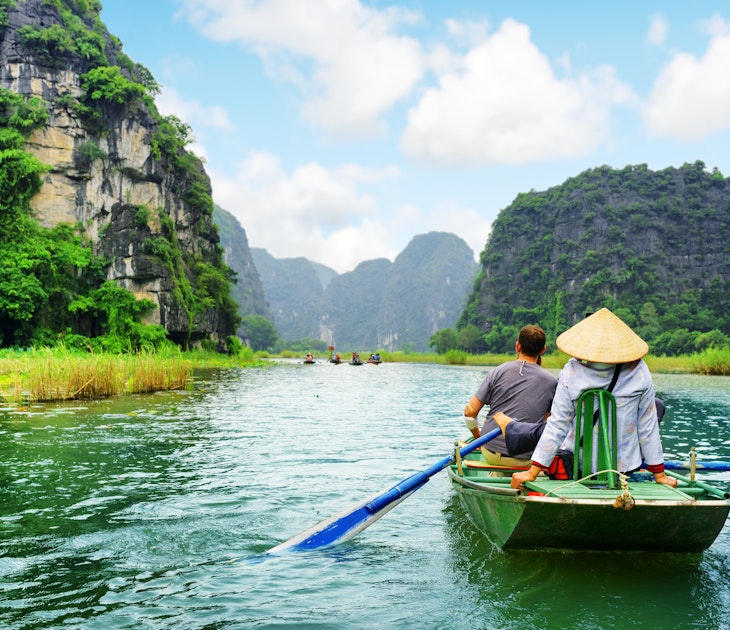
Mar 14, 2024 • 10 min read
Whether it's bus, train, private car, motorcycle, bike, plane or boat, you can plan your trip around Vietnam with this guide to getting around.

Feb 22, 2024 • 5 min read

Feb 3, 2024 • 7 min read

Jan 17, 2024 • 8 min read

Dec 27, 2023 • 8 min read

Dec 15, 2023 • 7 min read
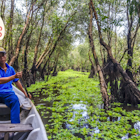
Nov 17, 2023 • 5 min read
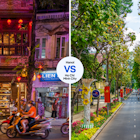
Nov 16, 2023 • 7 min read
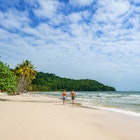
Nov 7, 2023 • 5 min read

Oct 28, 2023 • 7 min read
- Search Please fill out this field.
- Manage Your Subscription
- Give a Gift Subscription
- Sweepstakes
- Travel Tips
The Best (and Worst) Times to Visit Vietnam, According to Experts
Here's when to visit Vietnam for sunny weather, lower prices, and excellent sightseeing.
:max_bytes(150000):strip_icc():format(webp)/SophieDodd-29f8105329084ddbafdf19974fa43b45.jpg)
Best Times to Visit for Smaller Crowds
Best times to visit for good weather, best times to visit for lower prices, best times to visit for hiking in sa pa, best times to visit for cruising ha long bay, worst times to visit.
Khoa Nguyen/Getty Images
Cinnamon and star anise perfume my memories of Vietnam, a country that lodged itself into my palate in fragrant, frenzied bursts. That alluring scent of pho was one of few constants as I traveled through vastly different landscapes, trekking through verdant rice terraces, dodging motorbikes en route to speakeasies, and standing face to face with an endangered monkey in my oceanfront outdoor shower — all within the span of two weeks.
Vietnam is more than 1,000 miles long, a spectacularly slim country that’s only 30 miles wide at its narrowest point. Every region boasts its own allure as well as its own climate, which means you’ll need to carefully consider the time of your visit based on your desired itinerary.
“As the climate varies so much from north to south, there will always be somewhere worth going in Vietnam, whatever time of year you travel,” says Melissa Matthews, regional director for Southeast Asia and North America at luxury travel company Red Savannah .
Here's a regional breakdown of the primary tourist seasons in Vietnam:
- High Seasons: North: September to November, March and April; Central: April to August; South: October to April
- Shoulder Seasons: North: December to February, May to August; Central: September to March; South: September to December
- Low Season: North: May to October; Central: September to May; South: May to September
Before you start planning your trip, read on to learn about the best times to visit Vietnam for hiking the majestic, mountainous rice terraces of Sa Pa, cruising the limestone marvels of Ha Long Bay, and avoiding the rainy monsoon season.
Bang The Tran/Getty Images
The high season in Vietnam varies according to the region, so you’ll always be able to find a place that feels more secluded from the bustle of crowded beaches or cruise ships. Wet season attracts fewer crowds, says Matthews, which falls from May to October in the north, September to May in the central part of the country, and May to September in the south.
Visiting during this time has plenty of perks, as you’ll likely be able to save on accommodations and travel costs. Popular restaurants and tours will be less overrun with tourists, offering a rare opportunity to better immerse yourself in the local culture as you tuck into bun cha on a sidewalk stool. However, bursts of rain and cloudy weather can dampen any plans to hike in Sa Pa or cruise along Ha Long Bay — two quintessential experiences you won’t want to miss.
There are also an abundance of places that remain less crowded throughout the year, says Benjamin Kreuz, general manager of Six Senses Ninh Van Bay — the resort itself is one of them, nestled in a private cove of Nha Trang that became my personal definition of paradise. Many visitors tend to prioritize other attractions as they make their way south, so natural wonders in the north like Ban Gioc Waterfall and the network of caves in Quang Binh remain less busy.
Meet the Expert
- Melissa Matthews is the regional director for Southeast Asia and North America at luxury travel company Red Savannah.
- Benjamin Kreuz is the general manager of Six Senses Ninh Van Bay in Vietnam.
No matter when you visit, you’ll always find good weather somewhere in Vietnam. “Vietnam is a beautiful country with tropical weather, making it suitable for visits throughout the year,” says Kreuz.
For those hoping to see Hanoi, Ho Chi Minh City, and everything in between, it’s best to go in the dry season. “February and March are the best months to see the entire country from north to south in relatively dry weather,” says Matthews. She notes that Tet, or Vietnamese Lunar New Year, falls during this time and can last for up to 10 days. “During this time, most of the key sights in the cities are closed, as everyone goes back to their family villages to celebrate,” she says. She recommends heading to the beach during the festival and bookending your trip with time in the major cities.
For a dry and temperate trip to Sa Pa or Hanoi in the north, head there from September to November, or in March and April, she suggests. A sunny beach visit to Hoi An or Nha Trang in the central region is best from April to August, while the Mekong Delta and Phu Quoc Island in the south are warmest from October to April.
Vietnam is a relatively affordable destination all year long, with abundant and economical street food and comfortable hotels for all budgets. For your best chance at scoring low-cost flights and accommodations, consider traveling outside the peak tourist season. April, May, October, and November are excellent times, as you’ll still find warm weather throughout the country, but will have fewer tourists to contend with.
Wand_Prapan/Getty Images
A visit to the verdant, terraced rice fields of Sa Pa are a must for nature lovers and outdoor enthusiasts alike. Overlooking the Muong Hoa Valley, the hills are surrounded by spectacular mountains and home to dozens of communities, including the Hmong and Red Dao peoples — many of whom open their homes for overnight stays and lead private or group trekking tours. You can reach this famed hiking destination by car from Hanoi in five hours, by a bus in six to eight hours, or on an overnight sleeper train.
Matthews notes that this region tends to get colder from December to February, so it’s best to plan a trip from September to November or in March and April. Harvest season is also an unforgettable time to visit: In late August through September, the vibrant green hillsides turn a voluptuous shade of gold as the rice ripens.
Nikada/Getty Images
Ha Long Bay, with its emerald waters and limestone towers, is one of the primary tourist destinations in Vietnam, and as such, has become increasingly overrun with cruise operators leading day tours. For a less crowded experience, consider booking an overnight cruise that will take you deeper into the bay — or to the equally beautiful, slightly less populated neighboring Lan Ha Bay. (I splurged for a two-night cruise with Orchid Cruises , one of the more luxurious tour operators).
March, April, October, and November are ideal months to visit, as they tend to bring warm and sunny weather without as much humidity. You’ll also avoid the peak season, so while it’s still bound to be busy, you can enjoy kayaking through the tranquil waters and hiking Cat Ba island in relative peace. The UNESCO World Heritage Site is also a great opportunity for a snorkeling or scuba diving adventure.
Nick Dolding/Getty Images
While Vietnam’s varied climate means there’s never really a bad time to visit, you may want to avoid traveling to the country during monsoon season.
“When the monsoon hits, it is hard and heavy and very humid,” says Matthews, who suggests sightseeing in cities during the wet season, where you can still visit museums and historic temples between rainstorms. “Avoid the mountainous region of Sa Pa and definitely don’t book a cruise in Ha Long Bay, as storms will occur and boats are grounded,” she warns.
If you do decide to travel during the rainy season, it’s best to remain flexible in your planning, says Kreuz. “Consider not booking everything in advance due to unpredictable weather,” he says, adding that staying open-minded may help you to take advantage of potential low-season discounts.
Tet, which marks the Vietnamese Lunar New Year, is another tricky time to visit, as many landmarks and businesses close for a week or more to celebrate. It typically lands in late January or early February — this year, it falls on Feb. 10.

17 Best Places to Visit in Vietnam
Written by Jess Lee Updated Aug 30, 2023
Vietnam is an astonishing mix of natural highlights and cultural diversity.
The scenery ranges from jagged peaks seen from winding mountain passes down to verdant paddy fields painted every shade of green in the palette, while Vietnam's long history and multicultural population (with over 50 ethnic minority groups) make a trip here rich in heritage.
Outdoor lovers can get their teeth into the countryside within the numerous national parks, where hiking, biking, and kayaking are popular things to do, but Vietnam's most famous natural tourist attraction, the spectacular karst seascape of Halong Bay, is one natural sight that even the more slothful can experience up close on a cruise.
While the rural areas brim with lush panoramas, the big cities buzz with contemporary life and provide ample opportunities to get stuck into Vietnam's tasty culinary highlights.
This fascinating country is full of surprises and is one of Southeast Asia's most underrated destinations. Plan your sightseeing with our list of the best places to visit in Vietnam.
1. Halong Bay
2. ho chi minh city, 4. phong nha-ke bang national park, 7. sapa countryside, 9. nha trang, 10. cu chi tunnels, 11. ba be national park, 12. mekong delta, 13. cat ba island, 14. ha giang, 15. phu quoc island, 16. con dao islands, frequently asked questions, when is the best time to visit vietnam.
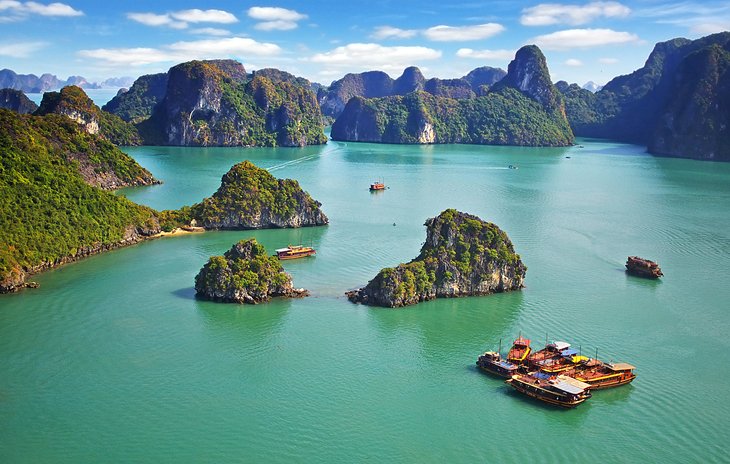
The karst seascape of Halong Bay is one of the best places to visit in the world for spellbinding sea views and is a UNESCO World Heritage Site.
Thousands of limestone islands sit within this bay in the Gulf of Tonkin, eroded into jagged pinnacles by wind and water action over millennia.
With the bay's scenery best seen by boat, this is prime cruising territory. Opt for at least an overnight tour to see Halong Bay's iconic views as a day trip doesn't do it justice.
There are plenty of caves in the bay that can be entered including the Hang Sung Sot, with three mammoth caverns, and the Hang Dao Go, with superbly weird stalagmites and stalactites. For most people though, the highlight is simply cruising amid the karsts and soaking up the changing scenery of pinnacles as you pass by.
There are plenty of different cruise tours to choose from. Check the different itineraries offered before booking as many travelers have left Halong Bay underwhelmed by their cruise.
Author's Tip: If possible, book a tour that takes in neighboring Lan Ha Bay as well as Halong Bay. The karst scenery is just as dramatic here but fewer cruise trips visit. And check if your cruise offers included activities such as guided kayaking (which allows you to experience an up-close view of the scenery).
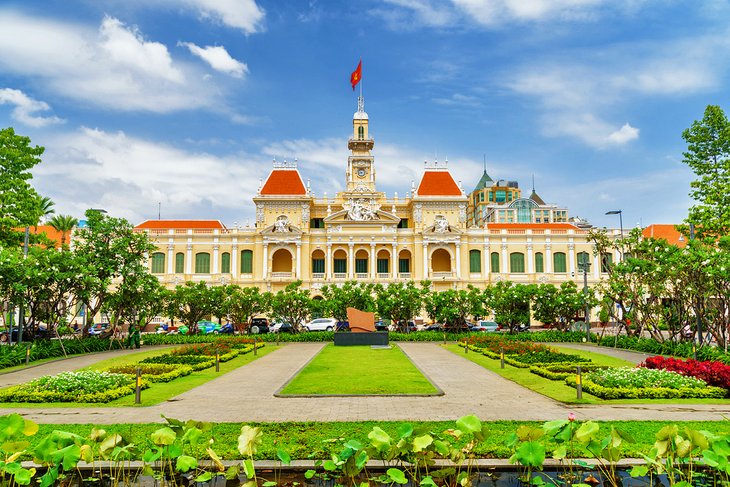
For big city fans, no visit to Vietnam is really complete without a visit to Ho Chi Minh City, the buzzing commercial hub of the country.
The streets are an insane clog of motorbikes and cars, the restaurant and café scene is incredibly cosmopolitan, and the shopping is the best in the country.
At its center is Dong Khoi, a relatively small and easily navigable central district, which holds most of the city's sights.
Here, you'll find the HCMC Museum, with a brilliant collection of artifacts that weaves together the story of the city, and the grand Notre Dame Cathedral, built in the late 19th century.
Check out the old district of Da Kao nearby for some of the best surviving examples of the city's French colonial architecture and also to visit the Jade Emperor Pagoda with its dazzling array of Buddhist and Taoist religious iconography.
Afterwards, the History Museum is a must-do for history fans with stacks of relics on display from various archaeological sites.
For many visitors, the two big-hitter tourist attractions not to miss are just a little out of the center, along Nguyen Thi Minh Khai Street. The Reunification Palace, then known as Independence Palace, was the residence for South Vietnam's president. It's chiefly famous as the spot where North Vietnam's tanks stopped on 30 April 1975, officially ending the war. It's a completely fascinating place to visit complete with 1960s furnishings still in situ.
Nearby is the War Remnants Museum, which although very obviously biased, paints a disturbing picture of the brutality of war and the many atrocities committed by US Forces during their Vietnam campaign.
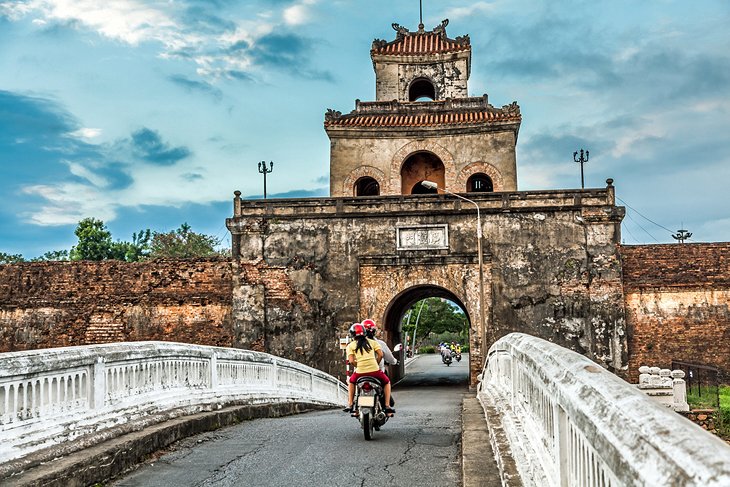
One of Vietnam's most historic towns, Hue is packed to the brim with relics from the reign of the 19th-century Nguyen emperors.
Sitting along the banks of the gorgeous Perfume River, the Imperial Enclosure is a huge site set within walls that sprawl for 2.5 kilometers.
While touring the grounds check out the gorgeous Ngo Mon Gate, the Thai Hoa Palace with its finely lacquered interior detailing, the Dien Tho Residence where the Queen Mothers would live, and the Halls of Mandarins with its preserved ceiling murals.
A dazzling number of historic sites lie outside the Imperial Enclosure walls as well.
One of the nicest ways of visiting a collection of outlying sites is by taking a riverboat cruise on the Perfume River. A day cruise can take you to visit several royal tombs along with some pagodas.
If you're short on time, the best tomb to visit is the Tomb of Tu Doc and the most important pagoda in the area is the Thien Mu Pagoda, with its tower that soars for 21 meters high.
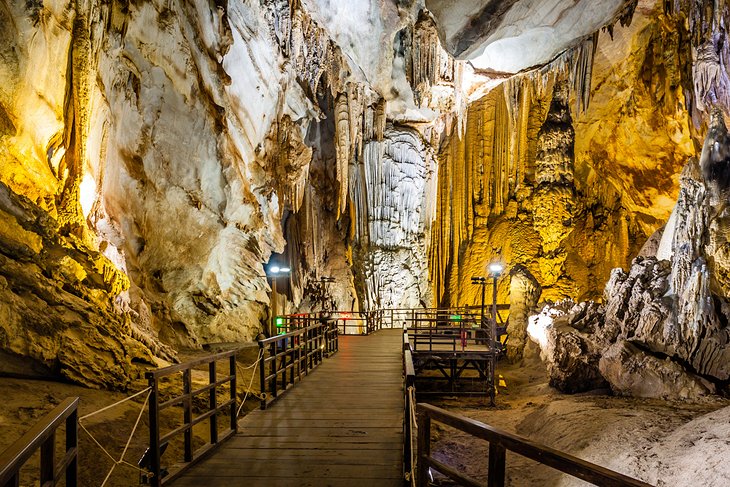
One of the best places to visit in Vietnam for caving, World Heritage-listed Phong Nha-Ke Bang National Park is a dramatic karst mountain formation honeycombed with huge caverns, which are home to superb stalactite and stalagmite displays.
It's best known for its caving activities , which range from multi-day hiking and caving tours for the more adventurous, to simpler half-day trips to caves with easy access provided by boat trips and modern boardwalks, but the national park also offers mountain biking and trekking activities.
The most popular destinations within the park are the Paradise Cave , which extends for a staggering 31 kilometers below ground, and the Phong Nha Cave, where the interior is accessed by boat. Half-day tours can be easily arranged once you're in the area.
The national park's most renowned caverns though are Son Doong Cave (the world's largest cave) , and the Tu Lan Cave with its cavern river system. Access to these, and to certain other caves in the park are restricted to organized tours (ranging from one-day to multi-day expeditions) which are all run by Phong Nha's expert adventure tour company Oxalis . It's well worth booking in advance to secure your spot.
To make the most of your time here, time your visit for outside the rainy season, which runs from October to December, when many of the national park's caves are closed to the public.
You can access Phong Nha-Ke Bang National Park from Son Trach (also known as Phong Nha village).
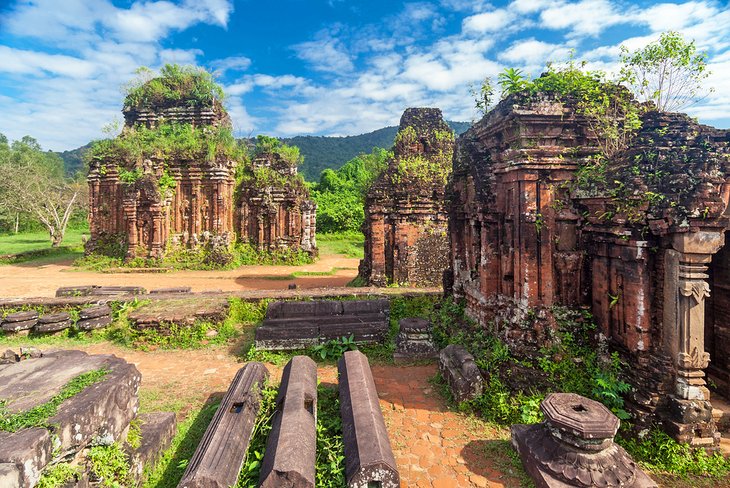
Surrounded by lush jungle-covered mountains, My Son is a ruined Cham era temple city that dates from the 4th century.
This old Hindu religious center was still very much in use during the 7th to 10th centuries and only fell into complete decline and abandonment during the 13th century.
There are around 20 temple structures still standing here, all built of brick or sandstone blocks and showing interesting influences from various Asian empires, including Indian and Malay.
Note that the temples of Group B are the oldest, while Group A once contained the site's most important monument but was destroyed deliberately by US forces during the Vietnam War.
A good museum on-site houses plenty of information on the Cham.
Access to My Son is from Hoi An.
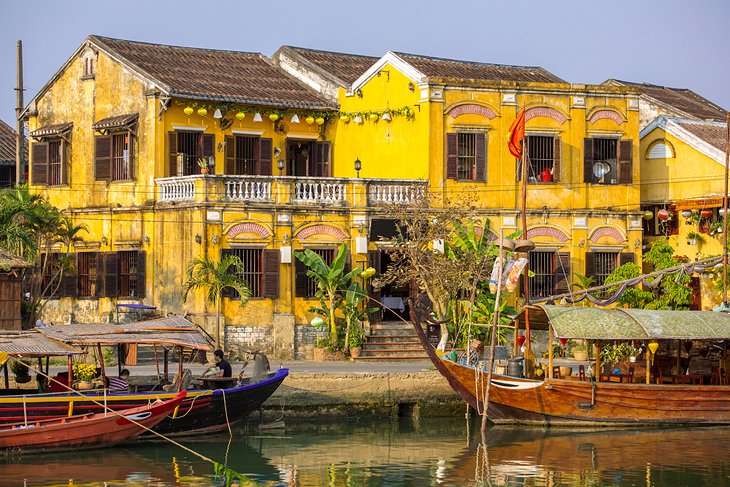
Beautiful Hoi An is the most atmospheric city in Vietnam, with bags of surviving historic architecture.
The old town quarter is a joy to explore, packed to the brim with well-preserved merchant houses that hark back to Hoi An's trading center heyday of the 15th century, when the town was a major meeting point for Japanese and Chinese merchants who flocked here for the local silks.
Plenty of the old merchant houses have been opened to the public, so you can get a taste of these times. The best is 17th-century Tan Ky House, with fascinating architectural and decorative elements.
Hoi An's major symbol is the delightful Japanese Bridge at the western end of Tran Phu Street, while nearby, the Assembly Hall of the Fujian Chinese Congregation is the old town's most highly decorated temple.
There are numerous small pagodas and museums dotted about town, but Hoi An's true charm is found in simply rambling the old town streets admiring the well-preserved facades.
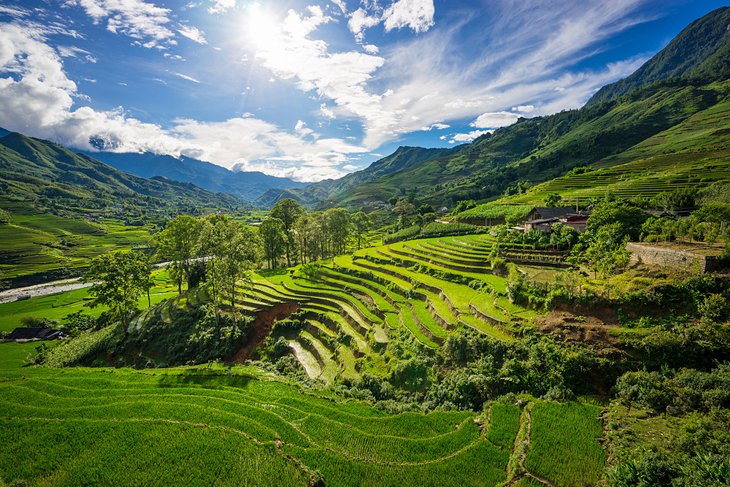
The verdant rice field countryside surrounding Sapa, bordered by the jagged peaks of the Hoang Lien Mountains (often still known by their French colonial era name of the Tonkinese Alps), are home to Vietnam's most beautiful rural vistas.
The deep valleys here are home to a diverse mix of the country's ethnic minorities, including the Hmong, Giay, and Red Dzao people, while the rippling hills are terraced with rice fields and overlooked by the country's tallest peak, Fansipan Mountain.
This is the top trekking destination in Vietnam with oodles of options to trek or day hike between tiny villages and experience the staggering mountain views.
Sapa itself is the main base here - an old hill station and now a bustling and forever growing tourist center that is a stark contrast to the sumptuous tranquil countryside right on its doorstep.
Author's Tip: Keen trekkers looking for more of northern Vietnam's lush mountain vistas may want to skip the busy Sapa scene completely and nudge further 95 kilometers northwest to Bac Ha , where the terraced hill views on hikes between hill villages are just as beautiful. Bac Ha's Sunday market is also a very popular day trip from Sapa.
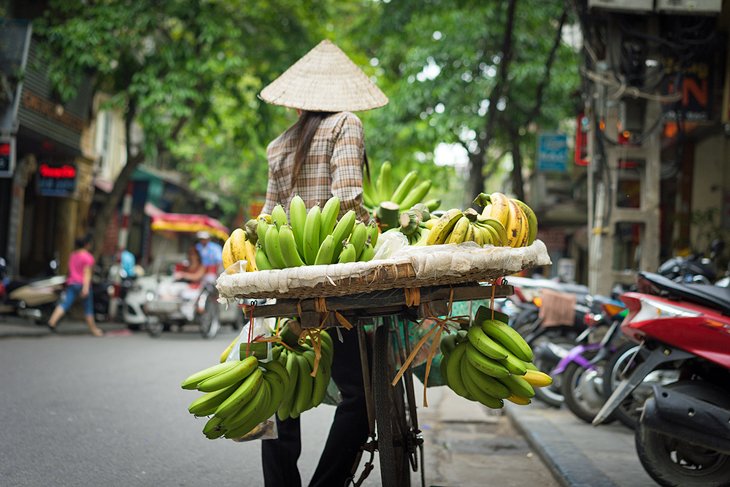
Vietnam's capital is the frenetic heartbeat of the nation and a place that befuddles travelers as much as it charms them.
The motorbike frenzy, pollution, and constant clamor of street vendors can get too much for some travelers, but if you want to dive into Vietnamese city life, Hanoi is the place to do it.
The old town quarter has plenty of dilapidated charm on offer, while history fans should make a beeline here simply to see the bundle of excellent museums.
The Vietnam Museum of Ethnology and Vietnam Fine Art Museum are both brilliant introductions to the diverse artistry of the country, while the Ho Chi Minh Mausoleum is an important tribute to the founder of modern Vietnam.
Author's Tip: It's well worth adding extra time into your itinerary to use Hanoi as a base for exploring the many sights within day tripping distance. In particular, the Tay Phuong and Thay Pagodas (30 kilometers west from the central city), Co Loa Citadel (24 kilometers northeast), and the Huong Pagoda (also known as the Perfume Pagoda; 60 kilometers southwest).
- Read More: Top-Rated Tourist Attractions in Hanoi
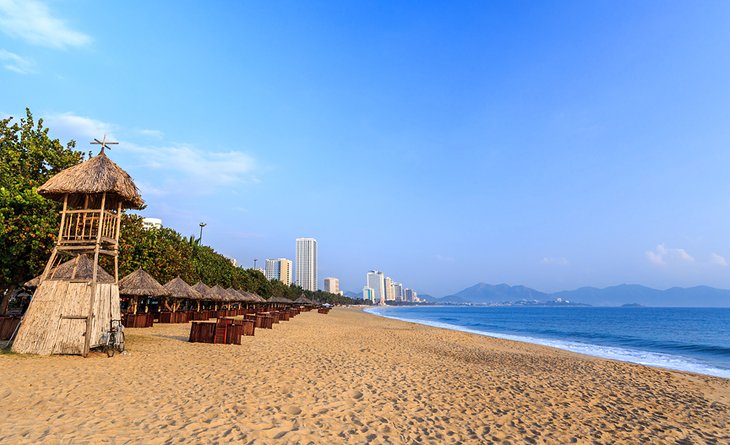
For sandy fun in Vietnam, Nha Trang is king. The well-maintained beach trundles for six kilometers along the shoreline of central Nha Trang city and during summer is jam-packed with local families on vacation, as well as foreign visitors.
There is excellent swimming here with designated swimming areas and manicured lounging areas that make this a great option for relaxing days soaking up the sun and sand.
If you do get bored of sunbathing, the ancient Po Nagar Cham Towers are just to the north across the Xom Bong Bridge and have been used as a place of worship here since at least the 7th century (with some historians saying the site itself has been a place of active worship since much earlier).
There is also an excellent museum dedicated to the work of Alexandre Yersin who discovered the cause of the bubonic plague and founded Nha Trang's Pasteur Institute (which still carries out vaccination programs in Vietnam today).
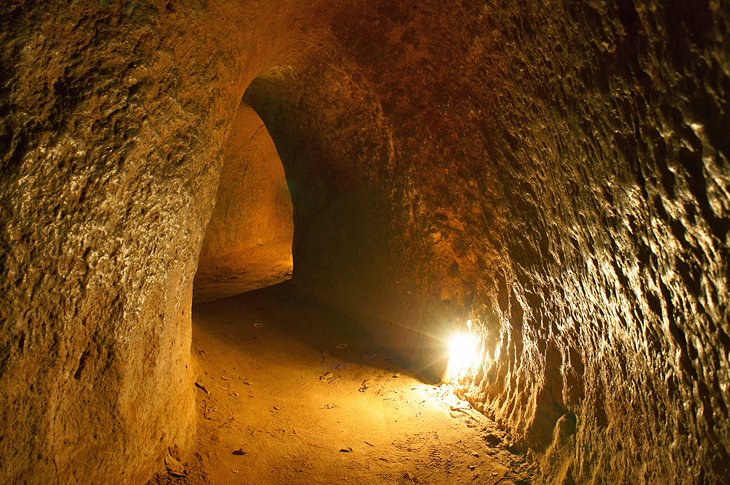
An absolutely fascinating experience for all travelers, not just those interested in Vietnam's modern military history, the Cu Chi Tunnels are an extensive tunnel network that during the war, stretched for more than 250 kilometers, allowing VC troops to operate and communicate in the area surrounding Ho Chi Minh City.
Two short sections of the network can be visited with a guide who'll take you down into the narrow unlit confines, which definitely are not for claustrophobia sufferers.
You will literally be crawling on your hands and knees and some points. You can access the tunnels at either Ben Dinh village (the more popular choice) or Ben Duoc village.
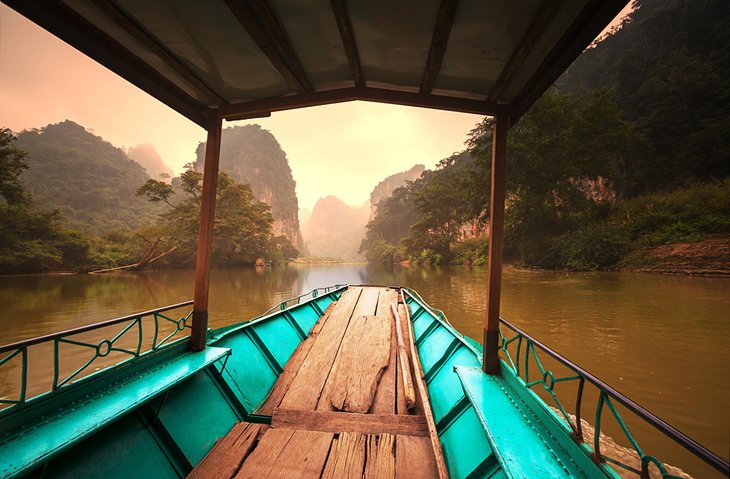
Tranquil Ba Be National Park is absolutely stunning with the three interlinked Ba Be Lakes at its heart, rimmed by jagged karst peaks and thickly forested slopes.
Most visitors come here to take peaceful boat trips or kayak on the lake and explore the caves full of stalactites and stalagmites in the vicinity, but for the more active, there's also excellent hiking and trekking in the hills here between ethnic minority villages.
This is one of the most peaceful spots in Vietnam, and travelers who spend the night here sleep in traditional stilt-house homestay accommodation along the lakeshore, allowing an experience of simple rural life.
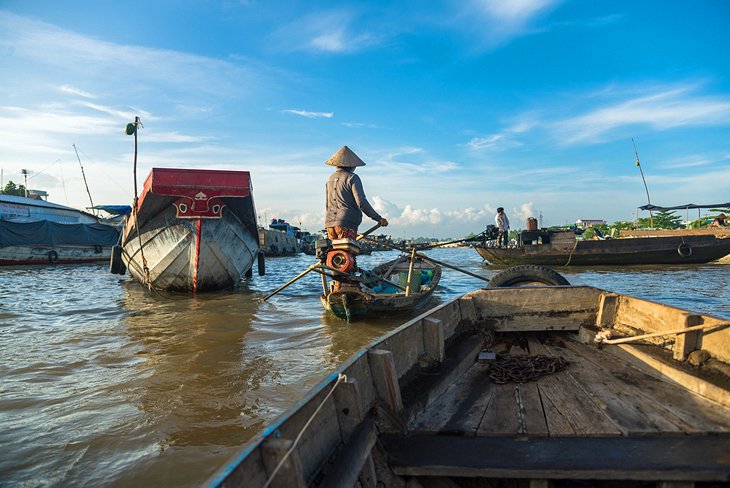
The far south of Vietnam is where the mighty Mekong River finally finds its way to the sea in a maze of waterways that crisscross the floodplain.
Incredibly lush, with paddy field vistas and mangroves, and full of local life, with chaotic floating markets to explore by boat, the delta is one of the most interesting regions for travelers to discover.
Can Tho is the most popular town to use as a base, as it's close to the floating markets of Phong Dien and Cai Rang, while boat trips from Ca Mau allow you to explore the U Minh Mangrove Forest and Cau Mau Nature Reserve.
This area of Vietnam is one of the best to visit for keen bird watchers and nature lovers , as it is home to both Tra Su Bird Sanctuary Forest and Bac Lieu Bird Sanctuary.
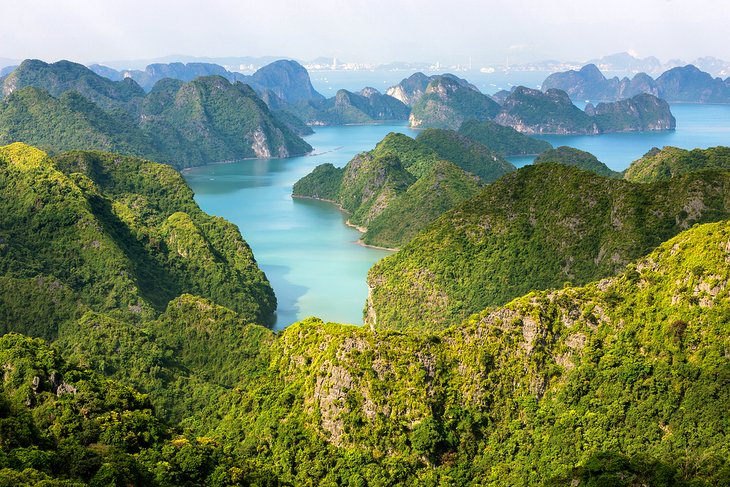
One of Vietnam's major centers for activities and adventure travel attractions, Cat Ba Island sits on the western edge of Halong Bay.
This is the best place to visit if you want to organize cruises and kayaking trips in Lan Ha Bay, which lies off Cat Ba's southern coast. Lan Ha Bay is a less visited seascape of karst islets and outcrops that makes for a quieter alternative to Halong Bay.
Off the water, much of Cat Ba's dense jungle interior is part of Cat Ba National Park, where hikers can spot plentiful birdlife, as well as animals such as macaques.
For many visitors, though, Cat Ba is all about climbing opportunities. Climbing excursions here utilize both the island's limestone cliffs and Lan Ha Bay's outcrops, providing experiences to suit both complete climbing beginners and experienced climbers.
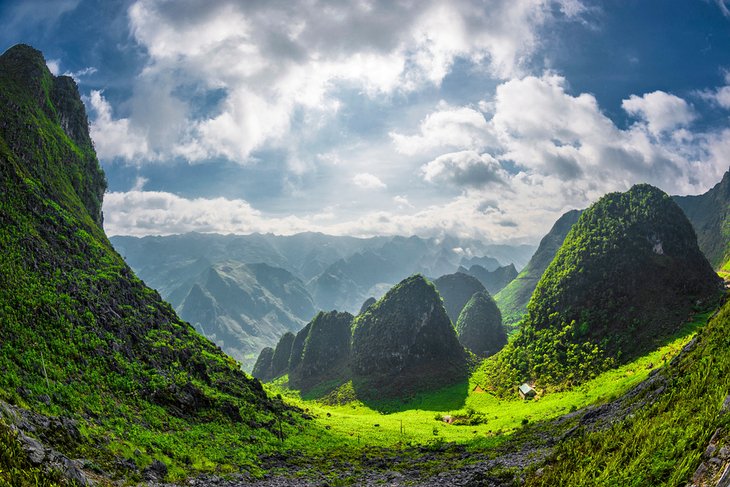
The emerald-green karst mountain landscapes along Ha Giang's mountain passes make this far-north province prime territory for scenic road-tripping by either motorbike or car.
In particular, the twisty Quan Ba Pass between Ha Giang town and Tam Son provides panoramic vistas of the karst plateau and its jagged limestone outcrops, while the zigzagging Mai Pi Leng Pass between Dong Van and Meo Vac offers dizzying views of the lush mountain scenery and narrow valleys below.
Time your visit to coincide with one of the area's market days, when traders from the surrounding mountain villages pile into town. Dong Van's Sunday market is one of the best.
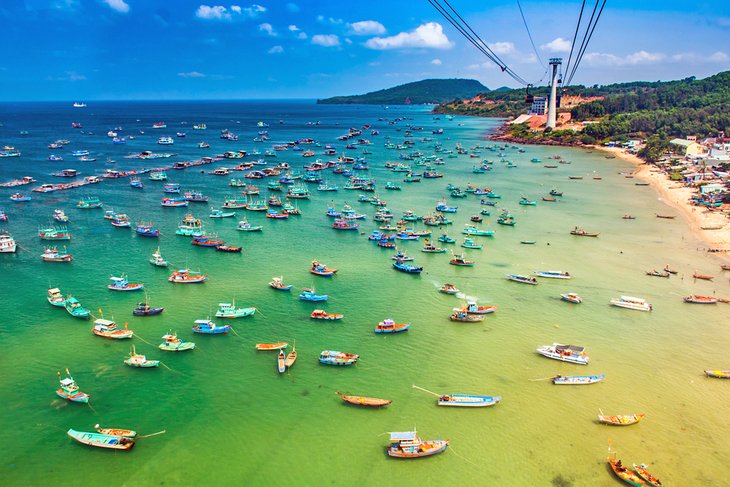
Sitting 45 kilometers off the southern coast of the country, in the Gulf of Thailand, Phu Quoc is a densely forested island, speckled by sweeps of white-sand beach that attract plenty of sunseekers during the winter dry season.
Dry season (November to May) is also when the island's underwater and on-the-water tourism attractions spring into action, with plenty of dive sites in the waters just offshore, as well as opportunities for snorkeling, kayaking, and boat trips.
Many of the main boat excursions head to the An Thoi Islands, just to the south of Phu Quoc, which is home to the best snorkeling in the area.
Off the water, the Phu Quoc cable-car provides bird's-eye views for eight kilometers, soaring over the seascape and islands, all the way from Phu Quoc to the island of Hon Thom in the An Thoi Islands.
Phu Quac is accessed by plane or regular ferries from the mainland towns of Rach Gia and Ha Tien. As Ha Tien lies very close to the southern border crossing with Cambodia, the island is a popular first (or last) stop-off in Vietnam for overland travelers.
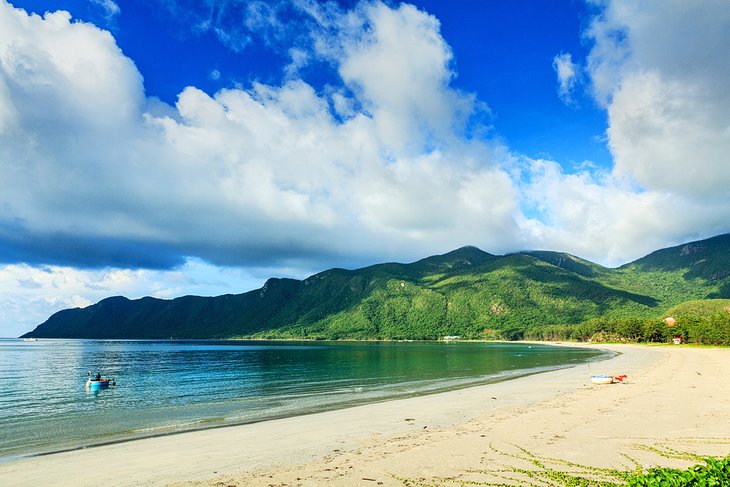
This remote island group lies around 160 kilometers offshore in the South China Sea and is renowned among divers as one of the best places to visit in the country, both for the variety of sea life and for the coral reefs.
Much of the Con Dao Islands, and the surrounding water, is a protected wilderness area, with the island shores home to nesting turtles, and dense forest still covering the island interiors.
The main island, and prime base for visitors with all the accommodation and things to do, is Con Son Island, which has sweeps of sand strung out across its coast that attract beachgoers looking for a relaxed sun-soaked getaway, as well as divers.
Even if you're here mostly for the beach, make sure to explore the historic sites of Con Son Town (the island's only settlement) including Phu Hai Prison, Bao Tang Con Dao Museum, and the prison known as the Tiger Cages, which document the dark history of this isolated island group.
Con Son's remote position led to the island being used to incarcerate political prisoners during the era Vietnam was occupied by French colonial forces, and later by both the South Vietnamese government and the occupying American forces.
Preserved sites including Phu Hai Prison and the prison cages used by the US forces, known as the Tiger Cages, along with Con Son Town's Bao Tang Con Dao Museum, do an excellent job of documenting this history for visitors.
Access to Con Son Island is either by flight from Ho Chi Minh City or by ferry from the coastal city of Vung Tau.
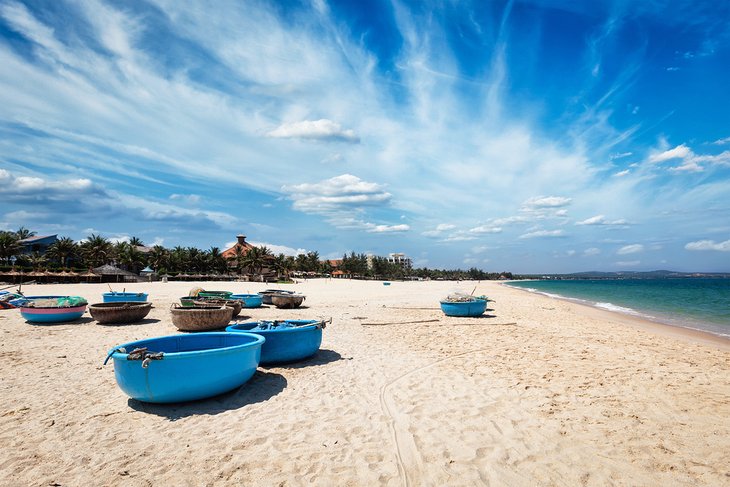
Once a sleepy coastal fishing town, Mui Né has developed into a beautiful beach resort town and a prime destination for windsurfing, sailing, and kitesurfing.
Compared to other beach destinations in Vietnam , however, Mui Né remains relatively unknown - and this means pristine beaches and a quiet retreat for most of the year.
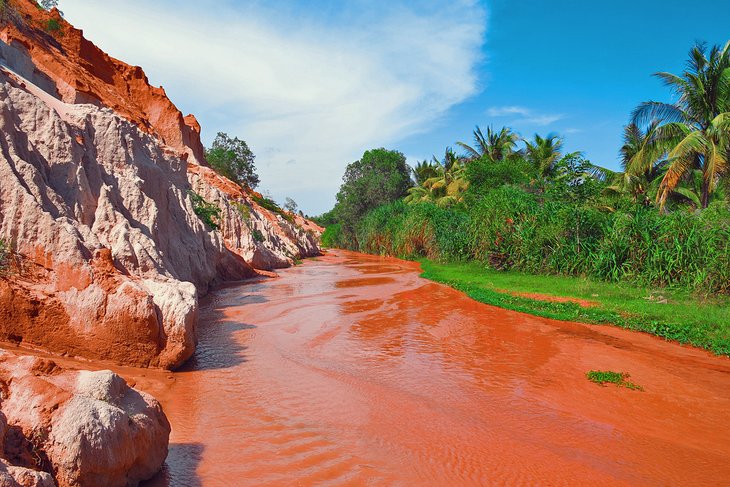
One of Mui Né's most unique attractions is the natural Red Sand Dunes just outside town, where visitors can practice sand-sledding or rent dune buggies for a more adrenaline-charged experience.
Tucked away between nearby fishing villages and towering orange limestone formations, there's the fairy stream, a slow-moving warm stream that almost feels like a walkway because it's so shallow - follow it to the end to reach a waterfall.
For those wishing to explore beyond the coastline, there are also the ruins of the Po Shanu Cham Towers - remnants of the Cham Empire that dominated the area many centuries ago.
Vietnam experiences strong monsoon seasons, where heavy rains hit the cities and the countryside, often causing floods and mudslides. If you're planning to travel around, the best time to visit Vietnam is during the dry season, which lasts from December to February – but there are some exceptions.
The south of Vietnam – where Ho Chi Minh city is located – experiences a more tropical climate, with high temperatures and high humidity year-round. Visiting these areas in the cooler months means less humidity and temperatures in the high 20s rather than the high 30s and 40s, which makes it more comfortable to walk around.
In the north, however, many areas experience an actual winter. Hanoi sees temperatures in the mid- to high teens in December and January – and in the mountains of Sapa in the north, you'll even get to see some snow during these months.
If you're visiting Danang for some beach time or to travel through the ancient town of Hoi An, it's best to arrive between February and May, when water and air temperature are in the 20s – perfect beach weather for enjoying the sand or a dip in the water. The rainy season, and especially the months of September and October, see very heavy rains and often very strong wind storms on the coast, so it's better to stay away from Danang during this time.

More on Vietnam
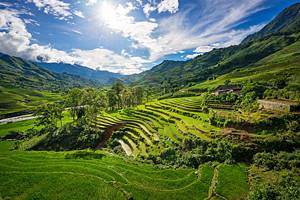

The Perfect Vietnam Itinerary for 1, 2, or 3 Weeks
- Last Updated: January 25, 2024
If you’re planning a trip to Vietnam for 1, 2, or 3 weeks then you must start with this post to help plan your Vietnam itinerary.
Vietnam has something for everyone. It’s bursting with history, delicious foods, hiking opportunities, beautiful landscapes, beaches, and of course the wonderful Vietnamese people.
Our Vietnam itinerary guide will give you an overview of the country, with some great itinerary options depending on how long you plan to visit.
We have something for everyone with:
- 10 days in Vietnam: Highlights Itinerary – These are the must-see places in Vietnam
- 1 week in Vietnam focusing on the North
- 1 week in Vietnam focusing on the South
- 2 weeks in Vietnam, by combining the two above
- 3 weeks in Vietnam, or longer, by adding our extended options to your itinerary.
READ MORE: Don’t miss our complete guide to travelling in Vietnam !
Table of Contents
Day 1 – Hanoi
Day 2 and 3 – halong bay, day 4 and 5 – sapa , day 6 and 7 – hue , day 8 – hoi an, day 9 and 10 – explore saigon, and take a full or half-day tour to the cu chi tunnels or the mekong delta, tour options, da nang , day 2 and 3 – ha long bay, day 4 and 5 – sapa, day 6 – hue, day 7 – hoi an, ninh binh (near hanoi), phong nha – ke bang national park (near hue), my son (near hoi an), ba be national park (near sapa), bach ma national park (between dan nang and hue), dong ha – for dmz tour (between dong hoi and da nang), day 1 – nha trang , day 2 – dalat , day 3 – mui ne , day 4 and 5 – ho chi minh city, day 6 and 7 – phu quoc island, cu chi tunnels or the mekong delta , con dao island, cat tien national park, did you find my vietnam itinerary helpful, 1, 2, and 3-week vietnam itinerary options .
We broke this Vietnam Itinerary into three main sections.
Simply decide how long you have, and use one of our itineraries to guide you to the top things to do in Vietnam!
10 Days in Vietnam Itinerary: Vietnam Highlights
Our 10 days in Vietnam itinerary will highlight the absolute best of North and South Vietnam – from hiking in Sapa , to sinking beer in lively Ho Chi Minh City (more commonly referred to by its former name, Saigon).
This can be the core of a longer 2 or 3-week journey by adding extension opportunities to it.
You can do this trip from North to South, or in reverse.
After flying into Hanoi, you’ll have one day to see this beautiful city, so get ready to hit the ground running.
Hanoi is the capital of Vietnam and is full of beautiful architecture, culture, and unique food. The old city is surrounded by remnants of fortified walls, and most things you will want to visit are in the Old Quarter.
I would suggest finding a walking tour, so you can learn about the city’s history as you explore the city.
Take a stroll around the Hoàn Kiếm Lake and visit the Temple of the Jade Moutain, and stop to help the locals practice their English.
Try the local beer called Bia hơi or fresh beer, which is brewed fresh each morning, and doesn’t contain any preservatives.
One of the best things to do in Hanoi is to have an egg coffee while sitting at a café in Hanoi’s Train Street.
Then get ready to get out of the way when the train rattles past, so close to you that it takes your breath away!
For dinner, don’t forget to have a regional specialty, called Bun Cha. It’s found all through the old quarter, so you won’t have to go far to find it.
Where to stay in Hanoi: We recommend staying right in the Old Quarter.
READ MORE: Learn more about what to do in Hanoi with our Hanoi city guide .
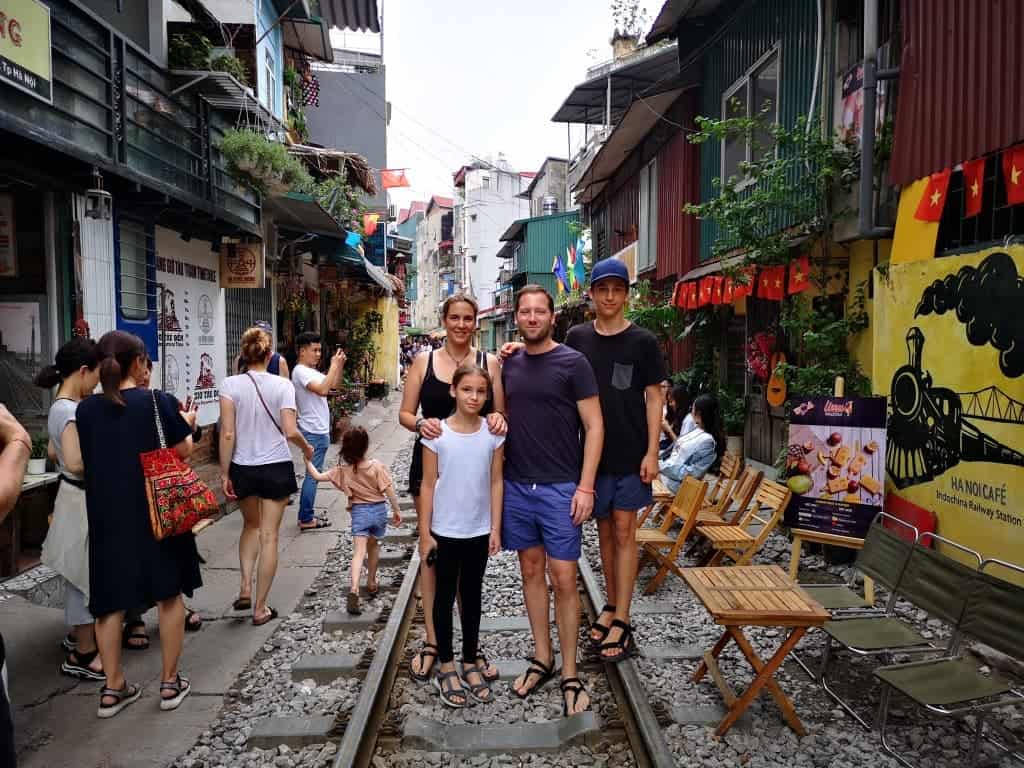
Halong Bay is a UNESCO World Heritage Site , and is one of the most popular things to see in Vietnam.
The stunning bay is full of thousands of limestone islands, pristine beaches, caves, and floating villages. The Vietnamese call it The Bay of the Descending Dragons.
One of the best ways to visit the islands is by boat.
You can take one of the many cruises on offer from the tour operators in town, taking you from Hanoi to Halong Bay, spending a night onboard a boat, and returning you to Hanoi the following day.
Alternatively, make your own way to Halong Bay, and arrange a boat from there.
Halong Bay cruise options vary depending on your budget.
The cruises normally include kayaking, stand up paddleboarding, swimming, visiting floating villages, and exploring caves.
If you find the Halong Bay cruises a little out of your budget, check out this guide to Halong Bay on a budget .
Where to stay in Ha Long Bay: Spend the first night at Halong bay, preferably on board a junk boat. Alternatively, spend the night on Cat Ba Island . Return to Hanoi, and spend the second night there, ready to head to Sapa in the morning.
After a restful night in Hanoi after your cruise, and having enjoyed some more Bun Cha and fresh beer, it’s time to get on a bus from Hanoi to Sapa.
You can also travel by train if you prefer, but buses are the fastest and the best way to get to Sapa from Hanoi.
Alternatively, you can hire a private car, which will get you there faster, but at considerably more expensive.
Sapa is a region in Vietnam’s northwest and is home to beautiful terraced rice fields, great trekking, and exquisite vistas.
Sapa has some of the best trekking in Vietnam .
You can navigate some of these hikes yourself, arrange a private guide, or organize one of the many tours, either from Hanoi or in Sapa itself.
The most popular attraction in Sapa is the highest mountain in the region, Fan Si Pan .
But unless you take the cable car to the top, you’ll need more time in the area for this hike.
Some of the shorter day hikes are Cat Cat, and Tả Phìn , which can be done with or without a guide.
Where to stay in Sapa: Spend two nights in Sapa. Consider a mountain lodge for the true Sapa experience, and then hop on the bus back to Hanoi early the following day. Then fly from Hanoi to Hue. If you would prefer not to fly, you can take an overnight train or bus from Hanoi to Hue instead, arriving in the morning of Day 7.
Hue is the old Imperial City, and is where the Nguyen Dynasty held the throne for 143 years.
The last Emperor, Bao Dai, abdicated his throne and power passed to Ho Chi Minh.
During the American War, the North Vietnamese Army captured Hue as part of the Tet Offensive.
Thus began a battle to regain the Imperial city by the South Vietnamese and the Americans, which lasted almost a month with thousands dead, and the city was mostly destroyed.
After spending the previous night in Hue, or arriving in the morning by bus or train, visit the Old City with its pavilions, beautiful temples, and the Royal Palace , all protected by high walls, exquisite gates, and moats.
Hue is also known for the tombs of the Ancient Emperors. They are all intricate and beautiful.
But don’t miss the Tomb of Tu Duc , or a visit to Tu Hieu Pagoda , which dates back to 1843.
One of the last things to do in Hue is to try the famous Bún Bò Huế , a local noodle dish with beef and chili oil, washed down with fresh beer.
Where to stay in Hue: Spend another night in Hue, then head off early on Day 8 to Hoi An. The most spectacular way is on a motorbike tour through the Hai Van Pass. The operators will take you on the back of a motorbike, and deliver both you and your luggage to your hotel in Hoi An.
Alternatively, you can take a private car or bus.
READ MORE: Learn more about what to do in Hue with our Hue city guide .
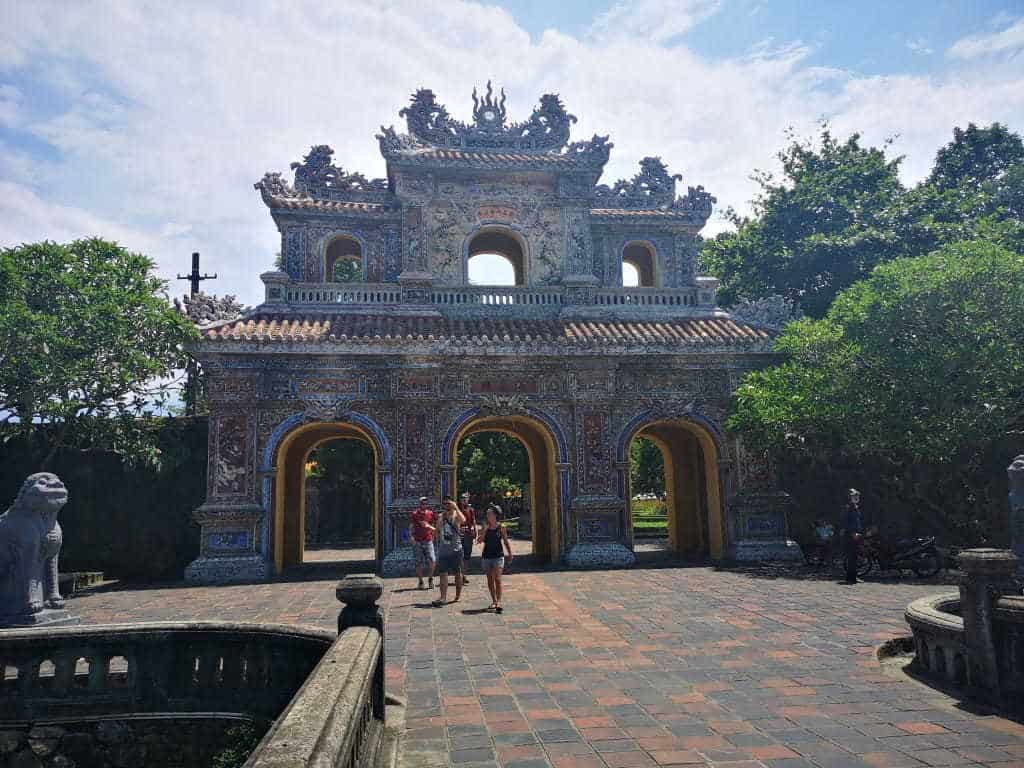
Explore the beautiful city, and enjoy some rest and relaxation at the beach, sitting on beach chairs and drinking cold coconuts.
The old town is simply stunning. As you walk around you’ll pass stores selling little souvenirs, great restaurants, and lots of clothes.
Hoi An is the place to be if you want to have some clothes made. Tailors are everywhere, and prices are affordable.
Make sure to head out into town at night, as the city lights up with hanging lanterns, and comes alive with markets, street food, and people.
While out and about visit the wooden Japanese Covered Bridge from the 18 th Century, and take a boat ride up the river to get a better view of the lights.
Use Grab or take a taxi or scooter and head to the beach. You can sit at one of the many restaurants, use their lounge chairs and stay all afternoon soaking up the sun!
Where to stay in Hoi An: Spend the night in Hoi An, and fly from nearby Da Nang to Ho Chi Minh City the next morning.
READ MORE: Add these things to do in Hoi An to your itinerary !
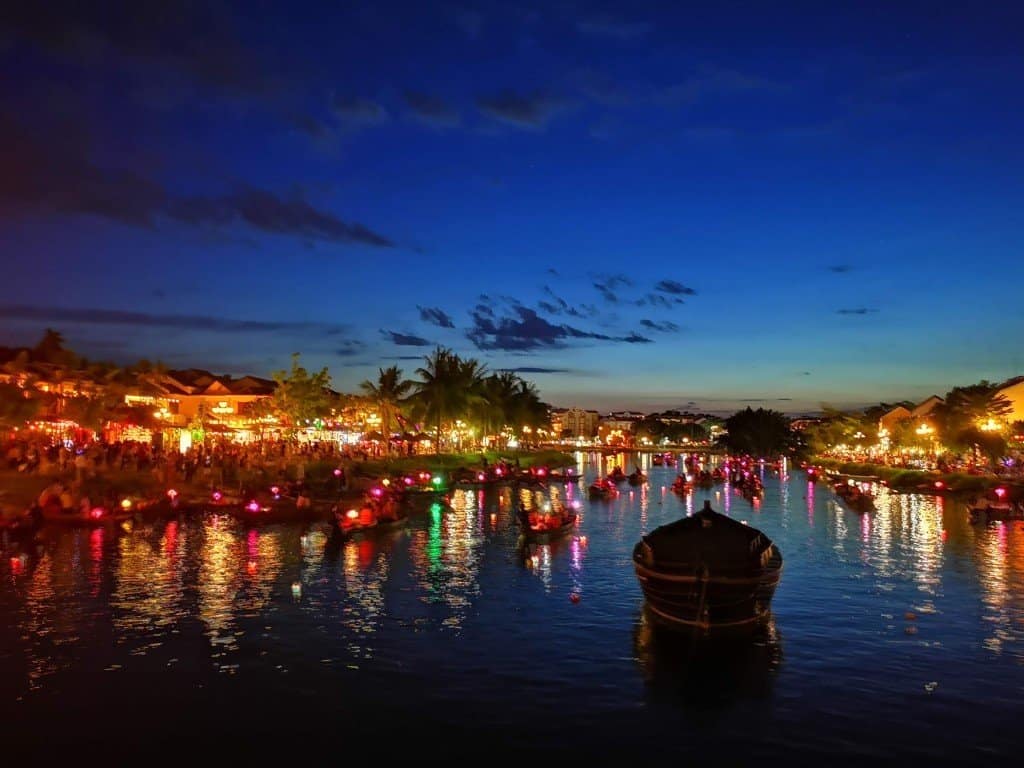
After experiencing incredible Hoi An, it’s time for one last big effort as we reach the home stretch of our 10-day itinerary.
Our time allows for one of two tour options, or if you have an extra day, both.
Vietnam’s largest city, Ho Chi Minh, is a bustling array of buildings, people, food and scooters!
Saigon is where a lot of ex-pats live as it offers so much variety and, like New York, the city never sleeps!
These are your last couple of days in Vietnam, and there is plenty to see. The Vietnam War Museum, Notre Dame (yes they have one too!), the beautiful Central Post Office, and Independence Palace are all must-see destinations while in HCMC.
One of the things to do in Ho Chi Minh City is to head to Bui Ven Walking Street , where all the action happens.
After dark, this street is packed with people sitting at small plastic tables and chairs sinking beers, eating street food, and people-watching.
After a few beers and some food, head back to your hotel and get some rest before your flight home.
READ MORE: Consider these 8 day trips from Ho Chi Minh City .
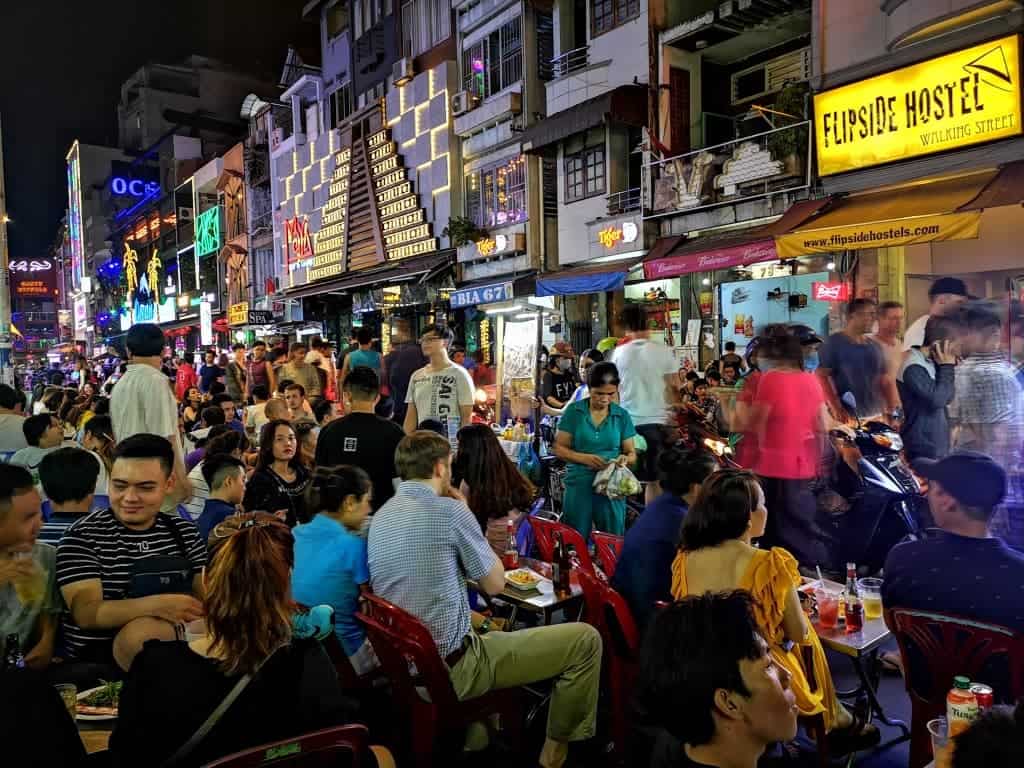
The Cu Chi Tunnels
Even if you’re not particularly interested in Vietnam’s war history, this is an interesting place to visit.
There are two different locations, Ben Dinh and Ben Doc .
Most tour companies usually head to the one closest to the city, Ben Dinh, which is also the largest.
The Tunnels offer an interesting insight into what it was like for the people fighting in the Vietnam/American War, their living conditions, and how they used the tunnels to hide underground during the day and fight the enemy at night.
Today you can go into some of the tunnels, which have been widened for westerners to fit in.
You can only visit the tunnels with a guide, which is provided as part of the entry ticket or part of your tour .
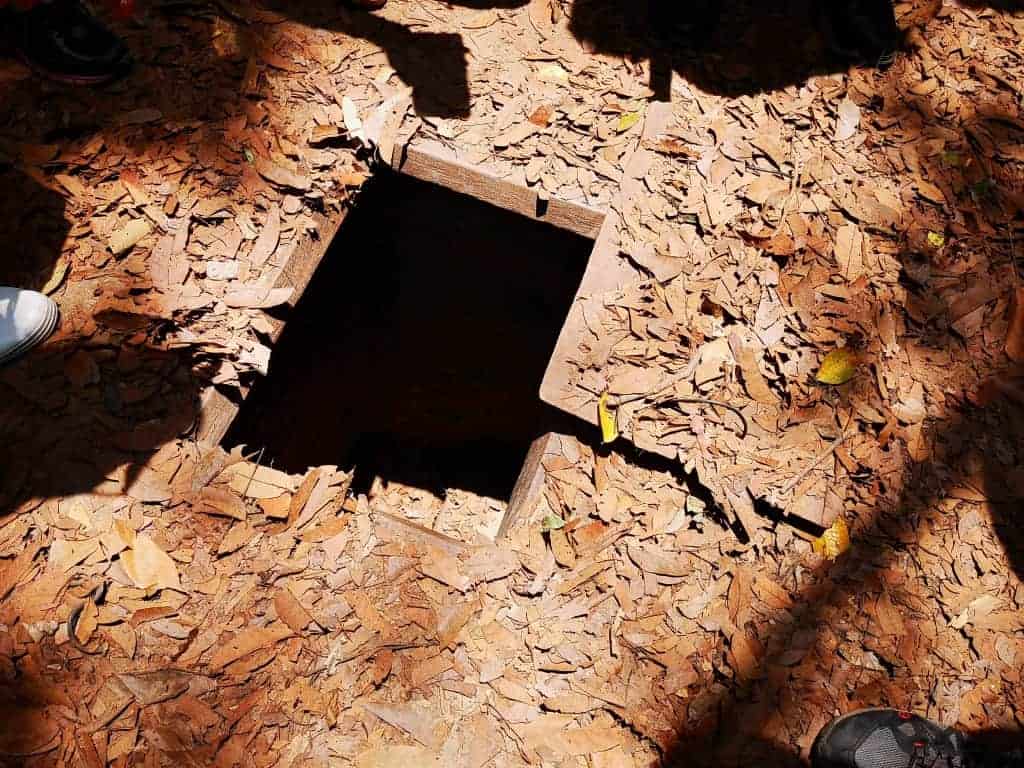
The Mekong Delta Tour
If small little tunnels aren’t your thing and you would prefer to take a pleasant boat ride down the Mekong river instead, there are half-day tours available from Ho Chi Minh City to the Mekong Delta.
Mekong Delta tours usually include exploring small canals by a sampan boat, visiting villages and islands, sampling exotic fruit and touring a coconut candy farm. Yum!
Where to stay in Ho Chi Minh City: For your two nights in Saigon, stay in District 1 to be right in the middle of everything, District 3 if you’d like a more relaxed stay that’s still only moments away from the action or District 4 for a real local experience.
Extension Option
If you’re able to extend your tour to 2 weeks in Vietnam, you’ll have more time for these excursions. Any 2 week Vietnam itinerary should include these!
Da Nang has lots to offer . If you are comfortable on a scooter or motorbike, you can ride from Hue to Da Nang (before going to Hoi An), through the Hai Van Pass .
This route used to be a little dangerous due to all the cars and trucks using the pass.
But since they have built the new freeway and tunnel there is very little traffic, making it a very enjoyable and incredibly scenic ride.
The best way to do this is by motorbike tour from Hue, to either Da Nang or to Hoi An, or in reverse.
Setting out from Da Nang, Ba Na Hills is a scooter ride away. You may recognize the bridge seemingly held up by two large hands.
Between Da Nang and Hoi An lies Marble Mountain , and to the east of Da Nang there’s a large Buddhist temple complex and pagoda called Chua Linh Ung .
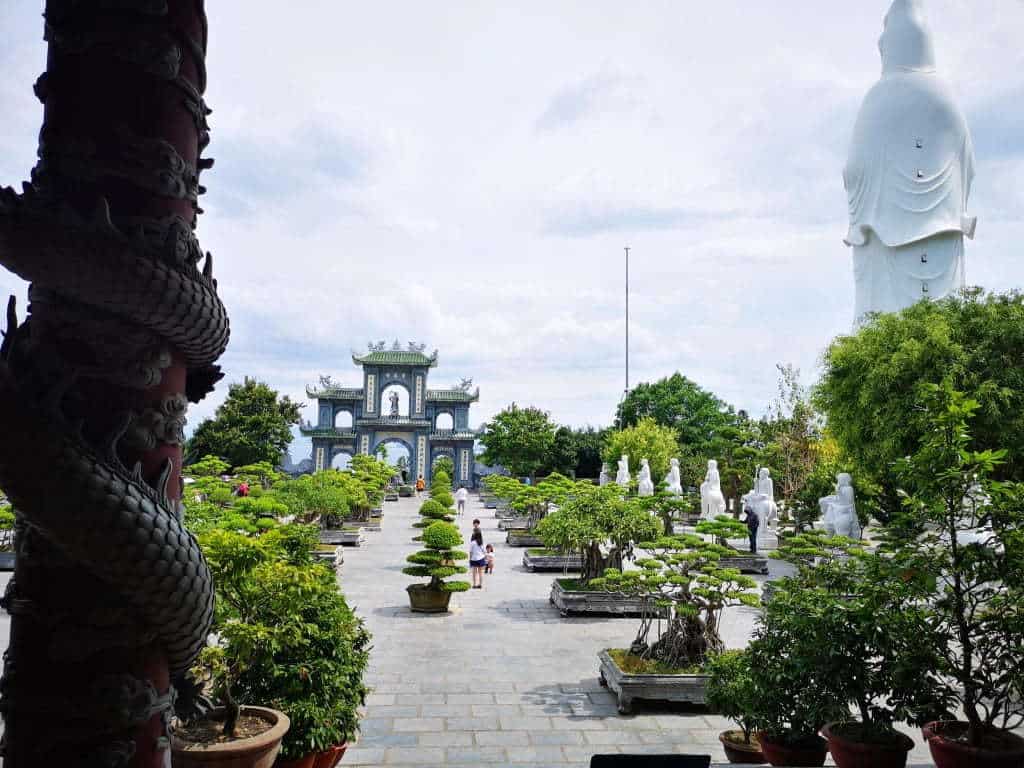
If you have longer in Vietnam and would like to explore more of this beautiful country, combine our North and South options below to create a 2 weeks in Vietnam itinerary.
2 Week Vietnam Itinerary – 1 Week in the North
Start your 2 weeks in Vietnam in Hanoi, Vietnam’s capital city, with beautiful architecture, culture, and food.
While in Hanoi don’t forget to try egg coffee, fresh beer (Bia hơi), and especially the regional dish of Hanoi, Bun Cha . (See Above 10-day Vietnam Itinerary)

Where to stay in Hanoi: Spend the night in Hanoi. We recommend staying right in the Old Quarter.
Ha Long Bay, with its beautiful limestone islands, is on the UNESCO World Heritage List.
It’s a must-see while in Vietnam, with an overnight boat tour to the islands, and other fun activities like SUPing, kayaking, and exploring caves.
The easiest way to see Ha Long Bay is to organize a tour from Hanoi . (See Above 10-day Vietnam Itinerary)
Where to stay in Ha Long Bay: Spend the first night at Ha Long Bay, preferably on board a junk boat. Alternatively, spend the night on Cat Ba Island . Return to Hanoi, and spend the second night there, ready to head to Sapa in the morning.
Think of beautiful rice terraces set high up in the mountains, trekking, and staying in mountain lodges.
Sapa is located in the northwest part of the country, and best seen by a two-day tour from Hanoi. (See Above 10-day Vietnam Itinerary)
Where to stay in Sapa: Spend two nights in Sapa. Consider a mountain lodge for the true Sapa experience, and then hop on the bus back to Hanoi early the following day. Then fly from Hanoi to Hue.
If you would prefer not to fly, you can take an overnight train or bus from Hanoi to Hue instead, arriving in the morning of Day 7.
The old imperial city still has many secrets to uncover.
Hidden behind towering walls and large gates, you can explore where the last Emperor ruled from before abdicating his rule in favor of Ho Chi Minh.
This is where the North Vietnamese overtook the city, sparking a battle that lasted for almost a month in what was known as the Tet Offensive. (See Above 10-day Vietnam Itinerary)
Where to stay in Hue: Spend the night in town. Leave your bags at your hotel while you explore the city the next morning, then head to Hoi An after lunch.
The most spectacular way is on a motorbike tour through the Hai Van Pass . The operators will take you on the back of a motorbike, and deliver both you and your luggage to your hotel in Hoi An.
Head to the beach during the day and relax on one of the many lounge chairs offered by the restaurants lining the foreshore of Central Vietnam.
In the evening enjoy the magical old town that comes alive at night with lights, markets, food, and more! (See Above 10-day Vietnam Itinerary)
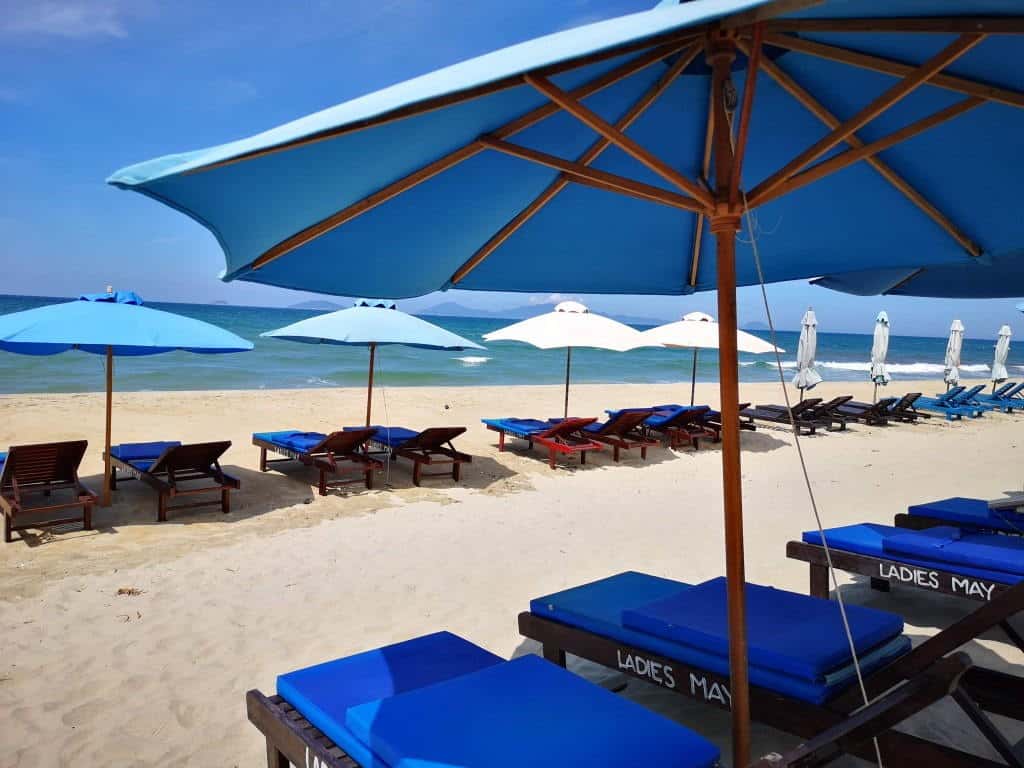
Where to stay in Hoi An: Spend the night in Hoi An, and fly from nearby Da Nang to Ho Chi Minh City, or head to Nha Trang to link up with the Southern Vietnam Itinerary below.
READ MORE: Add these things to do in Hoi An to your 2 week Vietnam itinerary!
Extension Options
If you want more time in the north during your 2 week Vietnam itinerary, add on these trips such as Ninh Binh and some cool national parks.
Considered the inland version of Halong Bay, Ninh Binh is best seen by boat, on a pushbike, or scooter.
We spent two full days in Ninh Binh and enjoyed a pushbike ride in the surrounding area.
We then hired a scooter in Ninh Binh and set out to see more of the beautiful lush hills, taking a boat ride through Tam Coc, and visiting pagodas.
You can easily book an awesome 2-day, 1-night tour of Ninh Binh from Hanoi if you’re not comfortable riding a scooter in the crazy Vietnam traffic.
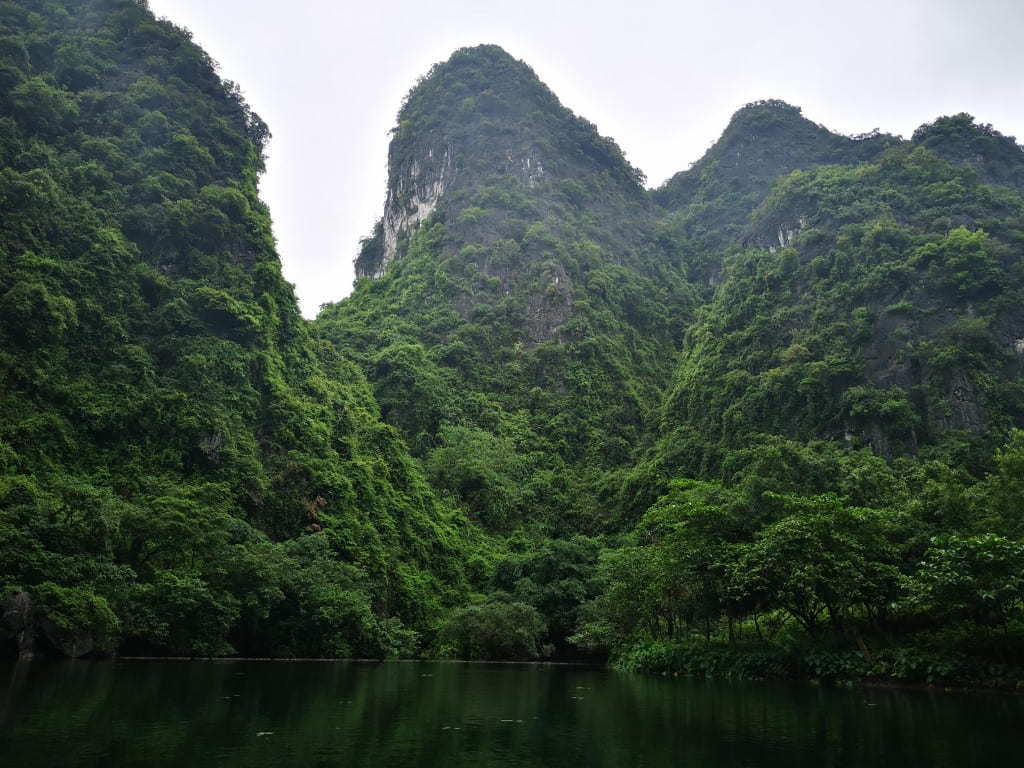
Phong Nha – Ke Bang National Park is home to over 300 caves and grottoes. This UNESCO World Heritage Site protects the oldest karst system in Vietnam.
It comprises of a precious ecosystem, limestone forest, and the world’s largest cave, Son Doong .
The park offers eco-tourism, mountain climbing, trekking, flora and fauna, and caving.
Some of this can be done independently, but tours are often the best option to get the most out of your time.
The My Son ruins are another important UNESCO World Heritage site in central Vietnam.
This temple complex was built by the Champas during their rule, and was influenced by Hinduism.
The ruins of the brick temples and sculptures are often likened to Angkor Wat in Cambodia or Bagan in Myanmar.
Book a tour of My Son to make the most of your experience.
Ba Be Lake is the centre of the National Park, and of the Ba Be Lake legend.
People believe that the lake was formed by an enchantress, who cursed the people of the surrounding area for not showing compassion to her when she asked for help.
Legends aside, Ba Be Lake offers a wide range of activities, from trekking, kayaking, motor-biking, waterfalls, caves, and the natural beauty and diversity of the area.
The highest point of Bach Ma National Park is the 1450m high mountain of the same name.
The park is known for its biodiversity, with lots of birds, flora, mammals, and primates.
The government finally protected the area in 1962, after the area was greatly damaged due to the use of agent orange during the Vietnam War.
The area is now safe for people to explore and is best seen with a tour guide .
You can hike the Five Lakes Cascade Trail taking in the waterfalls, visit the monastery, and hike the Pheasant Trail .
A visit to the demilitarized zone (DMZ), is a great one-day outing for history buffs.
The DMZ area was the dividing line between North and South Vietnam during the war, and as a result, saw heavy fighting.
The tour explains the extent of the fighting in this area, and the importance of the location in the Vietnam War.
2 Week Vietnam Itinerary – 1 Week in the South
Next on your 2 weeks in Vietnam, spend 1 week in the south of Vietnam. You could easily spend 2 weeks in Vietnam in just the north or the south, but you can also spread out your time between both areas.
Our Southern itinerary begins in Nha Trang. Either fly there from Saigon or Hanoi, or take a bus down from Hoi An if you’re continuing on from our Northern Itinerary.
Nha Trang is the most famous seaside resort in Vietnam and is known for its white-sand beaches, coastal islands, and clear waters with abundant marine life, making it perfect for scuba diving and snorkelling.
The town itself also offers interesting cultural sites close by, and places where you can pamper yourself with a mud-bath, or enjoy a seafood dinner.
Where to stay in Nha Trang: Spend a night in Nha Trang, and take a bus or private car to Dalat the next morning.
After a relaxing time on the beach, it’s time to get some more culture in during your 2 week Vietnam itinerary!
Dalat is heavily influenced by the colonial period from the French occupation, as the French built their holiday homes here to take advantage of the temperate weather.
With beautiful buildings, gardens, interesting architecture, coffee and tea plantation tours, waterfalls, mountain biking, hiking, and canyoning , you don’t want to miss out on this city!
Where to stay in Dalat: Spend the night in Dalat, and take a bus or private car to Mui Ne the next morning.
READ MORE: Learn more about what to do in Dalat with our Dalat city guide .
Three main things are offered in this beautiful resort destination; relaxation, watersports, and sand dunes.
Mui Ne beach is dotted with resorts, hotels, and hostels, and is a great place to just sit and enjoy your surroundings.
Although Mui Ne is more than just the beach, this area is set up for tourists and has one main street of shops, cafes, bars, and shopping.
Being a beach town, watersports are a big thing here, and just about everything is on offer from kitesurfing to parasailing.
The Mui Ne sand dunes are popular, and a spectacular sight.
There are two locations, the smaller, closer, red sand dunes, and the white sand dunes about 26km from town.
Tours are available for both locations and you can also hire dune buggies, or go sledding!
Where to stay in Mui Ne: Spend a night in Mui Ne, then shake the sand from your belongings and take a bus or the train to Ho Chi Minh City (Saigon) the next morning.
There’s so much to see and experience in this historic city, including day tours to some pretty important locations, that you’ll need two days .
On the first day, you’ll head out into Ho Chi Minh City. It has some great cultural sites, like the Vietnam War Museum, Independence Palace, Notre Dame, and it also boasts some pretty great nightlife too.
For the second day, we suggest you head out of the city on a day tour. There are two great options: The Chu Chi Tunnels, or a trip to the Mekong Delta. (See Above 10-day Vietnam Itinerary)
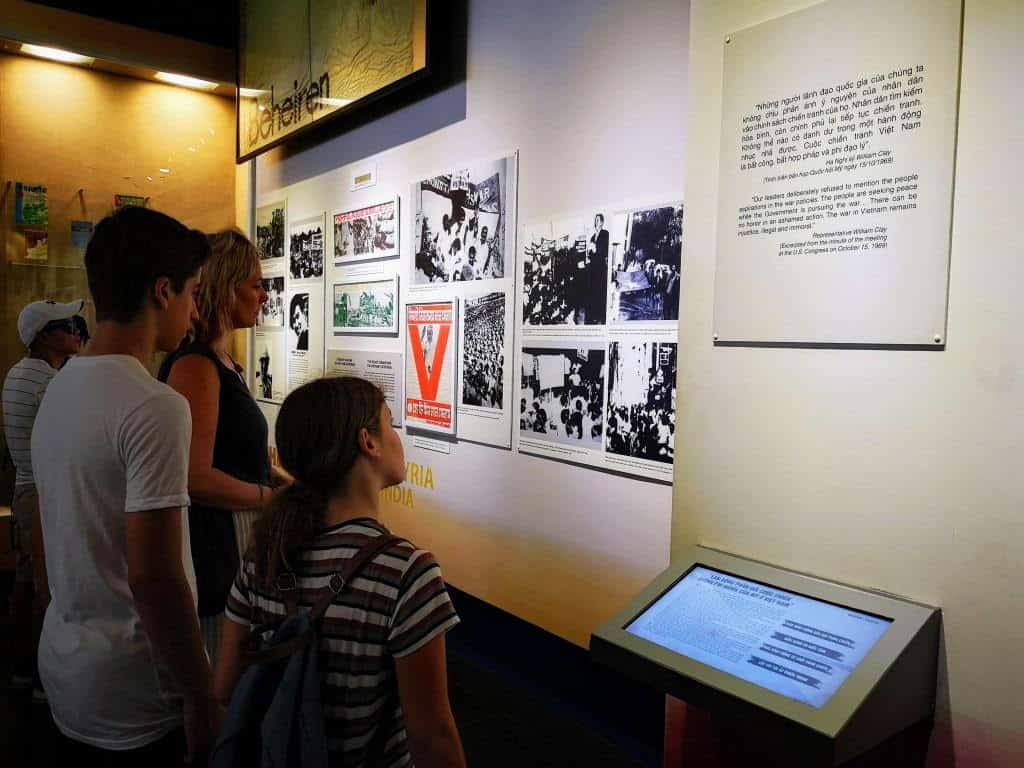
Where to stay in Ho Chi Minh City: For your two nights in Saigon, stay in District 1 to be right in the middle of everything, District 3 if you’d like a more relaxed stay that’s still only moments away from the action or District 4 for a real local experience. Fly to Phu Quoc Island on Day 6.
Phu Quoc is a small island off the coast of Cambodia, lined with white sand beaches and palm trees.
There are many resorts along the southwest coast providing you with ample opportunity for some relaxation time, while you swim, and eat your last fill of tasty Vietnamese food.
Phu Quoc island is home to mountains, tropical rainforest, hiking and wildlife, all within its National Park.
Lots of tours are available to explore the island which offers snorkelling as well, or you can hire a scooter and set off by yourself.
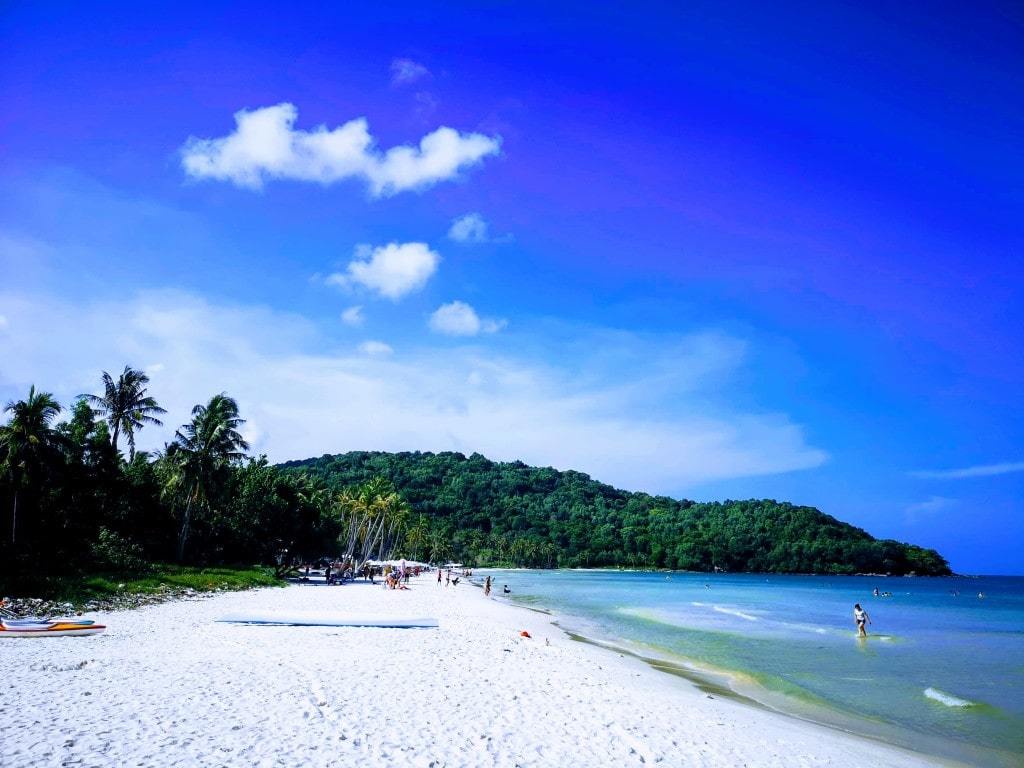
Where to stay in Phu Quoc Island: Spend two relaxing nights on Phu Quoc Island, then fly back to Saigon to catch your onward flight!
If you have more time to spend during your 2 weeks in Vietnam, take the ferry to the mainland, and continue overland to some of the extension options listed below, or to Cambodia.
If you have more time for your 2 week Vietnam itinerary, or you want to further explore one area rather than hopping around, here are some ideas!
Depending on what you did in 7 days for our Southern Vietnam Itinerary, if you have time you might like to see the other option best explored out of Ho Chi Minh City. (See Above 10-day Vietnam Itinerary)
During the French occupation, and later the Saigon regime, this island was used to house political prisoners and prisoners that were considered especially dangerous.
Aside from its harrowing past, the island is known for its natural beauty with over 80% of the island being a National Park.
These days the island is frequented for its spectacular snorkelling and diving, with abundant coral reefs, beautiful beaches, and hidden lagoons.
Can Tho is the de facto capital of the delta region and an unassuming city full of life.
Most of the activity happens around the pier where you can enjoy great food and cold beer.
Boat rides are available to show you more of the city and surrounding area, and visit some early-morning markets.
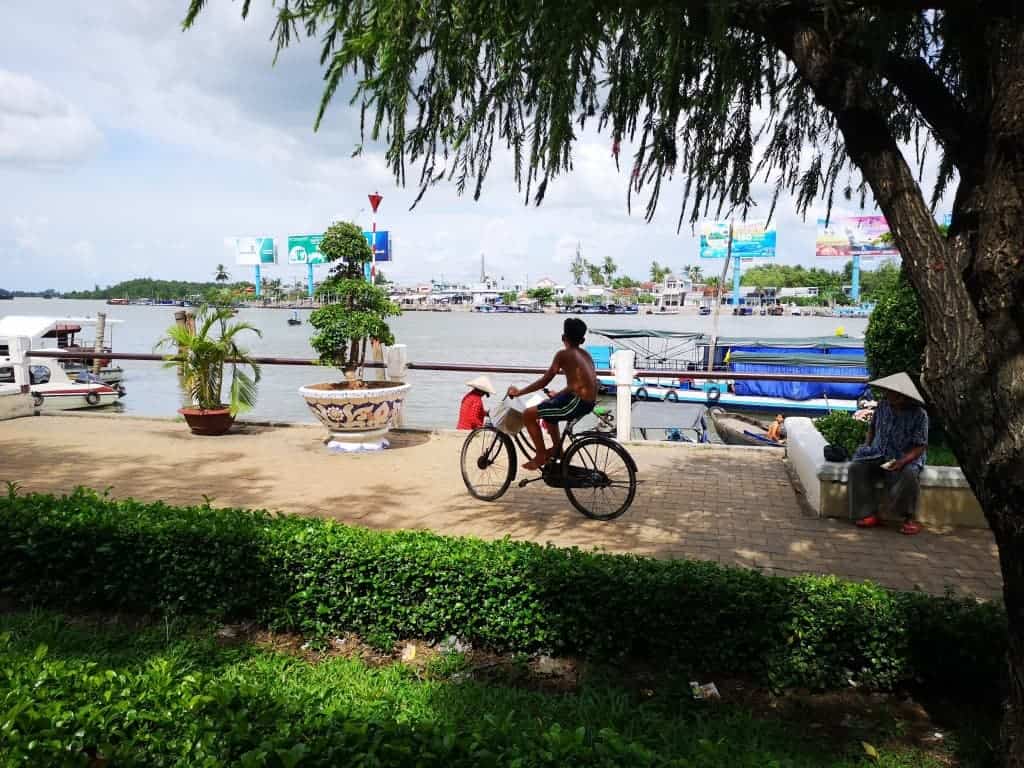
If you’d like a little break from the tourists and are looking to just relax and hang out with the locals, Qui Nhon is the place to come .
Unspoiled by tourism, this sleepy town has squeaky white sand beaches, snorkeling, swimming, temples, and museums.
Cat Tien National Park is comprised of two sections Cat Loc, and Nam Cat Tien, the former being the most visited of the two.
The river by Nam Cat Tien houses an important Hindu archaeological site and temple, where a large number of artifacts have been uncovered and are now in the Dalat museum.
The national park has spectacular flora and fauna and trekking.
READ MORE: 33 amazing things to do in Vietnam !
Vietnam is a large and diverse country, with a great deal to offer the traveller who goes in with an open mind and heart.
While we’ve listed what we feel are the main highlights, there is much more to be explored when you visit Vietnam.
Friendly people really make Vietnam a special place to visit.
The itineraries listed above are a bare minimum if you need to get the most out of a short amount of time.
While doable, if possible it would be a much more relaxing trip if you could pad it out by adding a few days to your Vietnam itinerary, and slow down a little!
We hope you have a wonderful time there!
DISCLAIMER: Some of the links in this article are affiliate links, which means if you book accommodation, tours or buy a product, we will receive a small commission at no extra cost to you. These commissions help us keep creating more free travel content to help people plan their holidays and adventures. We only recommend the best accommodations, tours and products that ourselves or our fantastic editorial team have personally experienced, and regularly review these. Thanks for your support, kind friend!
Hi, We’re Alesha and Jarryd!

We’ve been traveling the world together since 2008, searching for the planet’s best destinations and adventures.
Love Travel?
Sign up for our free weekly newsletter for the best travel tips, ideas and deals!
We respect your privacy. Unsubscribe at any time.
READ MORE...
25 BEST Things to Do in Hue, Vietnam (2024 Edition)
Canyoning In Dalat – What It Is Really Like
A First-Timer’s Guide to Trekking in Sapa
Related Posts
Getting your vietnam visa in phnom penh, cambodia, northern vietnam motorcycle adventure, the perfect 3 days in hanoi itinerary [2024 guide], dear phong nha…we love you – a photo essay, 1 thought on “the perfect vietnam itinerary for 1, 2, or 3 weeks”.
Hi, I was wondering how much the 10 day option costs roughly in AUD? Cheers!
Leave a comment Cancel reply
Save my name, email, and website in this browser for the next time I comment.
- Be Inspired
- Destinations
- Things to do
- Eat & Drink

10 Best Places to Visit in Vietnam in 2022
Coming to the S-shaped country, you can admire the poetic and charming scenery wherever you go. The natural beauty and unique culture have made Vietnam become a tourist destination worldwide. Here are the top 10 places to visit in Vietnam nominated in 2022.
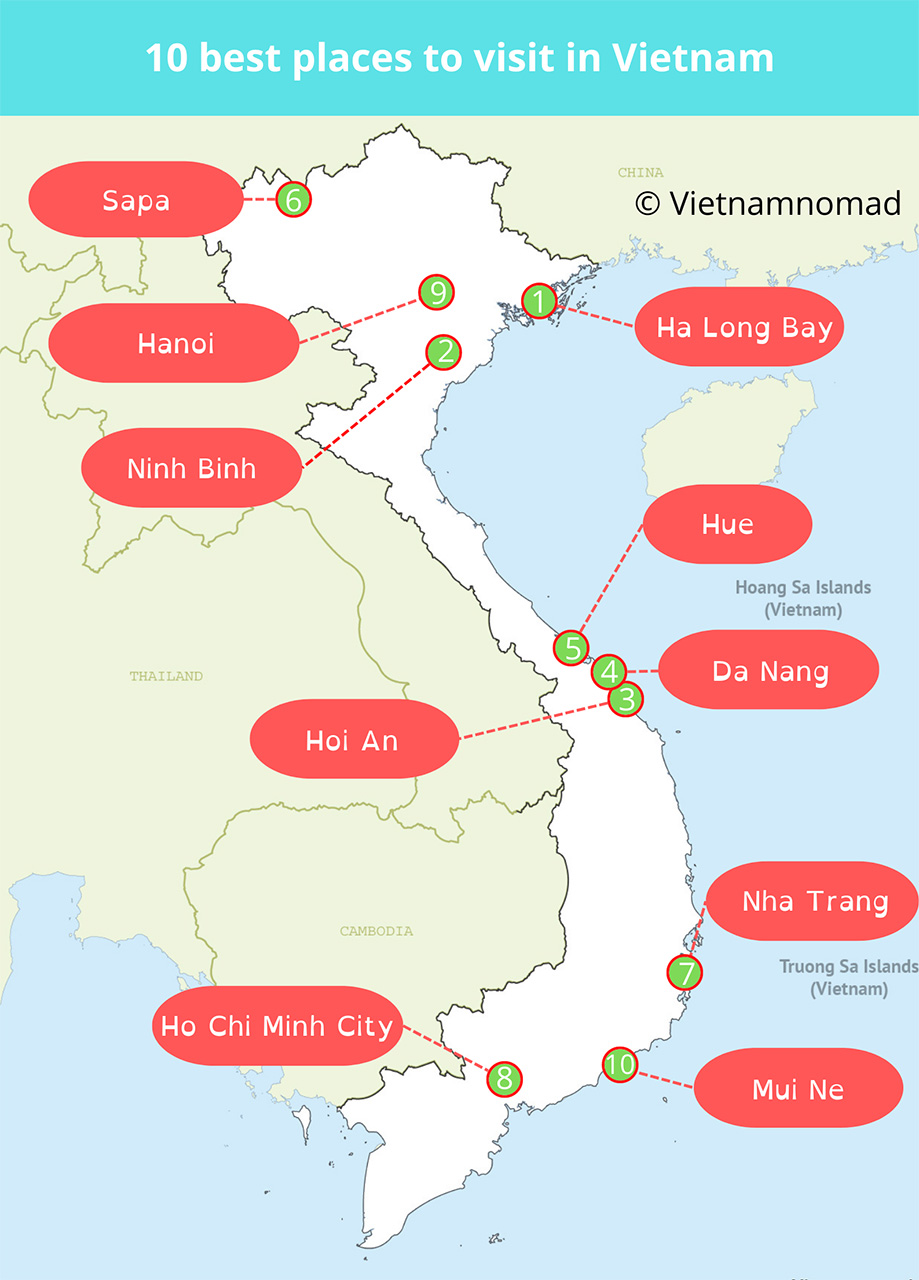
1. Ha Long Bay
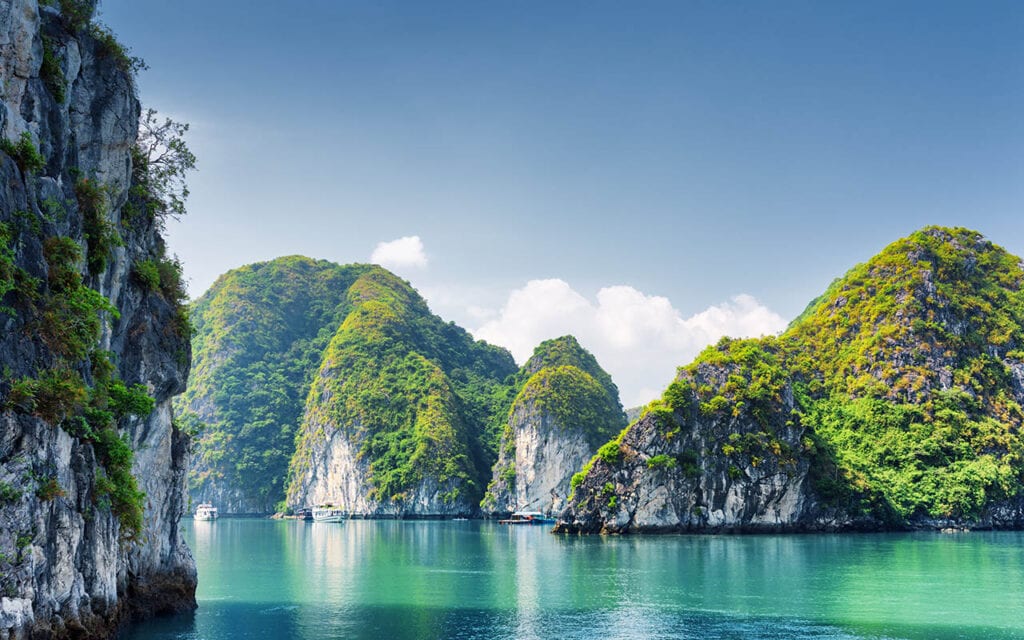
Off Northeast Vietnam , Ha Long Bay was designated as one of the World Heritage Sites in 1994. For many reasons, Ha Long Bay has to be on your list when you travel to Vietnam.
Having been known for thousands of limestone islands that emerged from the emerald water, the bay is surrounded by a spectacular seascape. You will want to sign up for a boat trip to cruise along the maze of channels and uniquely shaped islets. You can also go kayaking and caving to experience the enchanting beauty of this wonderland.
Although it can get very touristy during the high season, with what it has to offer, Ha Long Bay is totally worth your visit.
The best time to visit Ha Long Bay is in the summer (May – October) when its weather is warm, less rain, convenient for outdoor activities and exploring.
2. Ninh Binh

Used to be one of the hidden gems in the north of Vietnam, Ninh Binh has become more and more popular among both local and foreign visitors after being chosen as the blockbuster Kong’s filming location. But Ninh Binh is not all about that.
This is home of one of the biggest temples in South East Asia (Bai Dinh Pagoda), which is solemnly situated amid the lush paddy fields and breathtaking rock formations. The best way to explore the renowned landscape complex is by rowboat to bit-by-bit take in the majestic and poetic scenery. Ninh Binh will truly give you a sense of the spiritual calmness coming from the splashing water under your boat and distant temple bells echoing.
You can visit Ninh Binh at any time of the year, each season in Ninh Binh has a unique beauty that is nowhere to be found.
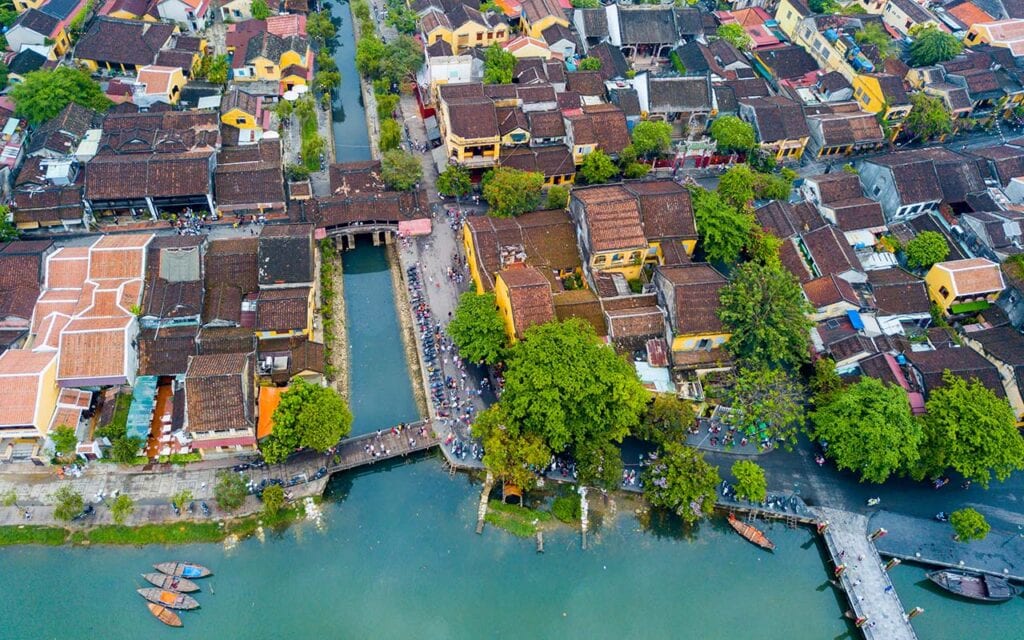
Noted as another World Heritage Site of the long-stretching nation, the Ancient Town of Hoi An carries not only the diversity of settings but also the history of hundreds of years of cultural interference between the three countries of China, Japan, and Vietnam. You will need to be ready to fall in love with the mix of vibrant lifestyle and ancient architecture of this little town.
Hoi An is also famous for a wide range of delightful cafes and restaurants of those overlooking peaceful views. Even for a local, the town’s delicacies are definitely one-of-a-kind, and it will give you a hard time picking among all the good food.
As the most beautiful city in Vietnam, Hoi An is crowded year-round, the tourist season starts from November to the end of February. If you want to enjoy a “real” Hoi An, April to June is the right time for you, when there are the least tourists.
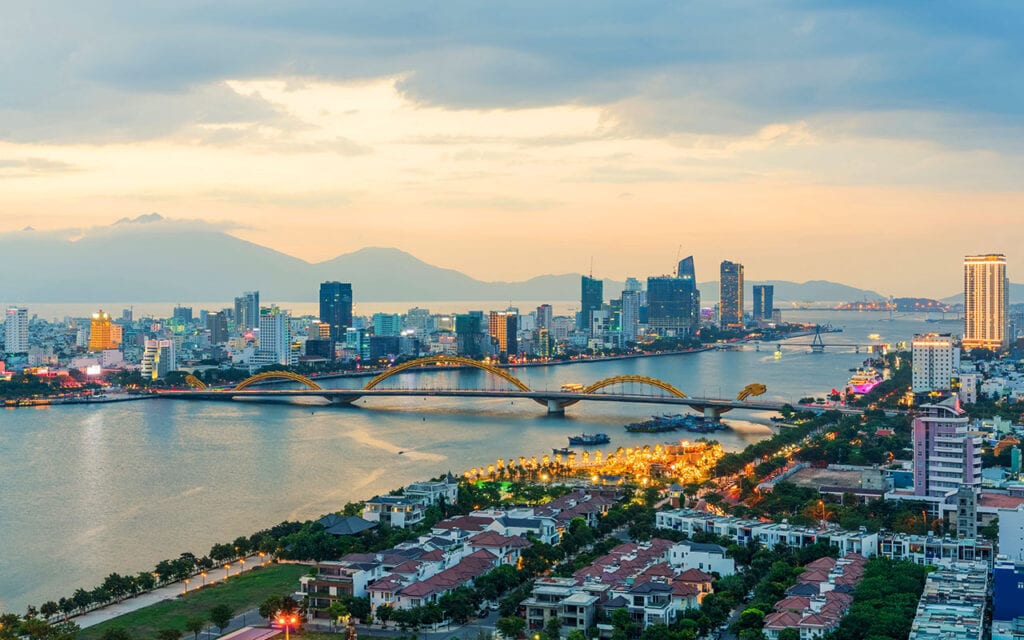
Further north of Hoi An is a beautiful coastal city – Da Nang . Da Nang is a tropical sea paradise in Vietnam; it has some of the most beautiful and secluded beaches such as Non Nuoc Beach, which is almost never too busy. It would make you extend your staying here with its spectacular mountain temples, well-decorated bars and restaurants, and so much more. It is not random that many expats choose to relocate here as you can easily find a hint of the modern lifestyle of a big city blended into the tranquility of the natural surroundings.
If you are an adventurous soul, get on a motorbike and go for a road trip around Son Tra Peninsula, then set out to conquer the Hai Van Pass or simply walk the majestic Golden Bridge .
The ideal time to visit Da Nang is the dry season from January to July, and the most perfect is between February and May. During this period, the weather is pleasant and less rain.
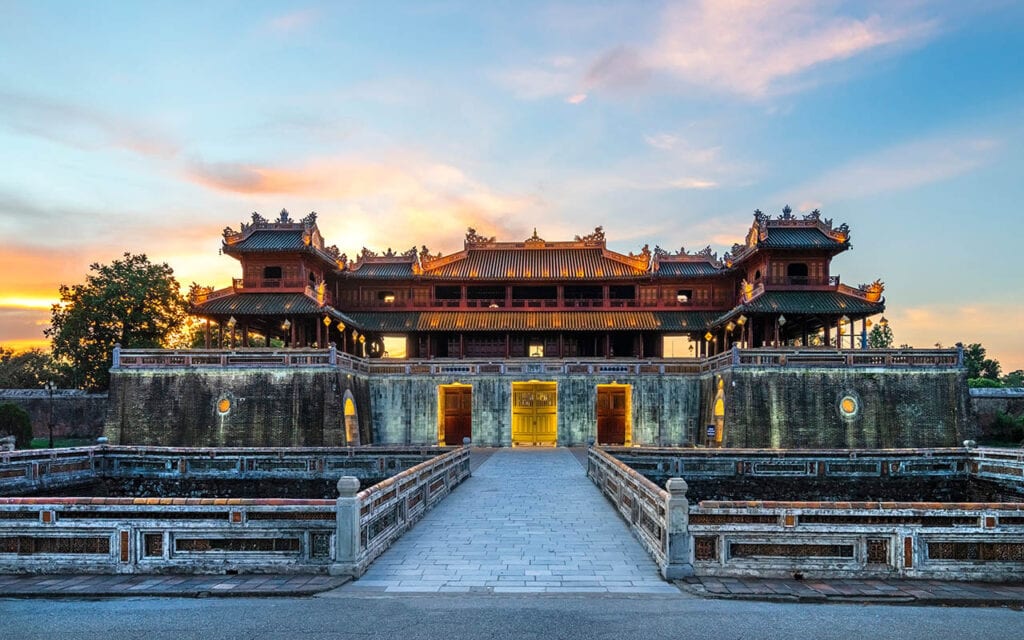
Hue is the former imperial capital of Vietnam under the prosperous reign of the Nguyen Dynasty, which explains a rich collection of tombs, palaces, and royal buildings. That is also the highlight of this romantic city.
Strolling along the gorgeous Perfume River, crossing Trang Tien Bridge just to later sit down and take a sip of cold Huda beer.
Hue is definitely not a tourism hub but if you are keen on an atmosphere with a breadth of history, then Hue would be your perfect choice.
Located between the South and the North, Hue weather is characteristic of both regions. Hue has four seasons, but the most obvious are sunny and rainy seasons. The dry season lasts from March to August, it is quite bright and hot. From August to November is the rainy season. Especially from October onwards, there are prolonged rains and storms.
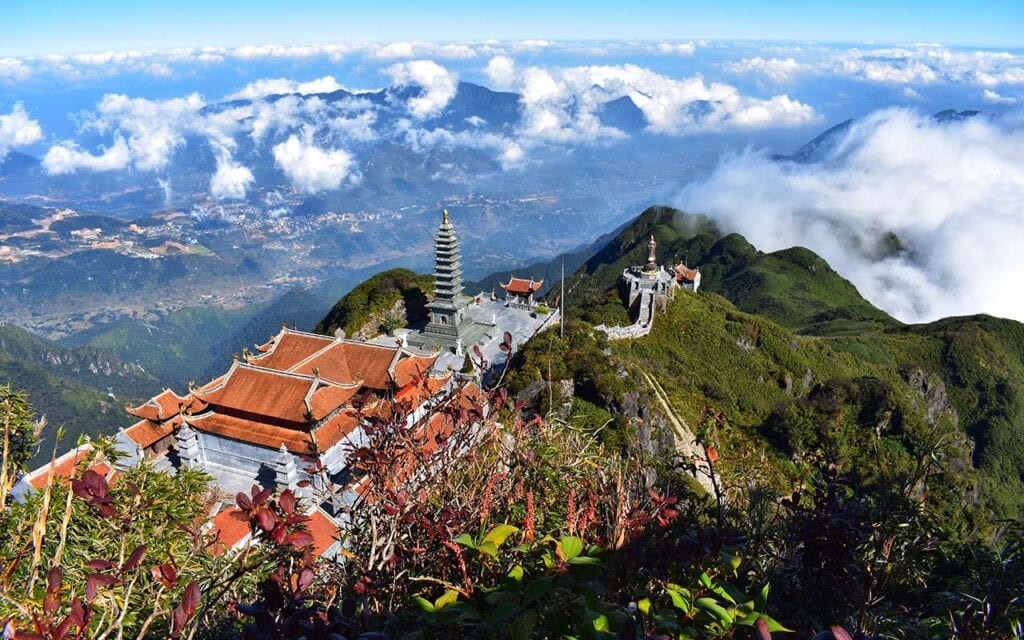
In 6th place, Sapa meets all the elements to become one of the best places to visit in Vietnam: the small villages like the picture painted on the majestic hills, upland markets, and the identity of ethnic minority communities.
Although the main town itself has been said to be too touristic and going through lots of construction, it gives you a reason to go out of town and immerse yourself in one of the most beautiful highland cities in the country. Meeting up with the innocent local minority people and being amazed by terraced fields – breathtaking scenery will be your unforgettable memory.
Sapa is a mountainous region with a cool climate all year round. The weather in Sapa has four seasons. The average temperature of Sapa is 15 °C. Summer in Sapa is not too hot; winter is often cloudy and cold, and sometimes it snows.
The best time to visit Sapa is from September to early November, at this time, rice begins to ripen, and the scenery of Sapa turns to the brilliant golden colour of the rice, a picturesque view.
7. Nha Trang

As one of the most beautiful coastal cities in Vietnam , Nha Trang has been recognized as a tropical sea paradise. Not only do long blue beaches and dozens of large and small islands remain untouched, but Nha Trang is also an ideal destination for those who love culture – history as it is also the land of the flourishing Champa Kingdom in the past.
Visit Nha Trang, immerse yourself in the refreshing water, dive down to the coral reefs, discover islands by canoe, and enjoy fresh seafood.
The most significant advantage of this city is the long sunny season during the first eight months, the temperature difference is not considerable. The rainy season of Nha Trang lasts from September to December and reaches its peak in October and November.
Nha Trang is definitely an indispensable name when it comes to the best places to visit in Vietnam.
8. Ho Chi Minh City

When talking about the best places to visit in Vietnam, it’s impossible to ignore the biggest city in the country: Ho Chi Minh City .
Ho Chi Minh City (Saigon) is the most developed and somehow chaotic city across the country once known as the Pearl of the Far East. Although Saigon is not rich in natural resources, it has a wide range of street food and nightlife activities to choose from.
And if your heart is up for knowledge, there is a list of museums and galleries scattered around the city so you can check them out and explore the city at the same time.
Chinatown is also the soul of the dynamic city filled with century-aged temples and shops – where you can give yourself a break after play-hard days. It is no exaggeration to say that Saigon has it all.
Ho Chi Minh City weather does not have four seasons like Hanoi but only two: rainy and dry. The rainy season is from May to November. In general, you can visit Ho Chi Minh City at any time of the year, the rainy season is also the most beautiful season of this city.
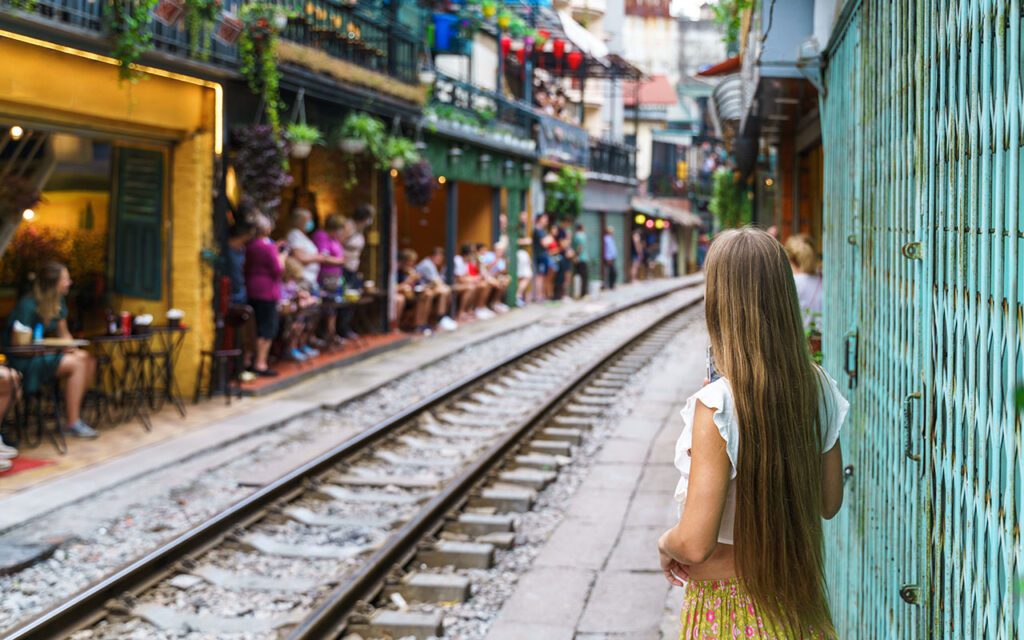
It is always worth visiting the capital city of any country. In Hanoi , your mind will be blown away by the subtly busy Old Quarter – 36 Streets. You will live the historic moments walking along Long Bien Bridge.
You will love every single second of riding around Truc Bach Lake and finding yourself a good coffee spot to sit down and enjoy a hot egg coffee. And when the sun goes down, get yourself to the Main Cathedral, sit on those red stools and join the locals for lemon tea and sunflower seeds.
Hanoi is one of the few places in Vietnam that has four seasons. Because of the characteristics of a humid monsoon tropical country, Hanoi’s climate in the winter and summer is quite harsh. The winter in Hanoi is so cold; sometimes the temperature drops deeply below 10 °C, meanwhile, the summer is very hot, sometimes stormy. According to the experiences of many travellers, you should visit this city in the autumn.
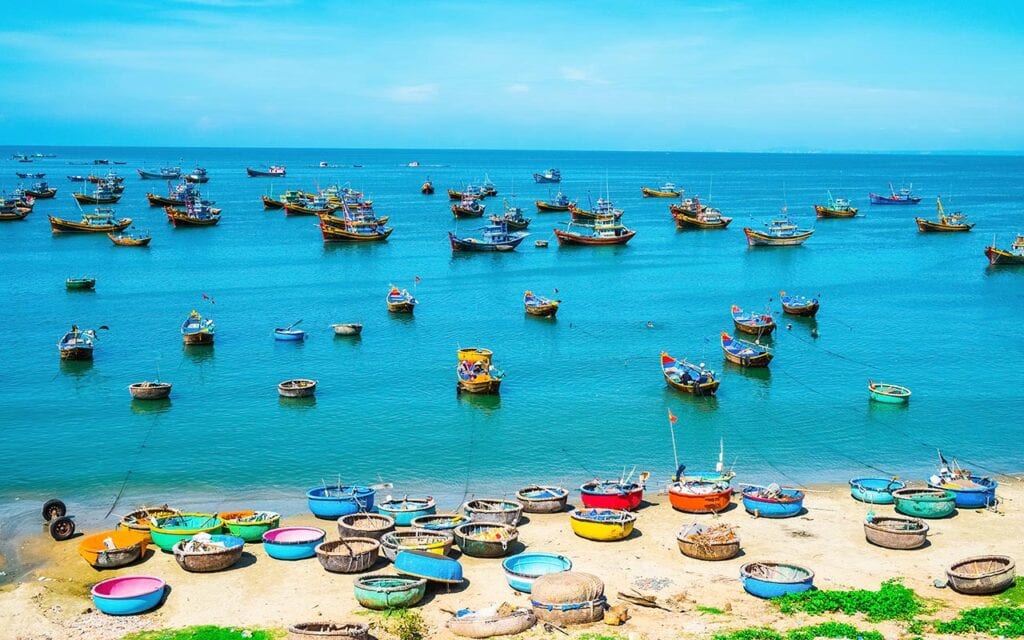
Mui Ne is another coastal city to add to your list. Unlike any other beaches, Mui Ne is a paradise for those into extreme water sports. You can do from snorkeling, diving to surfing and parachuting. Riding past miles of white and red stunning sandhills on one side and feeling the ocean breeze blowing from the sea from the other side, you will know why this destination keeps popping up in travel conversations. And of course, live seafood is freshly brought to restaurants from the fishing boats will fulfill your visit.
Mui Ne is not only good for motorbike trips but also the best place across the country for water sports. November to April is the windy season making it perfect for kitesurfing and windsurfing. Other activities such as parasailing, kayaking, and motorboating can also be spotted. Make sure you eat at one of the food stalls set on the beach for an unforgettable dining experience.
- places to visit in vietnam
- Vietnam travel guide

Related Articles

Touropia Travel Experts
Discover the World
17 Best Places to Visit in Vietnam
A long, narrow country squeezed in between the South China Sea and the Laos and Cambodia borders, Vietnam is a land of striking landscapes that range from the lush rice terraces and forested mountains in the north to the picturesque valleys of the Central Highlands and the fertile delta and beautiful beaches of the south.
Vietnam has seen its fair share of struggles. Ruled for almost a thousand years by various Chinese dynasties until 938 AD, Vietnam became a French protectorate in the 19th century. After independence, there was the Vietnam War.
Today, Vietnam is a proud country and you can see why. Not just for fiercely defending its own independence, but for its incredible landscapes and history.
The first words on everyone’s lips when speaking of Vietnam are undoubtedly Halong Bay, a beautiful set of karst islands and formations off the northern coast. Hanoi is the bustling, motorbike filled capital. Plan your trip to this beautiful Southeast Asia travel destination with our list of the best places to visit in Vietnam.
17. Da Nang
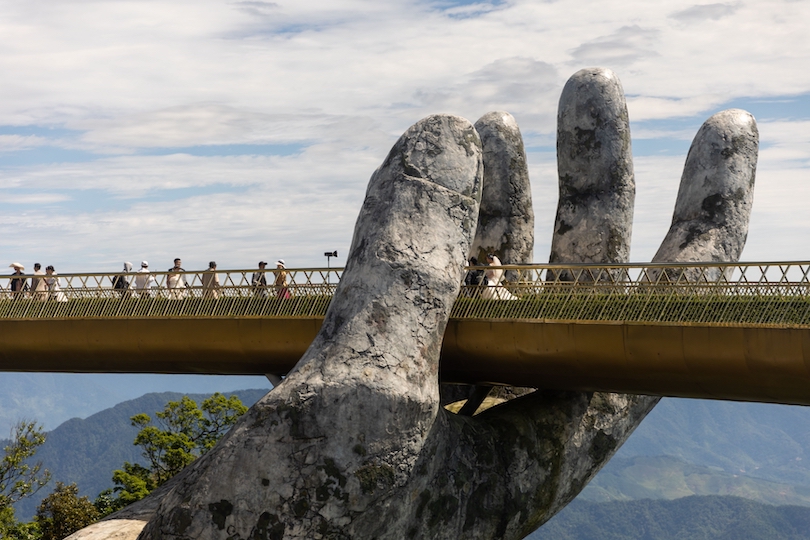
Nestled on the central coast of Vietnam, Da Nang is an energetic coastal city with a historic French colonial port.
It is known primarily for its fantastic beaches, including the famous My Khe Beach , which Tripadvisor has named as one of the best beaches in Asia.
However, it is also a popular starting point for exploration of the Bà Nà hills , which lie on the city’s western reaches. From there, the spectacular Hải Vân Pass showcases incredible views of Da Nang Bay. Moreover it conveys the Marble Mountains , five imperious limestone outcrops crowned with ornate pagodas and yield caves containing lavish Buddhist shrines.
Da Nang boasts impressive landmarks like the iconic Dragon Bridge , world-class golf courses, and a modern skyline dotted with luxury resorts and upscale shopping centres.
The city is also home to many cultural experiences, including the Da Nang Museum of Cham Sculpture and Da Nang Fine Arts Museum.
16. Ha Giang Loop
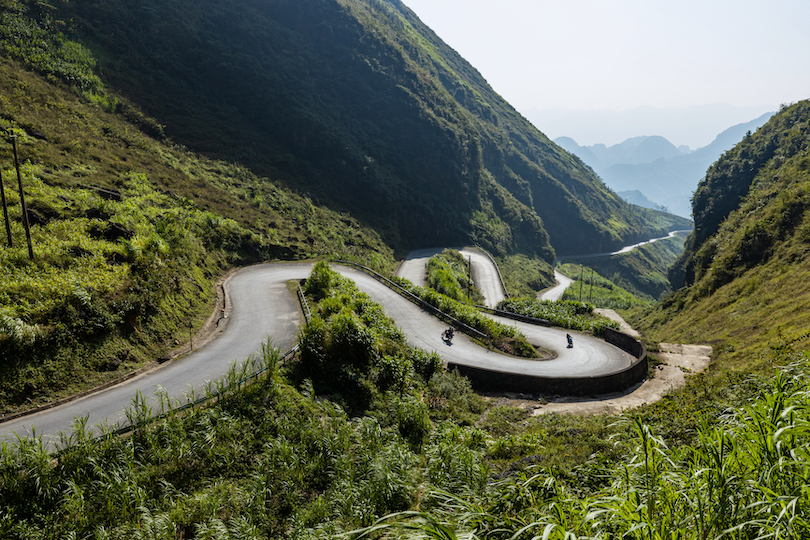
If you pride yourself on being an adventurous traveler, then you should embrace the Ha Giang Loop with open arms.
Located in the remote and breathtaking Ha Giang province , tourists can embark on a thrilling motorbike journey through some of the country’s most awe-inspiring landscapes. This scenic loop takes you on a winding road that cuts through majestic mountains, lush valleys and terraced rice fields.
The journey provides an immersive experience, allowing you to connect with the authentic culture of the ethnic minority communities that call this region home.
Along the way, you’ll encounter traditional villages , where locals showcase their rich heritage, colorful attire, and warm hospitality.
The loop offers stunning viewpoints such as Ma Pi Leng Pass , with its jaw-dropping vistas of the Nho Que River snaking through the mountains. You can also visit attractions like Dong Van Karst Plateau, a UNESCO Geopark, and the fairy-tale-like Lung Cu Flag Tower.
Typically, this journey takes three to four days to complete. Its rugged beauty and remote nature are perfect for those seeking an off-the-beaten-path experience.
15. Bai Tu Long Bay
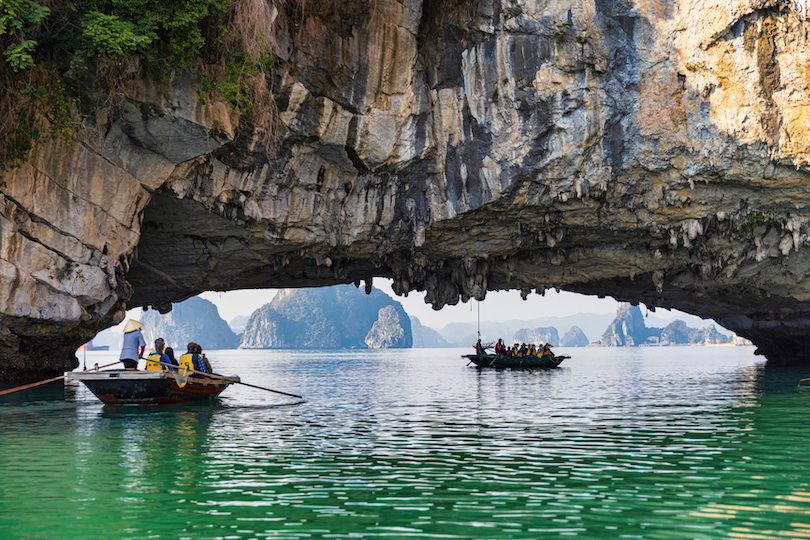
If you can’t get to or don’t fancy visiting Halong Bay, Bai Tu Long Bay is an excellent alternative. Situated in the northeastern part of Vietnam, it has all the pristine beauty and untouched landscapes of its more illustrious neighbor, only with greater tranquillity and fewer crowds.
The picturesque bay is characterized by its emerald waters, towering limestone islands , and lush vegetation. Cruising through it provides fabulous opportunities for kayaking , swimming and visiting remote fishing villages.
The bay is also home to a diverse ecosystem accommodating rare wildlife, colourful coral reefs and hidden caves waiting for you to discover them.
A tour of the area allows for a more intimate connection with nature and a chance to experience the serenity of the surroundings. Whilst there, be sure to visit the incredible Thien Canh Son Cave . One of 59 discovered caves in the area, it will wow you with its unique stalactite formations.
14. Tam Coc
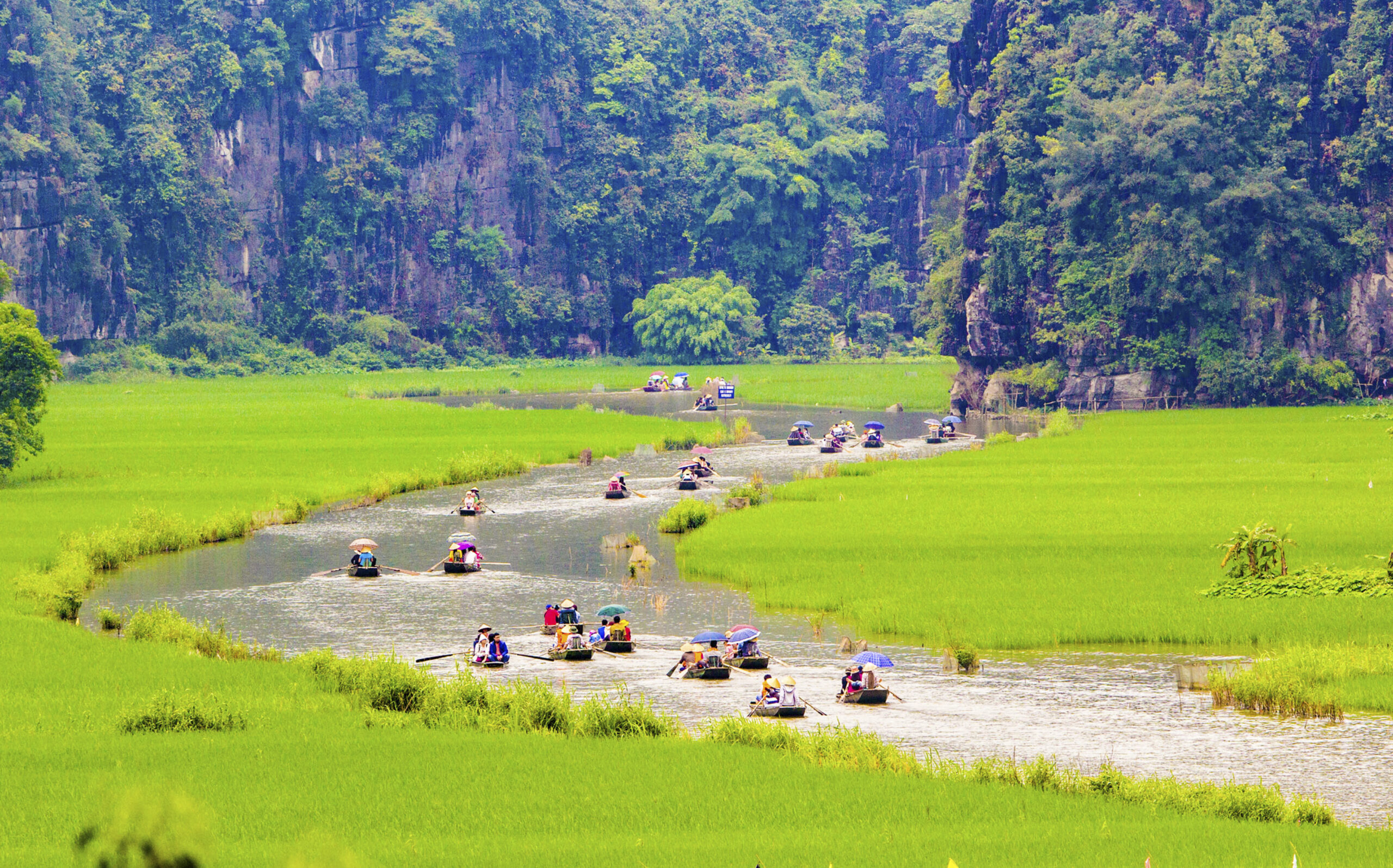
Tam Coc, often called ‘ Halong Bay on land ‘, is an enchanting destination in the Ninh Binh province.
Forming part of the UNESCO World Heritage Tràng An scenic landscape site, it is renowned for its dramatic limestone karsts that dramatically rise out of emerald green rice fields. Tam Coc presents visitors with a stunning natural landscape that will forever leave an impression on their heart.
The main attraction in Tam Coc is a scenic boat ride along the Ngo Dong River , where local rowers skilfully navigate through a series of caves and limestone formations. As you glide along the tranquil waterways, you’ll be mesmerized by the picturesque scenery and the harmonious blend of nature and verdant rice paddies.
Tam Coc is also home to ancient temples and pagodas, such as Bich Dong Pagoda , which is perched atop a hill and offers panoramic views of the surrounding countryside.
If you are into cycling, you can also explore the area in more detail on two wheels.
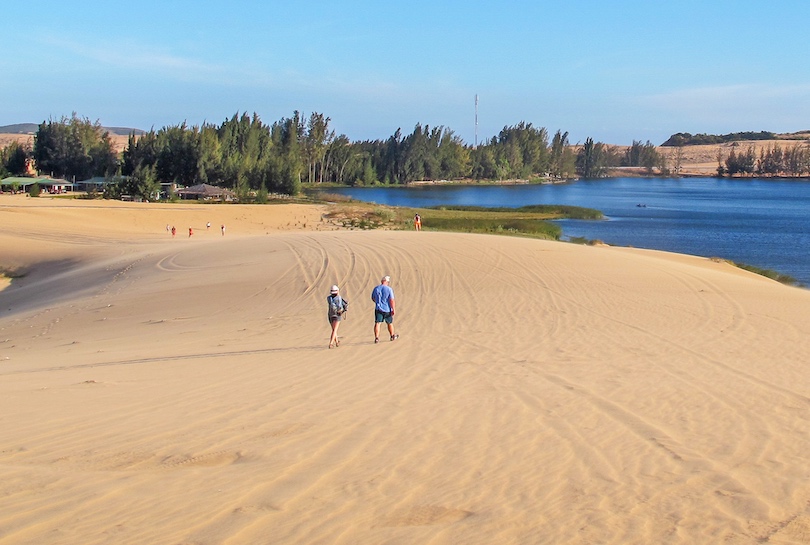
There are several places in Vietnam where you can go for some beach R&R, but few can compare to the sheer beauty of Mũi Né.
A stunning beach resort town along the southeast coastline, it boasts a long stretch of golden palm-tree-lined sand, perfect for walking and sunbathing. During the dry season, with steady wind conditions, the area becomes a fantastic destination for sailing, kitesurfing and windsurfing.
The highlight of Mui Né is undoubtedly its captivating sand dunes . The iconic White Sand Dunes and Red Sand Dunes offer a surreal landscape that resembles a desert oasis. On our last visit, we explored the dunes on an ATV ride and sand boarded down the slopes. Both were a lot of fun!
Beyond the beaches and dunes, Mui Né offers opportunities to explore nearby fishing villages , taste delicious seafood, and indulge in rejuvenating spa treatments. Close by, The Fairy Stream, with its gently flowing water and unique rock formations, is a popular spot for a refreshing dip on a stiflingly hot day.
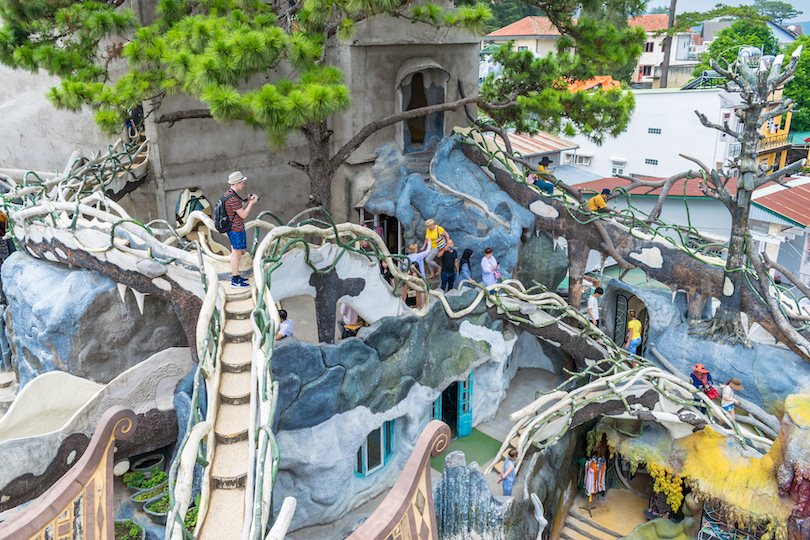
Year-round cool weather and idyllic scenery of misty valleys, lush pine trees and colorful flowers are some of the reasons that Dalat was once used by Vietnamese emperors and French colonials as a summer retreat. Today, this charming town in the South Central Highlands of Vietnam is a popular destination for honeymooners, weekend getaways and for those looking for relief from the heat.
A walkable city, Dalat is a beautiful scene of French colonial architecture and villas set amid picturesque landscapes. The city is well known for its royal palaces that were owned by the last emperor of Vietnam. These lovely palaces are open for tours as is the Hang Nga Guesthouse, the city’s most bizarre attraction. Informally called the “Crazy House,” this structure is a fantastical construction with caves, spider webs and shapes of animals and mushrooms.
Dalat’s lively market is a great place to find fruits, flowers and vegetables grown in the local area as well as handicrafts and silk embroidered items.
Outside the city are scenic lakes, flower gardens, plantations and mountains offering pretty waterfalls and trails for hiking and mountain biking. A must-do is the Valley of Love, an incredibly beautiful valley with pine forests and lakes where tourists can enjoy pedal-boating and canyoning.
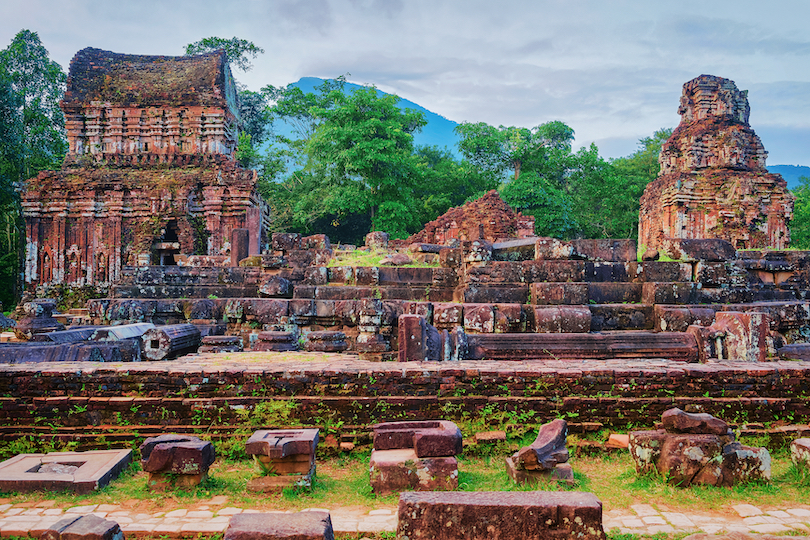
Located on the central coast of Vietnam near the Duy Phú village is the important archaeological site known as My Son. One of Southeast Asia’s most notable heritage sites, My Son was once a significant center of religious Hindu ceremonies where the kings of the Champa Kingdom built numerous temples devoted to the worship of the god, Shiva, between the 4th and 14th centuries.
Believed to have once contained more than 70 temples that were constructed with brick and decorative carvings and sculptures bearing scenes of animals, priests, gods, mythical battles and inscriptions of Sanskrit and Champa, My Son today features a complex of ruins in varying states of disarray and repair, all arranged in several groups.
Within the site is a museum where visitors can check out exhibits and artifacts to better understand and appreciate the ruins. Near the entrance of My Son are a few cafes, food vendors and a shop selling souvenirs. At certain times of the day, visitors can watch live Champa dance performances. Additionally, the site is surrounded by jungle, hills and a lake where visitors can enjoy hiking and kayaking.
My Son is often reached by organized tour groups from Hoi An. However, visitors can also arrive at My Son by motorbike rentals.
10. Phu Quoc
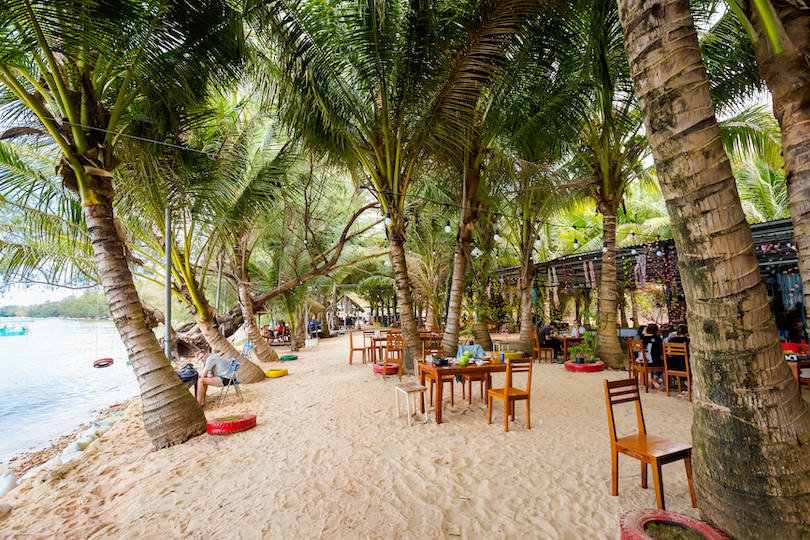
Phu Quoc is a scenic island in the Gulf of Thailand. While it officially forms part of Vietnam, it is actually closer geographically to Cambodia . Today, it’s characterized by dense tropical jungle, soft sandy beaches, and undulating hills. But the island has a fascinating history, having served first as a French missionary base and then as a French colonial wartime prison – a gloomy reformatory that you can visit today.
History aside, the island is most tempting for its alluring tropical nature . Days in Phu Quoc are spent sunbathing on sandy beaches, scootering around fishing villages, visiting pearl and pepper farms, and, if you’re up for it, trekking to waterfalls.
An island that’s famous for its seafood, don’t miss an opportunity to try out Phu Quoc’s famous fish sauce (nuoc mam) – you can even visit one of the fish sauce factories while you’re here!
9. Phong Nha-Ke Bang National Park
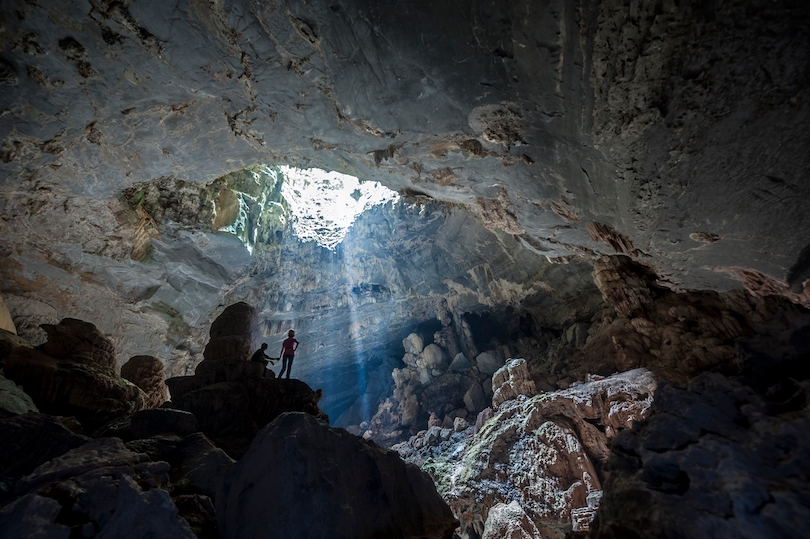
Tucked away in the Quang Binh Province in Vietnam’s Central Coast region, Phong Nha-Ke Bang National Park is one of the most picturesque parts of the country. With a steadfast reputation as a filming location for 2017 Kong: Skull Island, and with a nearby international airport, the national park is more popular than ever before.
Opened to the public in 2010, the appeal of Phong Nha-Ke Bang National Park is the escape from the city. Here, you’ll live life in the slow lane as you cycle through Kong jungles at your own pace.
Home to 400 million-year-old karst mountains, there are hundreds of caves and secretive rivers to explore. The Son Doong Cave is a must visit. Home to its very own hidden jungle, microclimate, and Underground River, it’s one of the largest caves on Earth .
Due to its location near the Laos border, access to the park is strictly controlled, and visitors can expect to find a strong military presence here. This is mainly due to its war history – the park has some of the world’s highest numbers of undetonated bombs, which is why visitors can only visit this place with a licensed tour guide.
8. Ho Chi Minh City
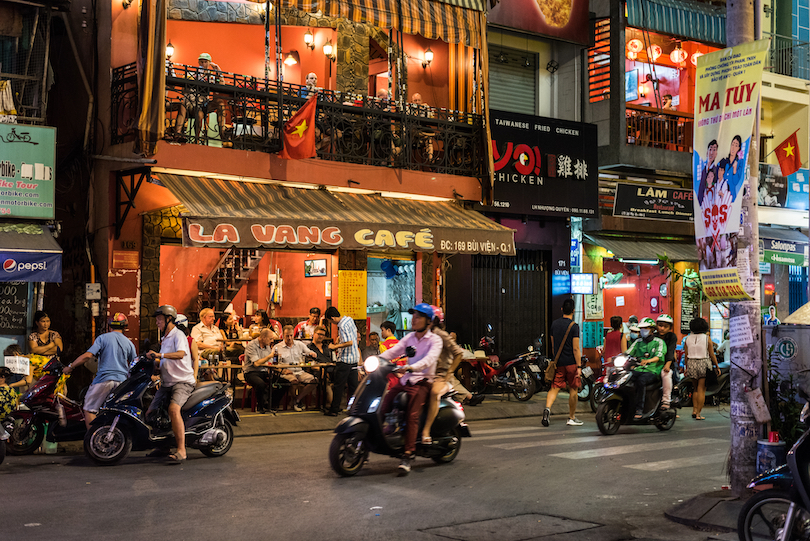
Ho Chi Minh, formerly known as Saigon , is the biggest city in all of Vietnam. It’s also the old capital of the Republic of Vietnam. When Saigon fell to the north in 1975, it was renamed to HCMC, yet its former name is still used today, particularly when describing the beating heart of the city.
Hoi Chi Minh has a bit of everything – temples, museums, parks, and tourist shopping. Whatever your interests, you’ll find something to do here. Head to the top of the Saigon Skydeck for an astonishing 360-degree view of the city – especially impressive at night when the lights twinkle on below.
History buffs should not miss the chance to explore the mysterious network of the Cu Chi tunnels , the headquarters for many military operations during the Vietnam War.
The five stories of Reunification Palace – also known as the Independence Palace – is also a fascinating place to go. It’s a famous spot in Vietnam’s history as it captures the time when Saigon fell as a tank broke through the gates of the palace. A replica of this same tank can be seen on the grass outside the palace.
If you’re curious to learn more about the war, you’ll enjoy a visit to the War Remnants Museum or the Museum of Vietnamese History.
7. Mekong Delta
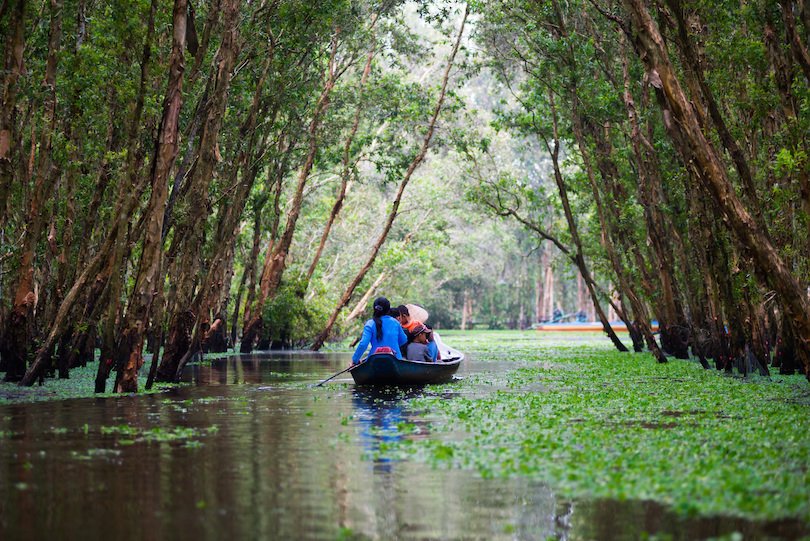
The Mekong Delta, nicknamed the ‘Rice Bowl of Vietnam,’ is a lush network of waterways in Vietnam known for its excellent nutrient-rich soils and diverse ecosystems – the banks are a veritable patchwork of fruit, vegetables, rice plantations and cattle farms that provide sustenance for more than a third of the country.
This impressive stretch of river frontage is the most biodiverse in the world if you don’t count the Amazon. Taking up much of the south of Vietnam, the Mekong Delta is an extraordinary place filled with lily pad waterways, rice paddies, mangroves, and enchanting wildlife.
With plenty of bus connections and motorbikes, tourists can explore the Mekong Delta and its towns like Tra Vinh , which is considered one of the prettiest villages of the delta. A boat trip down the tranquil tributaries and mangroves of the Mekong is an unforgettable experience.
Paddled by a local in a wooden canoe, you’ll be able to witness everyday life on the river, passing farmlands, fruit orchards, monkey bridges, water buffalo, and floating markets . The best time to visit the Mekong is during the dry season between December and May when there’s less chance of flooding.
6. Nha Trang
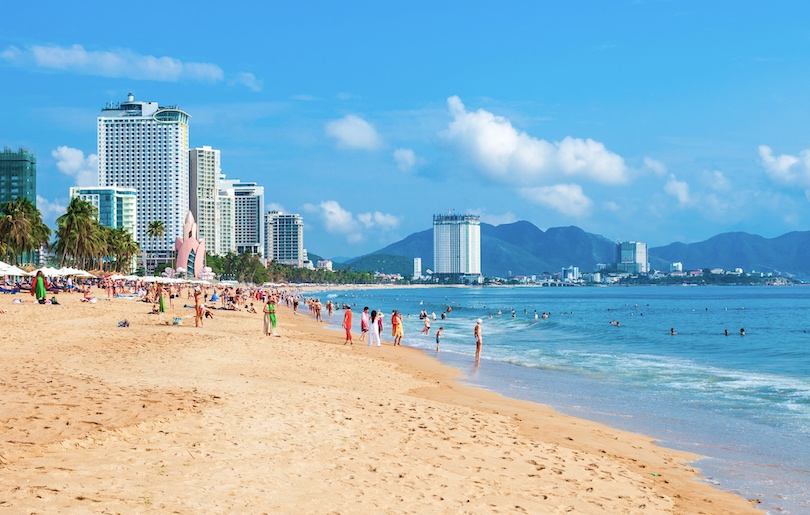
If it’s beaching you’re after, you’ve come to the right place. Nha Trang is the most famous seaside resort in Vietnam, with a laidback atmosphere and exceptional scuba diving. While it’s certainly not on the same scale as many of Asia’s other beautiful beaches , Nha Trang offers warm water and some picturesque offshore islets.
The promenade that encircles the beachfront is always a hive of activity, filled with parks and sculptures that make a stroll here interesting. As with most beach resorts, most of the activity gets going when the sun goes down, and Nha Trang is no different. You’ll find a host of vibey bars and restaurants near the beachfront.
There’s much more to Nha Trang than sunbathing and strolls, though. Go for a soak in the Thap Ba Mud Bath or take a ride on the longest cross-sea cable car in the world. The sacred Po Nagar Cham towers, dating back to the 7th to 12th centuries, offer a taste of the city’s history – they’re an active religious site for Cham, Chinese, and Buddhists even today.
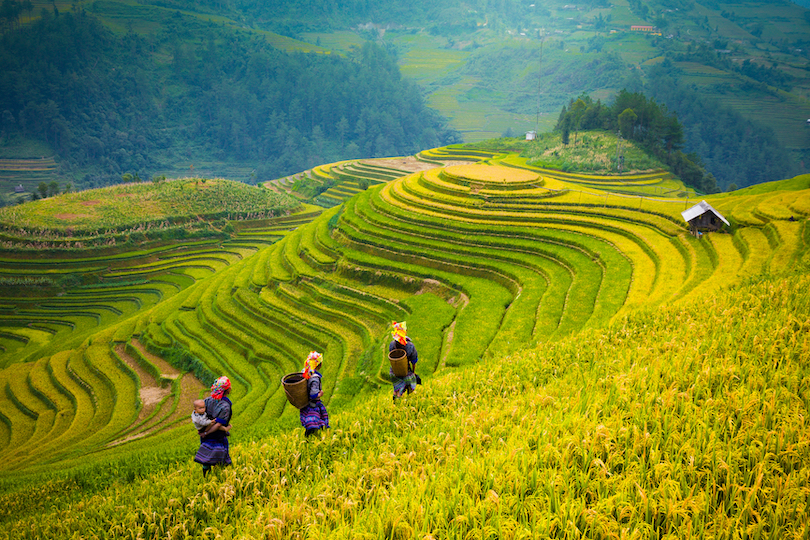
Tracing the border with China, Sapa is a captivating remote town in the Hoang Lien Son mountains of northern Vietnam. Its elevation 1,500 meters above sea level is nothing to scoff at when you’re trekking the terraced hills and slopes around this high-altitude mountain town. While there’s plenty of natural beauty to tempt you to this far-reached corner of the country, much of Sapa’s appeal lies in its raw and authentic culture.
Days are spent trekking through rice paddies , rural villages untouched by tourism, and the clouds of Fansipan – Vietnam’s highest peak.
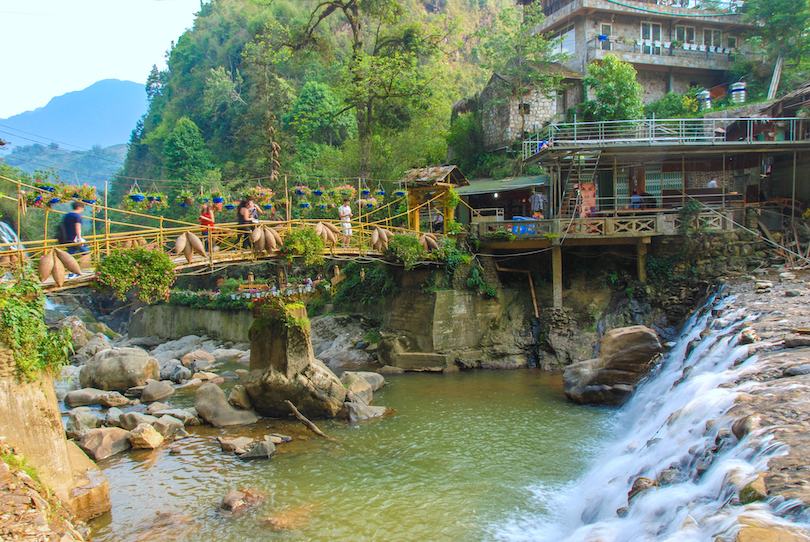
Scenery aside, the highlight is hands down the opportunity to chat with these fascinating people along the way – local kids will tag along and try to sell you some of their handmade jewelry or simply try to improve their English by speaking to you.
In the town of Sapa itself, there are attractive French colonial sites worth visiting such as the Gothic church, the town square and city hall. Sapa is a major market town where the various ethnic tribes in the area often gather to sell their handicrafts, which make excellent souvenirs. At the Sapa Culture Museum, visitors can learn all about the history and cultures of these ethnic groups.
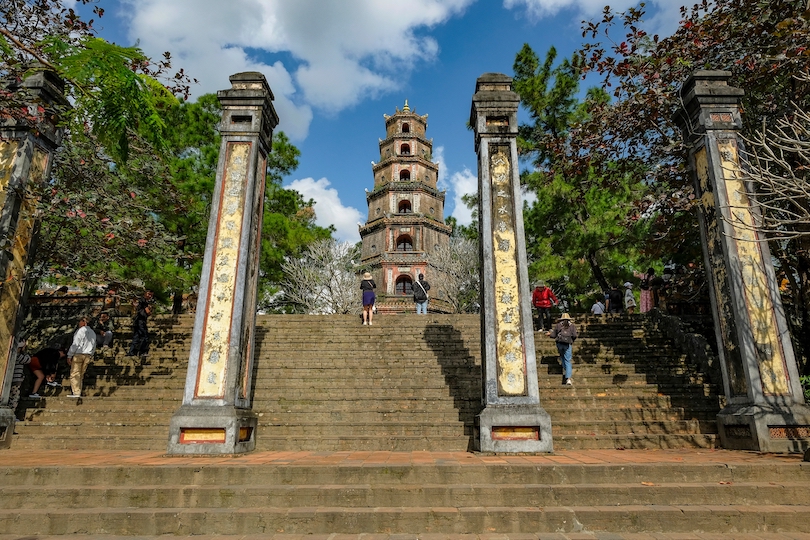
Hue – formerly known as the Panduranga of Cham Kingdom – was once the imperial capital of Vietnam. Located in the central region, Hue had a huge role to play in the Vietnam War. Captured by the Viet Cong for a total of 24 days, thousands of people were killed here if they were thought to be sympathizers of the south.
Today, the city is split in two by the Perfume River. The old city with its ancient ruined citadel lies to the north and the modern-day city to the south. The Demilitarized Zone, which marks the official former border, is one of the most popular day trips from Hue while the Thien Mu Pagoda is the city’s official symbol.
Of the city’s monuments , the Citadel is the most famous. Once the seat of the Nguyen emperors, the Citadel is a sprawling complex of grand palaces, ornate temples, walls and gates. Prime attractions within the Citadel are the Forbidden Purple City, Thai Hoa Palace, and the Ngo Mon Gate. Another important landmark on the river is the city’s official symbol, the Thien Mu Pagoda.
A stroll along the promenade is also recommended, through the statue-abundant parks and onwards by scooter or boat cruise to the Tombs of the Emperors on the outskirts of the city. Dating back to the 19th and 20th centuries, the Tomb of Tu Doc, with its striking Buddhist architecture is the cherry on top.
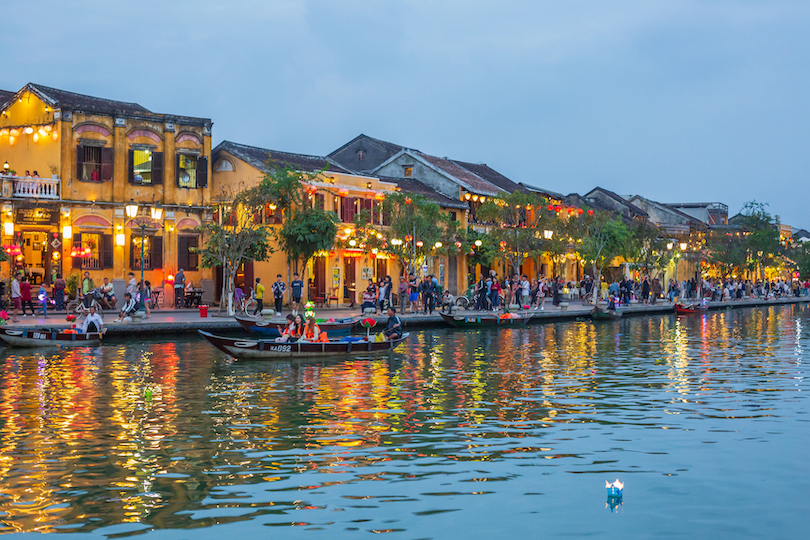
Laidback and charismatic with a charm all of its own, Hoi An is the highlight of any Vietnam itinerary. Located south of Da Nang within cycling distance of some excellent warm-water beaches along the central coast, this atmospheric old town is a feast of color, where bright and cheerful lanterns adorn each and every building.
The narrow, winding lanes of the old town are lined with beautiful historic buildings, Chinese temples and wooden-fronted shops with excellent opportunities for retail therapy. The bustling night market and lantern-lit streets are also great places for shopping and people-watching.
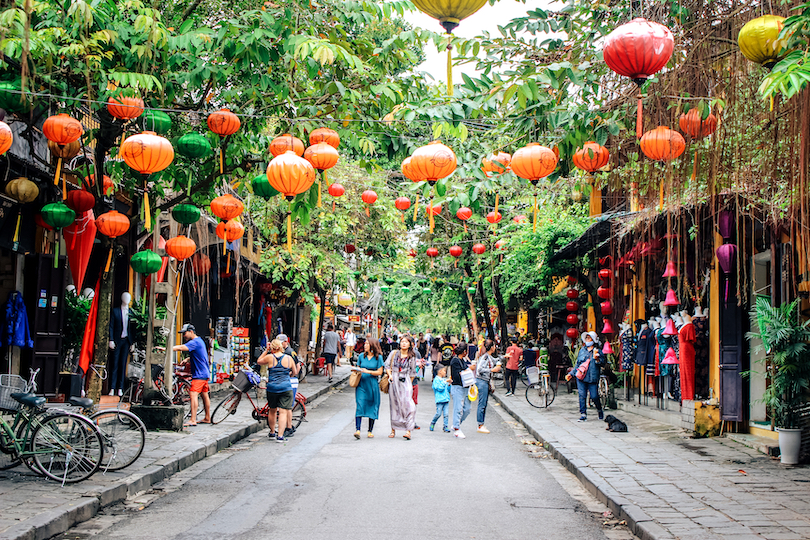
At the same time, you can also take a boat ride along the Thu Bon River or join a cooking class to learn the secrets of Vietnamese cuisine. Wrangle a tempting spa deal, and get a dress or tailored suit handmade for you at one of the town’s many illustrious tailors.
Don’t leave without a visit to the gorgeous Japanese Covered Bridge and the glaze-roofed Chinese merchant houses that date back hundreds of years and house a quarter of the town’s population. There’s plenty to fill your afternoons in Hoi An.

Hanoi, the capital of Vietnam, is truly chaotic, but that’s all part of its charm. An interesting mix of French and Sino-Vietnamese influences, it’s one of the most rapidly growing cities in Southeast Asia.
Those visiting this energetic capital should be prepared. It’s a hive of activity at the best of times, utter chaos at the worst – a city where crossing the road could be taking your life into your own hands with cars, motorbikes, and tuk-tuks vying for right of way in a city without road rules.
One of the best places to experience the madness of Hanoi is at Legend’s Corner . The well-located Legend Beer restaurant is the ideal spot to sit with a drink and watch the rush hour insanity just before sunset. You’ll see pedestrians, dogs, cars, tuk-tuks, and scooters all entwined in traffic, yet somehow there are very few accidents.
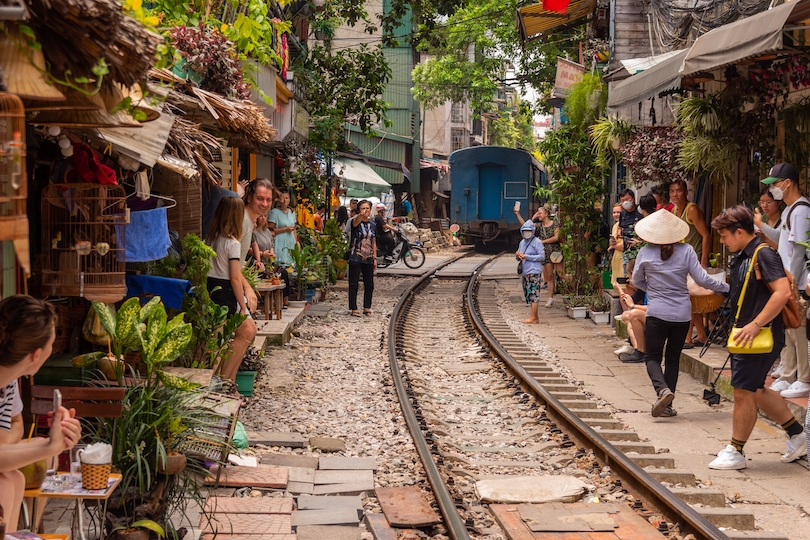
Hanoi’s historic Old Quarter is a maze of narrow streets filled with charming colonial architecture, street vendors, and bustling markets. The best way to explore it is on foot or by cyclo (cycle rickshaw). This will enable you to soak up its atmosphere and discover hidden gems like the ancient Temple of Literature or the vibrant Dong Xuan Market.
See also: Where to Stay in Hanoi
For a change of pace, go for a stroll around the freshwater Hoàn Kiếm Lake in the Old Quarter or soak up more Vietnamese history with a visit to the Thăng Long Imperial Citadel. The Ho Chi Minh Mausoleum , the final resting place of the Revolutionary leader and Vietnamese President, is a must-see.
1. Ha Long Bay
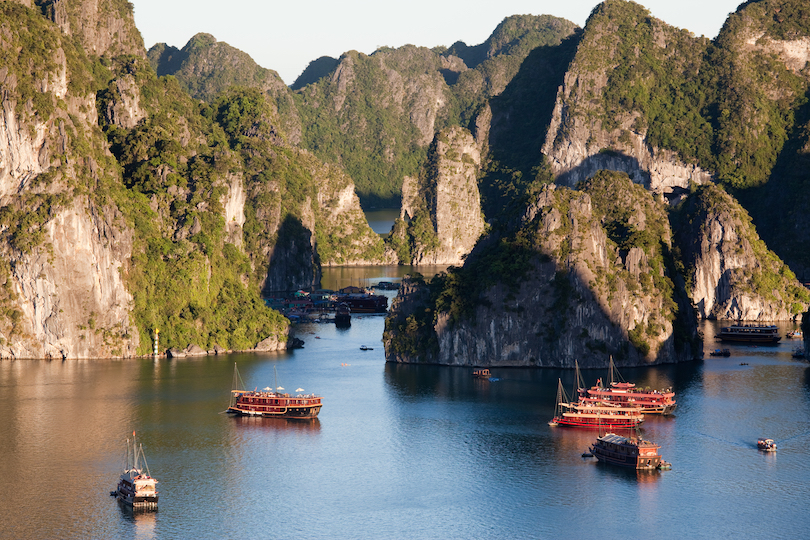
Located about 130 km (80 miles) east of Hanoi in northern Vietnam, Halong Bay is celebrated for its gorgeous emerald-hue waters, thousands of spectacular limestone karsts, astonishing waterside caves, and beautiful tree-topped islands.
It’s a popular location for adventure – scuba diving, kayaking, hiking, and rock climbing can all be enjoyed in and around Cat Ba National Park . For those who wish to simply relax and enjoy the views, there are numerous Halong Bay cruises to choose from, from basic to top-level luxury.
The thousands of islands scattered about the bay are a real mixture, ranging from isolated landmasses home to free-roaming monkeys and antelope to bigger inhabited islands with some fantastic beaches . Boat cruises are the best way to experience the natural wonder of Ha Long Bay.
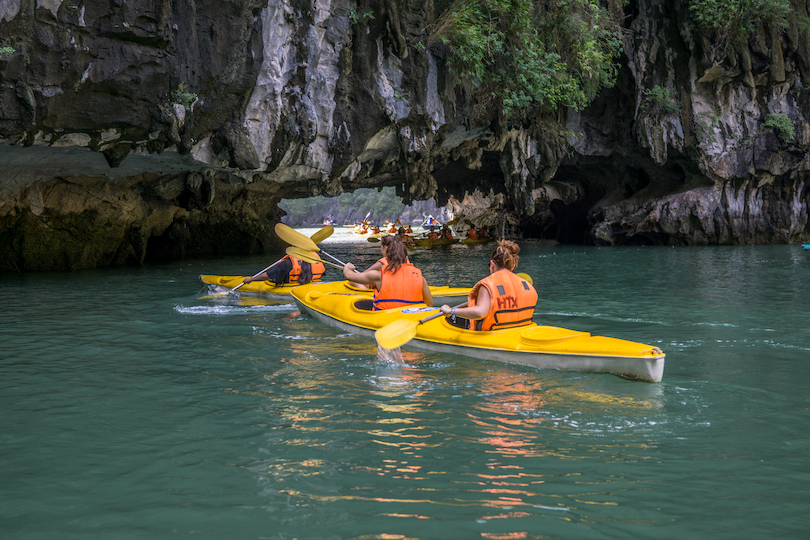
With hundreds of boats ranging from traditional Chinese junks to luxury cruisers, boat tours can vary from day trips to multiple-night journeys . These tours often provide meals, nightlife activities and excursion stops where islands, caves and lagoons can be explored. Most boat cruises are arranged either from Hanoi or from ports such as Haiphong, Halong City and Cai Rong.
As with most holidays on the water, Halong Bay is easily affected by the weather. Plan your trip between March and June to get the most out of your visit. June to September is the off-season, so you can usually get some great deals – just be sure to keep an eye on the weather forecast as monsoons can really put a dampener on your trip.
Map of Places to Visit in Vietnam
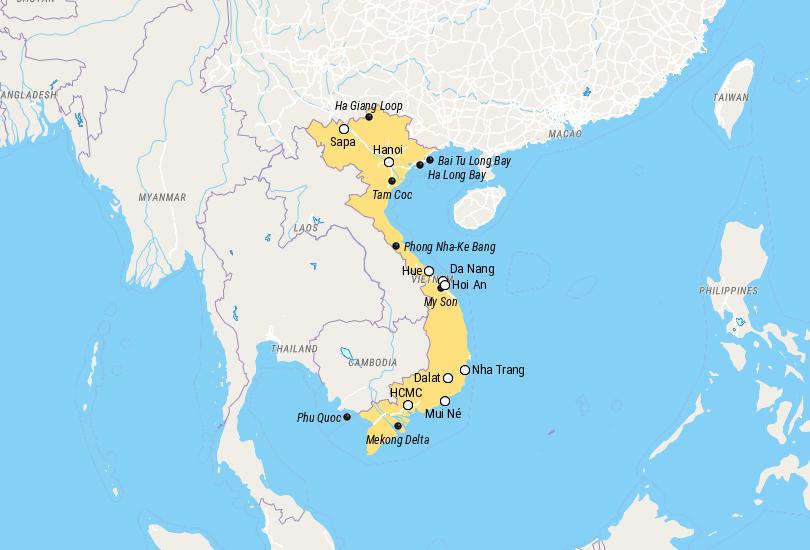
Vietnam Travel Video
Share this post:.
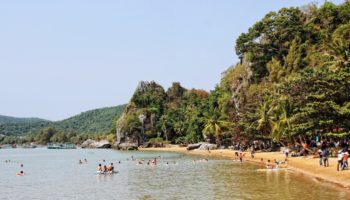
10 Most Beautiful Islands in Vietnam
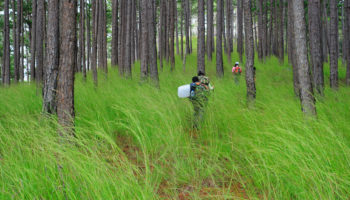
12 Most Beautiful National Parks in Vietnam
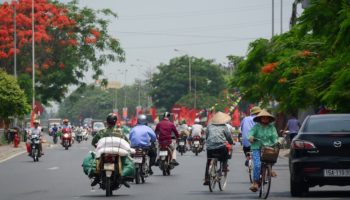
17 Best Cities to Visit in Vietnam
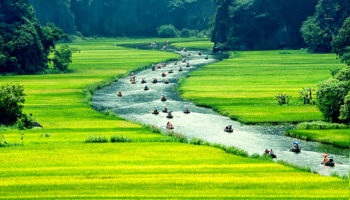
25 Top Tourist Attractions in Vietnam
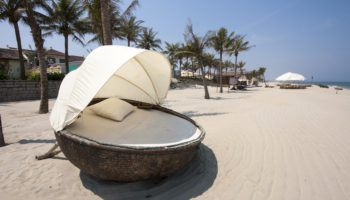
10 Best Beaches in Vietnam
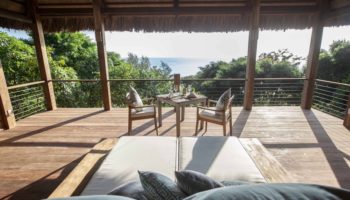
11 Most Amazing Hotels in Vietnam
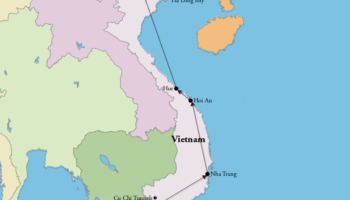
How to Spend 2 Weeks in Vietnam: DIY Itinerary
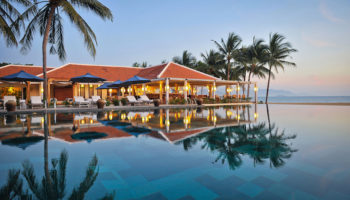
10 Best Vietnam Luxury Resorts
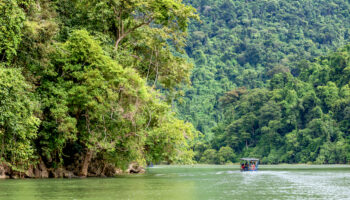
10 Most Underrated Destinations in Vietnam
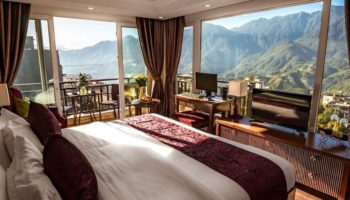
Where to Stay in Sapa: 8 Amazing Hotels
Reader interactions.
September 15, 2019 at 1:19 am
I hereby compose a key-word list of outstanding places in Vietnam. Hope it’s helpful for you guys searching.
1. Islands: Côn Đảo ; Phú Quốc ; Lý Sơn, Cam Ranh, Bình Ba, Bình Hưng, Điệp Sơn ,Đảo Yến Hòn Nội, ,Cù lao Chàm , Đảo Nam Du, Hòn ông đảo cá voi, Cát bà.
2. Best beaches on islands Bãi Nhát ( Côn Đảo ), Bãi Suối Nóng ( Côn Đảo ), Hòn Cao ( Côn Đảo ), Bãi Sao ( Phú Quốc ), Bãi Khem ( Phú Quốc ), Bãi ông Lăng ( Phu Quoc ) , Nam Du ( Phu Quoc ), Dao Be ( Ly son ) , Bai Kinh ( Binh Hung), Bai Nom ( Binh Ba ),
3. Coastal Cities : Ha Long, Da Nang, Nha Trang, Mui Ne, Quy Nhon, Vung Tau.
4. Best beaches on coastal cities: Doc Let, Dai Lanh, My Khe, Nha Trang, Ky Co, Bãi Binh Tien, Bãi Cà ná, Bãi bắc beach da nang, quy nhon beach.
5. Best Bays Ha Long Bay, Lang Co bay, Nha Trang bay, Ninh Van bay, Van Phong bay, Cam Ranh bay.
6. Highland cities/town offer great mountain views, trekking activities : Sapa, Da Lat, Ha Giang, Cao bang.
7. Ancient cities/towns : Hoi An, Dong Van, Hue
8. Caves: Phong Nha, Thien duong, Son Doong, Hang En, Hang Sung Sot, Hang Va, He thong hang dong Tu Lan, Tam Coc bich dong
9. Rivers Mekong delta, Sông Ngô Đồng, Tràng An, Sông đáy chùa hương, Sông Son, Sông Nho Quế, Sông Chày.
10. Waterfall Thác Bản Giốc, Thác Voi, Thác Pongour
11. Lakes Hồ Ba bể, Hồ Xuân Hương, Hồ Tuyền Lâm, Hồ Tơ Nưng, Hồ Lắk, Hồ Hoàn Kiếm, Hồ Thác Bà, Phá Tam Giang.
12. Lagoons Pha Tam Giang, Đầm Vân Long.
13. National Parks Phong Nha ke bang, Nam Cát Tiên, Bạch Mã, Cúc Phương, Ba Vì, Ba Bể, Tràm Chim Tam Nông, núi chúa.
14. Terraces rice field Mù Căng Chải, Hoàng Su Phì, Tú Lệ , Sapa, Y Tý, Bát Xát, Pù Luông.
Enjoy your traveling trip!
May 1, 2019 at 2:46 am
I like Vietnam. I really do. I love their culture and traditions. Just recently I went on a trip to Vietnam and I absolutely loved it. The people there were so nice and lovely. The wildlife, vegetation and sacred places were amazing too. But I have to say, the most beautiful place that I went to in Vietnam is Ha Long Bay. The scene was incredibly stunning! I also stayed in Sapa. It has astonishing views. Especially when you look at it from a distance. It has fog surrounding the buildings, has tall mountains in the background and has brightly coloured buildings. It’s breathtakingly beautiful!
March 3, 2019 at 1:49 am
I am a Vietnamese and according to my experience, there are two places you should visit when you are in Vietnam: Cat Ba Island in the Northeast Vietnam and Phu Quoc Island in the Southeast Vietnam.
March 29, 2018 at 9:26 pm
The market in Can Cau is fabulous.
November 21, 2017 at 10:29 pm
I think these places are amazing to visit but I have a question, how is Vietnam in general? Is it a safe country to visit ??
November 8, 2017 at 8:19 am
I recommend Pu Luong nature reserve, not very far from Hanoi.
September 19, 2017 at 4:52 pm
I really liked Da Nang.
November 23, 2016 at 4:13 am
Great list. I have just spent two months in Vietnam and did most of the places except My Son and Sapa. Will come back for that. Love this country!
July 21, 2015 at 2:04 pm
There are lots of day trip activities from Hoi An– snorkeling or diving at the Cham Islands, early morning cycling trips to the countryside, visiting the My Son archeological ruins. Hoi An also has terrific food, and is a great place to wander around and explore.
June 2, 2015 at 6:46 am
There are at-least 30 incredible places to visit in Vietnam, your list is correct those are about the top places but there are alot more amazing places in Vietnam and no one should stop at just 10
November 7, 2014 at 4:11 am
Great places. You can also put Ninh Binh and Ha Giang.
Leave a Reply Cancel reply
Your email address will not be published. Required fields are marked *
This site uses Akismet to reduce spam. Learn how your comment data is processed .
Last updated on October 31, 2023 by Shannon
While lumped together with Southeast Asia for geographic and tourism purposes, Vietnam stands out as a destination unique among its neighbors. Each region balances the other.
The frenetic chaos in Saigon is just a stone’s throw from the sleepy colonial towns in the Mekong Delta. Hoi An’s charming, historic ancient town is a mere 40 minutes from the fast-growing and friendly Danang.
History and tradition infuse every aspect of life in Vietnam—from food to religion—and the culture and people are remarkably welcoming to tourism, having built a thriving industry that makes traveling and backpacking in Vietnam unforgettable.
As such, modern Vietnam is a favorite hotspot for budget-loving backpackers traveling Southeast Asia , and destination travelers from all over the world. Although I had spent years traveling other regions of Asia, Vietnam was my final country to visit on mainland Southeast Asia. What an incredible experience.
I have no idea what took me so long to backpack through Vietnam. I spent three months traveling south to north and I discovered cities across the country highlighting various aspects of Vietnam’s long history. I traveled from the War Remnants museum in Ho Chi Minh City to the Japanese and Chinese influenced Hoi An to the French-influenced coffee and baguette culture throughout.
Vibrant, unique, chaotic, traditional—no single word sums the experience of traveling Vietnam.
If you’re visiting Vietnam, this guide covers the essential travel information you should know, pre-trip reading , how to travel responsibly in Vietnam, and specific travel and accommodation recommendations to jumpstart your research.
Table of Contents
Things to Know Before Traveling to Vietnam
Vietnam has a lengthy and complex history, with each layer still visible in modern Vietnam. From tangible evidence of French colonial rule to the aftereffects of the American War and a food culture deeply influenced by the international flavors and cultures—this country has a lot on offer from north to south.
Vietnam has a lengthy and complex history, with each layer still visible in modern Vietnam. Consider this a quick rundown on the basic backstory you’ll need to understand and enjoy traveling and backpacking through Vietnam. Ruled by the Chinese in 111 B.C., Nam Viet (what we now know as Vietnam) was a part of the Han Dynasty.
Over the next thousand years or so, Vietnam remained in the hands of the tyrannical Chinese, before regaining full control of their country in the 15th century. By the middle of the 17th century, Vietnam’s independence was being chipped away by France and in 1884 France gained full colonial control over Vietnam.
France’s impact on Vietnam is a living, breathing, tangible part of modern Vietnam, which is why you need to understand this history before traveling there. The French brought a Western-style education system, European architecture and food, and also instituted political and cultural changes.
Not surprisingly, despite some good brought by the French, many Vietnamese were unhappy with colonial rule. The Viet Minh attacked French forces in 1946, which eventually ended with Geneva peace talks between the nations and the decision to split Vietnam in half: north and south. The communist insurgency began 1957 in South Vietnam; two years later, weapons and men from North Vietnam began gathering in the south.
In response, the United States increased aid to President Ngo Dinh Diem. By 1963, the Viet Cong, a communist group specializing in guerrilla warfare, defeated The Army of the Republic of Vietnam. In a U.S.-backed military coup, representatives from The Army of Republic of Vietnam overthrew and killed the President Diem ; U.S. intervention in Vietnam would only escalate from this point forward.
In response to the threats posed by the North Vietnamese and the Viet Cong, by 1967 the U.S. had sent roughly 500,000 troops to Vietnam. The Vietnam/American War lasted far too long, fueled by poor decisions made by U.S. politicians and resulting in horrifying escalation of violence throughout the war (this is a sad and informative visual history of the war ).
Many thousands of people were killed before Paris peace talks brokered a ceasefire agreement in 1973. By that point, the actions by American troops had forever changed the country as the after-effects of Agent Orange and other chemical weapons continue to impact the Vietnam even today.
Two years after U.S. troops left, North Vietnam invaded the south and took control of the country. As the socialists assumed control over the country, hundreds of thousands of Vietnamese continued to flee, many resorting to crowding into small vessels—anything to escape life in Vietnam. This war is one key reason for the massive Vietnamese diaspora spread around the world.
It’d be great if the warfare ended there, but tired of the Khmer Rouge attacking remote villages near the border, Vietnam invaded Cambodia in 1979 and removed the Khmer Rouge and Pol Pot from power. Ten years later, Vietnam removed their troops from Cambodia. There is still a large ethnically Khmer population in Vietnam’s Mekong Delta region. Since the 90s, Vietnam has grown and the government has stabilized, with tourism a major contributing part of the country’s economy.
Fast Facts About Vietnam Travel
Vietnamese Dong (VND) ( current exchange rate )
Electricity
127V/60Hz (American or European plugs both work here, although only without the third prong)
Primary Airports in Vietnam
- Saigon’s Tan Son Nhat Airport (SGN)
- Hanoi’s Noi Bai Airport (HAN)
- Da Nang International (DAD).
Can you drink the water in Vietnam?
No, it’s not safe to drink the local water in Vietnam. Drink bottled, bring a reusable water bottle so you can buy big jugs, or consider the merits of a SteriPen or LifeStraw for your trip.
How’s the internet in Vietnam?
WiFi is rampant and thoroughly spread even into the smallest of Vietnamese towns. Saigon has a bustling café culture and these coffee shops all offer fast free WiFi. It’s also a standard amenity in all hotels and guesthouses.
You’ll need a VPN if you plan to access many U.S. sites and to stream U.S. Netflix. A VPN is also crucial for those working from abroad since many U.S. sites either IP block or serve an international version of their sites. I’ve used NordVPN since 2016 while living abroad and it’s never failed me once.
Local SIM Cards
Data is very cheap in Vietnam, even the tourist bundles (locals have different rates, so ask your first guesthouse owner to buy your SIM card if you’re a data hog and really need a lot).
I paid 70,000 Dong for 16 GB lasting three months, and the tourist rate is about 150,000 Dong for 8 GB lasting two months. Because I had so much data, I tethered my phone and worked from my data when I encountered slow speeds. Read a full Vietnam SIM card guide here .
And it’s handy that NordVPN works on my iPhone, too.
Vietnamese Visas
The visa situation for North Americans changes often and is entirely unpredictable. That said, in early 2017, the government implemented an online e-visa program that is fast, safe, and affordable.
For more information, check the visa requirements here . While most visitors had to arrange a visa through a third-party company, that is no longer the case, so use the government site directly to avoid fees.
Festivals of Note
- Tết is the country’s New Year’s celebration and is huge throughout Vietnam (late January or early February).
- Lantern Festival in Hoi An (14th day of every lunar month—not calendar month—so research to find out when it’s happening).
Food Considerations
Vietnam is one of the best food destinations in Southeast Asia. The country has a vibrant street food culture and a range of different dishes from north to south. If you are vegetarian, it’s possible to find food, but not always street food. And you have to be diligent.
On my Vegetarian in Vietnam guide , I outline the considerations and obstacles. If you’re celiac, this is a fantastic and thorough post , complete with a downloadable GF translation card .
This post shares the most common street food dishes you will find, and this book chronicles a beautiful food journey through Hanoi. And if you decide to eat street food (which you will!), follow these food safety principles .
Accommodation
The links in city guides below go to my favorite hotel booking site, Booking.com many options are also found on or VRBO , if you are member.
For backpackers and families, Booking.com is perfect for pre-booking hostels and hotels; in high season the bigger towns book up fast ( Hostelworld has a solid selection of hostels, too).
And if you buy a local SIM (which you should), you can easily call ahead and directly reserve spots en route. If none of these will do, check out my detailed guide to finding good places to stay .
What’s the weather like?
Vietnam is long, with a varied topography, meaning at least one region has poor weather at all times of year. This chart is by far the best visual to use in planning your trip weather-wise (although note that Jan/Feb is noted as clear for Sapa, when in reality it’s bitterly cold and often very foggy).
How much should you budget to travel in Vietnam?
Vietnam may well be the most budget-friendly location in Southeast Asia, and that is saying a lot, because nearby Thailand , Laos , Cambodia are quite affordable. Budget backpackers sleeping at hostels and eating street-food will easily stay under $20 a day.
The only activity requiring you to splash out on cash is a Halong Bay Tour—and often you will get better value for a bit more if you choose your tour company wisely.
Mid-range travelers will spend $25 a night on nice accommodation (with A/C and spacious rooms), and another $10-20 on food. High-end travelers get a lot bang for their buck as even nice hotels and food are affordable—scale up from the mid-range budget of $45 a day depending on if you choose to splurge on food, accommodation, or both.
How to Get Around Vietnam
Most backpackers in Vietnam take an overland route starting in one of the two primary cities, either Hanoi in the north or Saigon in the south. Vietnam offers train travel in many areas and buses in others—you can suss out the best routes around Vietnam on Bookaway .
It’s a very long country, so keep that in mind when you consider timing your trip. The distances are longer than you expect and if you’re cramming the entire country into a short week or two-week trip, you will need some long overnight trains and buses to navigate it all.
Air travel is another option. VietJetAir is the country’s privately run low-cost carrier and you can find fares as low as $25 to hop around the country. This is mega convenient and I recommend using SkyScanner to search for fares since it includes all the regional low-cost airlines.
Locally, when you are within a city you will likely use mototaxis and taxis to navigate. Uber operates in this area and you can even catch a mototaxi with it! Instead of haggling with xe om drivers, I used Uber exclusively in the cities.
And because of the taxi scams in Saigon and Hanoi, I stuck with Uber getting to and from the airports and such, but if you need to hail a cab, stick to either Vinasun or Mailinh.
If you have a local SIM, Grab is the regional version of Uber and offers slightly better rates. Either option works, I used Uber because I already have an account that I’ve used in dozens of cities around the world; I highly recommend that travelers at least sign up for Uber and have it in your phone because you never know when it will come in handy to summon a ride and get out of a sticky situation (happened to me in South Africa!).
Is it safe to travel in Vietnam?
Vietnam is safe for travelers on the physical level—you don’t have to worry about bodily harm from the Vietnamese people. That said, theft is an issue and the scams center around money. Travelers should never walk the streets with cameras and bags draped on their shoulder or a motorbike might speed by and grab it from you.
Wear your purses cross-body and cameras secured to your wrist or neck. For the same reason, don’t walk with your cell phone held away from your body (consider investing in a phone leash ) they are fantastic and give peace of mind when wandering).
In touristy areas especially, count your change. Confirm your taxi fare before the ride (or just use Uber , which is what I did—it’s explained more in the transportation section). Use TravelFish to research possible scams in places like Hanoi , Hoi An and Saigon . Since anything can happen on the road, I am a firm advocate of travel insurance and I always carry IMG Global travel insurance .
In addition to the safety concerns listed above, many travelers rent motorbikes and scooters in Vietnam. This is a dangerous place to learn to ride. In the months I visited, I saw dozens of travelers with serious road-rash scarring their bodies.
If you rent a motorbike, please make sure it’s covered by your travel insurance (usually only if you are licensed to drive in your home country) and that you wear the proper gear to protect you if you fall (pants and good shoes). If you have respiratory issues, pollution is a problem in both Hanoi and Saigon, so bring a surgical mask.

Pre-Trip Reading Inspiration: Books About Vietnam
Fiction & Nonfiction Books About Vietnam
- Catfish and Mandala : Travel memoir is often an intriguing way to learn about the culture. A Vietnamese-American return to the Vietnam he left as a young child when his family moved to California. He bicycles around the country, and the journey is beautiful.
- The War. There are no shortage of books about the Vietnam-American War. If you read just two, go with The Sorrow of War , a harrowing recounting of the war and aftermath written from the perspective of a North Vietnamese soldier, and Embers of War , a Pulitzer Prize winning account of the long path of policies and leaders that eventually led to the devastating war.
- Saigon: An Epic Novel of Vietnam : For historical fiction that perfectly accounts the war, but contextualizes it with romance, politics, story, and intrigue, this novel is a better read for those less inclined to learn about the war through drier non-fiction books.
- The Beauty of Humanity Movement: A Novel : Showcasing modern Vietnam in the context of its war-torn history, this beautiful novel takes place in Hanoi and is an easy read. If you’re looking for a better cultural look at contemporary Vietnam, however, Vietnam: Rising Dragon is my recommended non-fiction read.
- Inside Out and Back Again : A beautiful and lyrical story written from the perspective of a 10-year-old girl. This is a wonderful family-friendly read if you are traveling Vietnam with children.
- Eating Viet Nam : A journalist moves to Hanoi and begins a food journey through the back alleys and tiny street stalls of Vietnam. A great read for food lovers.
Podcasts and Online Reads
- The Sandwich that Ate the World : A close look at the history of bánh mì, a tasty Vietnamese sandwich that is wildly popular in Vietnam, and how that love has spread around the globe.
- The History of Pho : This longread recounts the history of Vietnam’s other famous dish, loved the world over: Pho.
- The Vietnam Solution : An interesting piece about current American and Vietnamese relations and how the two countries overcame the war to work together in modern politics.
Find more regional fiction and nonfiction books and long-reads .
Recommended Guidebook
I traveled through Vietnam using the Lonely Planet Vietnam . It was solid. It had just the right amount of detail I needed to understand the nearby travel options.
I used online booking sites ( Booking.com ) for accommodation, and then the Lonely Planet to help figure out transportation and what to do nearby.
Socially Responsible Travel in Vietnam
Let’s talk about socially responsible travel in Vietnam, as well as the greater opportunities in Southeast Asia. This topic has many layers. From volunteering to donating to beggars to choosing ethical activities. It’s a complex situation.
Animal tourism has a dark side, and responsible travelers should research alternatives. Child sex trafficking and tourism is particularly an issue in Vietnam. Environmental pollution from tourism has devastated parts of Halong Bay.
There are a lot of considerations. All travelers should also read this post on giving to child beggars ; you will face this conundrum, so it’s best to be ready. Read our full Vietnam Responsible Travel & Social Enterprise Guide (and one more general responsible travel in Southeast Asia to lessen your impact on any place you visit, then read below for specifics to Vietnam.
Let’s jump into activities you might want to do, as well as alternatives that are just as fun! And at the end, I share tips for responsible volunteering in Vietnam.
Engaging in Human Tourism
Vietnam is among the most unique places to participate in hill tribe tourism. Unlike the sketchy ethnic group tour options in Thailand , northern Vietnam has a well-developed infrastructure of hill tribe groups offering homestay and trekking. Most notably, Sapa O’Chau has a wonderful business model employing and supporting hill tribe communities.
Also, throughout Vietnam, home stays are a common and excellent way to respectfully visit rural communities, support the local economy, while also learning a lot about the people and culture. Use the regional and city guides below for links to community-based tourism options, and responsible tour companies throughout Vietnam.
Riding an Elephant
If you’ve long dreamed of riding one of these majestic creatures, you should read up on their treatment and what it takes to actually break an elephant’s will enough for it to perform tricks and ferry around tourists. It’s a sad industry and one that has grown exponentially alongside tourism.
Traditionally, the Southeast Asians used elephants for hard labor, to help clear land and forests. They make more money from tourism, however, and this has led to a cycle of overworked and abused animals. On the flip side of the debate , feeding an elephant costs a lot, and tourism (including rides) help mahouts afford to properly care for their elephant. It’s a complex, complicated issue.
There are options though! To the best of my knowledge, there are no responsible elephant experiences in Vietnam. There are, however, several sanctuaries in Thailand and Cambodia that offer responsible traveler-elephant interactions. Travelers love the responsible experience .
These sanctuaries are doing wonderful work to give elephants a home and a peaceful life. Avoid elephant experiences in Vietnam, and check out the Save Elephants Foundation to plan a visit in Thailand or Cambodia.
Side note. Generally, avoid riding any exotic wild animal. Riding ostriches in Dalat is gaining popularity and it’s beyond unfortunate. An ostrich’s body is not designed to hold an adult’s weight and these animals fully panic when ridden.
Buying Endangered Animal Products
Vietnam has a massive industry built around selling, exporting, and trafficking in exotic wild animals. Likewise, many of these animals are used for tourist souvenirs. Avoid purchasing anything made from wild or endangered animals—turtle shells, skins, ivory, etc. And do not buy exotic animal meat or turtle eggs for consumption. Engaging in these practices is either illegal or contribute to the continuation of these destructive practices.
To ensure you’re buying authentic, ethical souvenirs handmade in Vietnam, shop at any of the fair trade shops that offer unique gifts made my vulnerable groups.
Haggling Too Much
Bargaining is a fun part of the culture in Vietnam, and it’s surely something you should engage in freely when buying fruit, souvenirs, and even tours. But be warned that certain over-touristed locations have started a dangerous precedence for the locals.
In Hoi An, for example, the prevalence of so many tailor shops has driven prices so low that some locations will accept a commission and lose money rather than lose business (the fabric is a sunk cost, so some are willing to lose net money if it means food on the table that night).
Bargain respectfully and remember, your sale is directly helping the local economy, so spend money and feel good about infusing your cash into the local economy.
Volunteering
Many travelers are keen to volunteer or support responsible businesses on the road. If you’re backpacking Southeast Asia, you may want to stop for a few weeks or months and support a cause near and dear to your heart. Since not all NGOs and volunteer companies are doing great work, consider this list of vetted independent volunteer opportunities in Vietnam .
Supporting Responsible Businesses
Vietnam has standout social enterprises operating all over the country. I highlight a few in the city guides below , and I profiled my absolute favorite social enterprises in Hoi An . Consider researching all of the options for supporting social enterprises on your trip .
Supporting social enterprises is one of the easiest ways to create a trip with positive impact. This means picking businesses that are using funds to support local communities and to offer training, support, or to protect natural resources. You can do everything from get a massage or pick a trekking guide—all with companies committed to social impact.
Don’t forget to book travel insurance for your trip —a great policy provides coverage in case of medical emergencies, lost or stolen gear, adventure sports riders, and more. I’ve used IMG Global for more than a decade highly recommend it !
Best Things to Do in Vietnam

Starting in southern Vietnam, I spent three months backing north through Vietnam. Many travelers pick a direction for their Vietnam travels since the country’s long and skinny shape lends itself to this style of travel—if you’re backpacking across Southeast Asia , your clockwise or counter-clockwise route through the region will determine where you start.
I used a combination of buses, trains, and budget airlines to skip over some long distances, but it’s super common for adventurous travelers to rent a motorbike and ride the length of Vietnam either independently, or on a tour, while exploring the vast number of things to do.
Three months doesn’t make me an expert, but I did find information was surprisingly scarce in some areas (the Mekong Delta), so I offer these city and regional suggestions below as an accounting of how I did the trip, great accommodation I discovered, and my favorite social enterprises and tasty eats.
My Favorite Experiences in Vietnam
- Sipping tea at the Reaching Out Teahouse in charming Hoi An .
- Boating through the Ha Long Bay region from Cat Ba Island.
- Boating through the karst rocks in Tam Coc.
- Spending lazy days in the sun-drenched colonial towns in the Mekong Delta region.
Best Things To Do in Saigon
Humidity, noise, and a friendly face greeted me when I landed in Ho Chi Minh City airport. My friend James has lived in Ho Chi Minh City (known as both HCMC and Saigon) for several years, and he met me at the airport and served as my official welcome party over the next two weeks I visited the city.
We mowed down on spring rolls the first night, and then toured a range of tasty veggie spots and coffee shops around the city. I am far from the expert on this massive, vibrant city, so I polled my global community of travelers for inspiration and guidance during my time.
And I researched, a lot. I detail the handful of things I did before I traveled south to the Mekong Delta, and I’ll link out to other fantastic resources that will allow you to eat and sightsee your way around Saigon.
Take a self-guided walking tour of District 1 highlights.
Most tourists stay in D1 and spend most of their time exploring this part of the city—it holds the bulk of the historical monuments, museums, buildings, and markets. Grab a map or use your smartphone to walk the city.
You could start at Ben Thanh market, then pass the Ho Chi Minh City Hall and head toward Notre Dame Cathedral and Central Post Office—each of these are beautiful structures.
Be sure to enter the post office and look at the old city maps along the walls. From there, you can either head to a coffee shop along the waterfront and beat the heat of the day, or loop around to visit the two primary museums that tourists should visit.
Visit the Reunification Palace and the War Remnants Museum.
You could combine this with your walking tour, or fill a different afternoon with these two activities. Each one is a must visit, though if you had to pick just one, I recommend that all Americans should visit the War Remnants Museum for a sobering take on the Vietnamese-American War.
Spend a half-day visiting markets and temples in Saigon’s Chinatown, Cholon.
Either take the bus or a mototaxi to Cholon in District 5. This makes for a fascinating morning wander, especially for photographers or those keen on visiting architecture and temples. Check out this blog post for all the details —I saved the map offline to my phone, then used it as a guide throughout the morning.
I started at Binh Tay Market (furthest point east of D1 on the map), and walked back toward District 1, zig-zagging through town to see the buildings, pagodas, and churches. I summoned an Uber back to D1 once I had reached the end of the marked Cholon sites. All told, it took three to four hours at a very leisurely pace.
Hang out at a coffee shop.
The coffee culture is alive and huge throughout Vietnam, but especially in Saigon, where local chains dot every corner and hipster boutique coffee shops hide in plain sight. Many cafes have balconies overlooking busy intersections or streets, making for prime people-watching.
These cafes are also the ideal place to work from if you have a bit of travel planning research or work on your docket. This post has a map you can use to find an expat’s extensive list of quirky, fun, and unusual coffee shops throughout the city.
Take a day trip.
There are several popular day trips from HCMC. The Củ Chi Tunnels is the most common and you can join a tour bus from the backpacker district for less than $10 for the day (negotiate, negotiate, negotiate). You could also head to the beaches of Vung Tau . Although I skipped this day trip in favor of flying to Phu Quoc , Vung Tau is a popular day or weekend spot that is quite easy to get to from HCMC, from what I am told.
Lastly, you could take a day tour to the Mekong Delta—it’s a canned tourist experience with heavy sales pressure at points, but if you’re pressed for time, you could get a taste of the Delta on the day trip (I opted to spend nearly two weeks in the Mekong Delta and below I detail how you can navigate the sun-drenched delta towns).
If you go for the day or overnight tours, consider researching more creative tour experiences, like the Delta by Vespa , or a private guide navigating you by motorbike through the interesting towns.
Sip coffee at Quán Cà Phê Cheo Leo.

This is a completely local spot beloved by those who sip local iced coffee and tea throughout the day. The owner has been written up in several local publications for her decision to continue preparing the coffee using traditional methods.
Grab your coffee from a new spot every morning.
Chances are that your guesthouse or Airbnb has several neat coffee shops nearby. Star this free Google map of the city’s coffee shops and try a new one every day.
Eat something tasty in Saigon.
Vegetarians in Saigon will find a wide range of tasty eats, although it’s hard to eat street food throughout the city unless you know where to look. But there are a plenitude of tasty vegetarian restaurants. Use Saigon Vegetarian and Happy Cow for initial ideas, and I marked a few of my favorite spots on the Google Map. Although many of the vegetarian street eats are sweet and dessert-like, I’ve included a few street food stalls on the map, too.

- Sample tasty food at Hum Vegetarian, Cafe & Restaurant . (32 Võ Văn Tần). Convenient place to eat just near the War Remnant’s Museum. It’s mid-range price but the dishes are beautifully prepared, the setting is lovely, and I highly recommended eating here. It offers both Western and Vietnamese dishes, but there are plenty of tasty dishes that do not rely on fake meat.
- Find evening street eats near Mani Vegan . (291/2 Võ Văn Tần). Although I didn’t sample this restaurant, there is a street food stall out front that serves delicious vegetarian soups and spring rolls. She’s there most nights and was the only one serving food on that corner, but be sure to confirm it’s “chay” before eating.
- Use this street food guide to eat well in Saigon . It includes a rundown of the dishes, as well as where to find them in the city.
Sleep somewhere central in Ho Chi Minh City.
With several weeks in HCMC, I tested out a couple of accommodation locations before settling on a VRBO located on a quiet street about halfway between the Ben Than market and the Pham Ngu Lau backpacker/party district. J
ust a six-minute walk to either area, it was central without having a party vibe and few other tourists. Those on an extreme budget and those wanting proximity to the backpacker scene will likely stay in Pham Ngu Lau, others should look for a place walking distance to the main sights in District 1.
- Book a VRBO in a central spot . Vacation rentals in HCMC average about $30-60 for a modern room that sleeps two people and often includes a kitchen nook where you could store breakfast items. Some have multiple bedrooms or beds and can sleep more, or a few even offer penthouse views for a bit more money.
- Stay at a central hotel . Uber-budget travels should look at Vintage Hostel Saigon and La Hostel Saigon . Midrange options are plentiful, including Ngoc Phan Guesthouse and Town House 50 Saigon (both a hotel and a hostel), and for a nicer central spot, consider Cap Town Hotel .
Phu Quoc Travel Guide
Phu Quoc surprised me with its lovely vibe and laid-back beaches. After years of avoiding the party vibe on the busiest of the Thai islands, I had feared that Phu Quoc would follow a similar fate.
Well, it’s not there yet. I tacked this trip on the end of my three months and I flew round trip from Hanoi for less than $100—Vietnam’s budget airlines have amazing deals. So, with flights secured I enjoyed a full week down south, with my last days coinciding with Tet holidays.
I had anticipated either the place would be packed, or everything closed. In reality, most of the island is open during Tet, but the restaurants tack on a surcharge to every meal. You’ll find quiet beaches during the day, and a bit of a party at night, if you want it.
The night market underwhelmed me, but it’s there if you want seafood and souvenirs one night. Otherwise, head to a resort or bungalow for beach time. The island has a lot of investment income—new airport, new roads, new resorts, etc.
So it’s developed, but in the anticipation of large-scale tourism, which it’s not there yet. It’s a beautiful island and I recommend at least a few days here, especially if you are at the end of your travels and need to detox a bit.
Enjoy pristine sands at Sao Beach.
Located a 30-minute motorbike ride from Long Beach, this is the most gorgeous white sand beach you can imagine. It’s very lightly developed, so pack snacks, sunscreen, and a good book.
While there are many chair and towel rentals just near the parking lot, walk further down the beach for shady palms and open sands. To get there, I rented a motorbike from my accommodation and drove out there for the day with a travel friend.
Sleep somewhere budget but nice.
Stay at Kim Lien Phu Quoc Guesthouse for private budget accommodation. This guesthouse offers a convenient location and basic but clean accommodation.
Although the bungalows are not beachside, you are incredibly close. It’s a one minute walk through Rory’s Beach Bar to reach the sand and sun. The family is exceedingly lovely too, and I enjoyed my time there.
Splash out some cash for a great sleep.
Splurge for luxury at La Veranda Resort . While I didn’t stay here, I chatted with a Canadian couple several mornings in a row who use this resort as their go-to vacation spot in Vietnam. The husband works for Vietnam Airlines and they escape here on long weekends.
Sip drinks at Rory’s Beach Bar .
This spot is pricey by Vietnamese standards and it’s straight-up Western, which is sometimes welcome. The Aussie owners serve the best cappuccino on the island and offer creative Western dishes if you are jonesing for a change of flavors. It’s also the central backpacker hangout spot on Long Beach, so head here if you want drinks and a bit of a party vibe in the evening.
Eat at September Vegetarian.
September Vegetarian (141 Trần Hưng Đạo) offers creative vegetarian fare and tasty smoothies. The restaurant is right on the main street, so the location is unfortunate, but the staff is friendly and the food is great.
Enjoy beach-side barbecue.
Around sunset, all the beachside restaurants on Long Beach set up barbecue stations and display fresh, iced fish and seafood. While expensive, my traveling friends said their meals were spectacular. Walk along the beach at sunset and you can peruse the selections and find ones that hit your price points and food preferences.
Things to Do in Hoi An
My custom Google Map shares a full list of cafes and vegetarian friendly spots and you can easily save this map and see it overlaid on your own Maps app while you’re in town.
I was in Hoi An for several weeks, so I visited many places. For that reason, the cafes and restaurants are just my favorite spots that I found myself returning to time and again.
Visit the historic sights in Old Town.
You’ll buy a pass at one of the entrances to Old Town. This pass includes entrance tickets to any five of the 22 UNESCO World Heritage Sites. Each time you enter one, you’ll need to hand over your pass and they will snip one ticket.
Admire the Japanese Bridge.
The Japanese Bridge (Chùa Cầu) is obviously gorgeous and worth visiting and photographing, but the shrine inside is quite small and I don’t recommend that you hand over a ticket to visit—you can walk across the bridge with just your tourist pass, no ticket required. No matter how hard they try to snip your pass, don’t let them unless you’re keen to see the shrine.
Photos from the bridge are lovely, although you will likely want to circle around to the small footbridge that gives you reflective views of the Japanese bridge in the water. Visit both day and night as it looks entirely different and they do a great job illuminating the structure.
Take in the vibes as you photograph Old Town.
Hoi An is seriously pretty. It’s also seriously touristy. More so than any other spot in Vietnam, you will find yourself navigating waves of Chinese and international tourists.
The crowds thicken throughout the day, so your best bet for gorgeous photographs is to roll out of bed early and stroll through town at sunrise. That’s when the sunshine-yellow houses look most atmospheric and you’ll be one of the few tourists up that early as the locals rush through breakfast and preparations for the day ahead.
This is a great blog post outlining timing and how to get gorgeous photographs in and around Hoi An . I was crushed that I couldn’t take this photo tour , but the photographer was away leading a tour in Burma, so I’ll have to do it next time.
Visit all of the main sights at night, too!
Lanterns light the streets of Hoi An and it just couldn’t be more picturesque. If you enjoyed the city during the day, it’s time to take a look at your favorite parts at night, too.
Wander the central market.
You’ll find a labyrinth of food stalls inside of the central market, and numerous fruit and vegetable sellers lining the streets around the market. This is a good spot for lunch (there is one veg-friendly restaurant in the northeast corner inside), and also just interesting to see and experience the bustle of locals going about their daily business.
Sip tea and support a social enterprise.
Stop by the Reaching Out Teahouse (131 Trần Phú). Visiting this teahouse was a highlight of my time in Hoi An. It’s a quiet sanctuary away right in the center of Old Town. While the streets can be crushingly busy, the teahouse is run as a social enterprise employing deaf people from the local community.
The staff communicate through gestures, small word blocks, and notes. It’s thoroughly lovely and I recommend the tea or coffee tasting and sampling all the handmade sweets. Read my full profile on this delightful social enterprise.
Visit the temples and historic halls.
There are several main temples that travelers should explore to soak in Vietnam’s cultural heritage. One key significant site is the Quan Cong Temple, dedicated to General Quan Cong, adorned with exquisite carvings and remarkable craftsmanship.
Additionally, the Phuc Kien Assembly Hall, Trieu Chau Assembly Hall, and Quan Thang Ancient House are must-visit destinations, each showcasing distinctive architectural features and offering insights into the town’s history and multicultural influences.
The map above shows the five places I think you should visit in Hoi An if you buy just one tourist pass while in town. These include the three ancient houses of: Tan Ky, Duc An, and Quan Thang. Also visit The Museum of Trade Ceramics, and Phuoc Kien Assembly Hall—the most impressive of the ones in Hoi An.
The Museum is low-key and the most interchangeable of the recommendations, so consider visiting a second assembly hall if you’re not keen on reading about the history of trading and how that built Hoi An.
Bike the rice paddies (and stop for coffee and treats!).
Many guesthouses provide free bicycles for your use, or you can easily rent one in town. While you can use the bike to navigate around town, you should also head out on the road toward the beach and get lost in the rice paddies.
It’s nigh impossible to actually get lost, so you should instead wander through narrow lanes and dig deep into this rural slice of life right outside of touristy Hoi An.
You could also stop by Jack’s Cat Cafe for a coffee and cat cuddles—this social enterprise supports strays.
Visit the beach.
Near the beaches, try P&B Restaurant for food (corner of Nguyễn Phan Vinh and Hai Ba Trung) and Sound of Silence for a coffee—it’s has a great indie vibe.
Enjoy delicious vegetarian eats.
Eat something great at Minh Hien Vegetarian Restaurant (50 Trần Cao Vân). This is the best all-around vegetarian restaurant in town. They have an extensive menu with a range of options. This is a good spot to try vegetarian versions of local Hoi An specialties. They also have an informal cooking class every afternoon.
Other great vegetarian eats include:
- STREETS Restaurant Café was one of my favorite nice dining experiences in the city. This social enterprise is right in Hoi An’s old city and has a hospitality and culinary training program for disadvantaged young people in the community. The restaurant not only provides opportunity to youth but also funding to the work of STREETS INTERNATIONAL, an organization that develops and operates sustainable programs for street kids and disadvantaged youth in SE Asia and throughout the world. I LOVED their vegetarian cao lau (this is a dish local to Hoi An) and you should try it here (they have a non-veg version too).
- Bánh mì Phượng . (2B Phan Châu Trinh). The most famous place in Hoi An for the iconic Vietnamese sandwich. The egg one is vegetarian option, but make sure to also reiterate that you want it vegetarian so that they don’t use pâté or any other meat ingredients. Meat-eating friends said it truly was the best banh mi of their entire trip through Vietnam.
- Sample other restaurants. Morning Glory has beautiful dishes of Vietnamese food and several tasty vegetarian options—it’s midrange prices but a great spot for meat-eaters to try the local Hoi An dishes. I deeply enjoyed the pizza at Good Morning Vietnam (near Morning Glory, the general Google Maps location is wrong; my map pinpoints it accurately). My custom Google Map shows all my other favorite spots. Or my friends Simon and Erin have shared a great guide to vegetarian restaurants in Hoi An , which provides a few recommendations that I did not include here.
Sample the best coffees in Hoi An—there are a lot!

- The Hill Station Deli & Cafe . (321 Nguyễn Duy Hiệu). A stunningly pretty spot, make sure you go upstairs. This is the most hipster spot in town and a surprisingly quiet setting to sit with a laptop or a book. If you’re into Instagramming against textured walls, you’ll be here doing that for hours. The menu offers artisanal cheeses and high-end charcuterie, as well as a mix of neat jams and other items from various provinces in Vietnam. The coffee is well-priced and equivalent to any place in town. The meals are a bit more dear, with most things starting at 100,000+ dong per dish. I spent Sunday mornings as the only person writing in the picture-perfect room upstairs.
- Faifo Coffee . This spot has excellent coffee and gorgeous upper floors with views of Old Town. Very chill place to sip coffee and relax.
Sleep somewhere nice.
- Midrange : Longan Homestay is my absolute top recommendation for budget to mid-range travelers. This spot is a four-minute walk to the Japanese Bridge entrance to Old Town, and an easy 15 minute walk to the backpacker street. It’s on a quiet side street, so you will get a good night’s sleep. Plus, it’s nice to be away from the action, but still so close. The family is so lovely and I spent two weeks here so that I could catch up on work while still exploring from a convenient base.
- Budget : Backpacker accommodation is condensed into one area, and it’s a bit intense if you’re spending anything more than a few days in town. Stay at Tipi Hostel for the a classic uber-budget backpacker option where you’ll meet new people and it won’t break the bank.
- Stay near the beach : To stay near the water, head to An Bang Vana Villas for budget accommodation, and Under the Coconut Tree for mid-range prices in a quirky setting.
Hue Travel Guide
Central Vietnam experienced historic flooding and rains during my visit, and this impacted my time in both Hoi An and Hue. For that reason, I don’t have a heap of information on what to do. I spent three days in Hue, and it rained buckets each day. I stayed close to town, wore sandals, used an umbrella and poncho, and explore anyhow.
Plus, I loved my guesthouse so much that I have to include it here. So if you are visiting Hue, you will need to use other guides too, but here are the things I loved from my friend time there.
- Stay at Hong Thien Ruby Hotel . One of the nicest places I stayed. The entire hotel is recently renovated. Although rooms are small, beds are cozy and all is spotless. It’s a great price too. Plus, the free breakfast is speedy and unlimited, and they always had welcome drinks and fruit plates when I returned from sightseeing. Can’t recommend it highly enough that you stay here while in Hue.
- Eat at Red Chili . There are many thoroughly tasty vegetarian items on the menu—good variety and well-flavored tofu dishes. The staff is friendly and didn’t mind when I camped out with a book and a hot tea one afternoon to beat the rain. It’s conveniently in the budget touristy area of town and makes for a great dinner or lunch.
- Eat at Lien Hoa Vegetarian Restaurant . This place is large and very popular with locals. The food was hit or miss for me as it’s heavy on the dishes made with textured fake meats. That said, the menu is extensive and it’s likely that there are many fantastic dishes (but the menu is not in English, so bring your cheat sheet of Vietnamese phrases and foods).
- Visit the Kinh thành Huế Royal Palace . The expansive Imperial City is a UNESCO World Heritage site and has large grounds and beautiful elements. Built in 1362, construction took 203 years to complete. This was the seat of religious and political power during the last royal dynasty in Vietnam, and visiting the Hue Complex is the primary reason many travelers pass through Hue.
- Venture out to Thien Mu Pagoda . Located on the river outside of town, this is a part of the UNESCO sites in Hue. Either arrange for transportation and a guide with your guesthouse, or you could easily bicycle out to this spot. This pagoda is included in the day tours outside of town.
- Consider using Hearts for Hue tour operators . Its main purpose is to improve the living conditions of the boat people in Thua Thien Hue Province, just outside Hue. It runs tours to local community projects as a way to generate income for its programs.
Hanoi Travel Guide
Densely packed and filled with history, visiting Old Town Hanoi is an experience unlike any other city in Vietnam. While some areas of Vietnam ooze charm (here’s looking at you, Hoi An), and in some the pace of life moves at a glacier pace (hello, Mekong Delta), Hanoi has a vibe entirely its own. The jumble of people, sights, smells makes every moment in the city feel alive.
I spent more than five weeks in Hanoi house sitting over the holiday season. The expats returned home for the holidays, and I had a gorgeous flat overlooking the lake in Tay Ho—the residential and quieter part of the city.
I spent one week of that time in a wonderful hotel in Old Town that comes with my utmost recommendation. While there are many guides to the city far more comprehensive than my own, here’s a brief list of my favorite places and sights.
Use your smartphone to zip around the city.
I used Uber almost exclusively in the city, although I used the public bus once or twice from the airport (so handy!), and used private VIP coaches between cities around Hanoi for my day trips.
This map has the Hanoi bus routes if you’re feeling enthused to sort it all out. If you don’t use Uber or Grab, you should only use one of three trusted taxi groups Mai Linh Taxi (0438-222-666), Taxi CP (0438-262-626), or Hanoi Taxi (0438-535-353).
Take a Hanoi Kids tour of Old Town.
Hanoi Kids is a social enterprise that offers free personalized city tours run by students who want to practice their English and learn of other cultures. Any donations go to the organization, not the guides, which keeps the entire exchange as this sweet experience of pure cultural exchange.
You can ask your guide to show you any aspect of the city—food, architecture, history, markets—and you will pay for their entrance fees into the sites, and any transportation, but nothing else.
I went on the tour after an ALA reader raved about her experience, and I echo her sentiments—it’s a fabulous way to see the city and you will end the day with a new friend. Highly recommend.
Visit the Temple of Literature.
This Confucian temple is gorgeous and a real highlight of the various temples in Hanoi. It was the first national university in Vietnam and it’s well-preserved and lovely to stroll the shady grounds on a nice day.

Walk around Hoàn Kiếm Lake and visit the temple.
Old Town circles this lake, so it’s easy to visit. Walk around the lake on a weekend morning and you will see many locals using the parks for exercise and enjoyment.
Relax at Omamori Spa.
Omamori Spa is a social enterprise that employs the blind, and the massages are spectacular. The only downside is that it’s far outside of Old Town, so you will need to use Grab or Uber for transportation. Call or email ahead for a reservation as it’s a small spot.
Organize a tour to Sapa with Sapa O’Chau social enterprise.
Sapa O’Chau is phenomenal social enterprise offering tours to Sapa with local guides and a lot of input from the indigenous groups you would visit. Includes treks, homestays, and most anything you’re interested in doing in Sapa.
Learn how to make your favorite Vietnamese dishes.
You’ve surely been mowing down on delicious Vietnamese food throughout your travels in the country, but you should consider learning the secret to all of those amazing flavors. Book a morning or afternoon cooking class with Rose Kitchen Hanoi to visit a local market for ingredients before having the chance to whip up your favorite Vietnamese dishes.
Try egg coffee!
You can’t leave Hanoi without sampling egg coffee, which is unlike anything you’ve likely tried before. Originating during the war, when milk was in scarce supply, the frothy, sweet egg coffee drink is delightful.
Although you will find many shops offering it, Giảng Cafe (39 Nguyễn Hữu Huân) is the best place to sample for the first time. Read more on the history of egg coffee , and this shop.
Pull up a tiny stool alongside locals for a delicious street food desert.
Mow down on chè, a local desert. On your evening wanders, stop by Chè 4 mùa (4 Hàng Cân), pull up a tiny stool among the locals, and point to whatever looks tasty. Although no one spoke English, the proprietress brought me the dish of the night, a sugary-sweet concoction with sesame and ginger.
Drink lots of Vietnamese coffee.
Vietnamese, in general, loves coffee, and Hanoians are no different. There are dozens and dozens of great coffee shops in Old Town Hanoi. Use the map to find my favorites when you’re out and about.
Eat something tasty.
If you’re on a gastronomic trip through Vietnam, then you should start your Hanoi travels by reading Eating Viet Nam , a chronicle of a journalist’s quest to eat the streets of Hanoi. Then try some of these wonderful restaurants in the city.
- KOTO Training Restaurant . (59 Van Mieu). This hospitality training restaurant aims to give at-risk and disadvantaged youth the possibility to learn and thrive in their lives. Located conveniently near the Temple of Literature, which you should visit, the food is priced mid-range and has many great Vietnamese dishes. It’s a social enterprise and mission worth supporting.
- Eat at the Hanoi Social Club . (6 Ngõ Hội Vũ ) . Delicious western food and has several great vegetarian options. It’s all very healthy and the vibe is cozy and nice, although very Western. There is live music certain nights during the week, so check the Facebook for details. Although not a formal social enterprise, the restaurant aims to hire those who have just finished the hospitality training programs.
- Sample favorite student street eats . This street food guide lists the most iconic dishes, and where the university students running Hanoi Kids go to find them.
Sleep somewhere central.
- Midrange : Mai Charming Hotel is my favorite spot in Hanoi . After several failed attempts at a good hotel, I found this budget to mid-range option, and then extended my stay since I so enjoyed my time here. Located near the cathedral, the staff go out of their way to make your stay amazing. Every single staff member learned my name and greeted me warmly, and provided great advice for onward travel. It’s central, cozy, and the free breakfast is filling. Rooms are newly renovated and bathrooms are modern—the most budget rooms are very small, but completely worked for one person. While there are certainly budget hostels, and pricier hotels, this place offers great value for money.
- Budget : Head to Hanoi Lotus Hostel for a nice budget travel spot. I booked a spot here after some long weeks of travel, when I was returning to the city and wanted to meet other travelers. There are many mega party hostels in Hanoi, and this seemed like a good alternative. A glitch in their system meant my booking didn’t go through (cue me scrambling for a place to sleep), but I did check out the place and would easily try again if I needed a hostel option in the city (they have a private room).
Mekong Delta Travel Guide
Many backpackers head to the Delta on a one- or two-day arranged tour from Saigon. This is a mistake. If you have a few days (or a week), head to the region as an independent traveler.
For me, I took the one-day tour to My Tho from Saigon and I brought my luggage with me and then journeyed on to Ben Tre instead of returning to Saigon with the tour bus. This is convenient if you want an easy ride out of town, but the tour is awful. It’s one of the worst packaged tourist experiences in my many years on the road.
Consider just heading straight to Ben Tre, or better yet, catch a bus to Can Tho, where I had a phenomenal tour organized from my guesthouse (more on that in second).
I took a mototaxi to Ben Tre from My Tho, and I spent two nights in Ben Tre, using my full day to take a long and scenic bike ride around the nearby islands. The next morning, I took a scenic cargo boat for six hours to Tra Vinh, a quaint and quiet city with a lively day market and a few interesting Khmer temples.
From Tra Vinh, I took a cheap and fast bus ride to Vinh Long, just 1.5 hours. Near Vinh long is the Cai Be market; it’s a larger market with the bigger boats selling bulk vegetables to vendors in the area. My tour left at 6am and returned by noon, so I took an afternoon bus to Can Tho, which was less than an hour away.
In Can Tho, I took a deep breath for the final push of early morning wake ups and river tours. I had the option of visiting the larger Cai Rang floating market and Phong Dien, or doing an alternative tour to Phong Dien and then a backwaters tour of the villages. I am so glad I did the second option as it was fascinating and exactly what I had hoped for in a tour of the Mekong Delta. From Can Tho, I took a cheap VietJet flight to Da Nang.
- Stay at the Oasis Hotel , this is the best accommodation option in town. It’s run by a Kiwi-Vietnamese couple, and the owner Ken is a character. It’s spotless, breakfast is tasty, and it has many cozy touches and a Western-style bed. Ken is a fountain of advice for onward travel too, especially if you are looking to explore the area off the path a bit.
- Relax with a drink . If you’re staying at Oasis, Coffee 3D is very close and is a great spot for an afternoon coffee or a sweet smoothie after dinner. It has wifi and a very relaxed vibe of teens and young couples hanging out.
- Bike through the countryside . Oasis provides free bicycles to guests and this makes navigating Ben Tre a cinch. Using the giant map painted on the guesthouse wall, I followed a route through the tiny paths and used tiny ferries to bike across two nearby islands. It was about an 18 kilometre ride that took about four hours with many stops for photos and coconuts to refuel—it was lovely.
- Visit the night market . Along the riverbank each evening you can find the usual street foods and wares for sale. It’s a pleasant, low-key town and the market reflects that.

- Visit the morning market . This morning market is my favorite in all of the Mekong towns. Tra Vinh sees few tourists and so the locals have a fresh and delightful joy in seeing you wander around. Many vendors beckoned me to their stalls and then asked to take their photo, or they asked me to photograph their son/cousin/reluctant brother, etc. It was a lovely way to spend the morning before my bus ride.
- Sleep somewhere central . Khách Sạn Thanh Trà is serviceable and central but completely underwhelming; this is where I stayed. They have several tiny rooms at backpacker to mid-range prices and will never be fully booked. If I go back, I will try Gia Hoa 2 , which looks just generally a bit nicer. Or consider staying in the rural areas at a nicer location, like the Coco Riverside Lodge , which looks a bit swanky and lovely.
- Stop at the Chùa Mạc Dồn pagoda . This is located very near to the bus station (which is on the outskirts a ways out of town) so it’s easiest to pay for your mototaxi/taxi to stop for a few minutes here before dropping you off at the bus station.
- Cai Be Floating Market . I organized the tour from my guesthouse and it had overtones of the My Tho tour, but nicer. The tour stopped at a coconut candy factory and honey farm, but it there was no pressure to buy and far fewer tourists. If you’re into the idea of visiting these shops and seeing how they make it, opt for a tour from Vinh Long. Alternatively, if you’re just interested in seeing the Cai Be floating market then you can bargain at the dock and arrange a morning tour with a guide who will motor you out to the market in a tiny boat, show you around, and then motor you back—I would do this option if I ever return.
- Van Tram Guesthouse is very near to everything and was perhaps the nicest value of all my time in Vietnam. The rooms are large and spotless. The only downside is the karaoke across the street until 10pm-ish. I had planned to stay at Hotel Ánh Hồng, but it was fully booked and I was good with Van Tram as my alternative since it turned out the most central budget option. Also, most tourists stayed on the island in a homestay. Having just come from very rural areas, I opted to stay in a guesthouse, otherwise, I had picked out the Bay Trung Homestay .
- Eat veggie food or at the local market . The owner of Van Tram Guesthouse did me a solid by scooting me across town to a hole-in-the-wall vegetarian restaurant. It’s linked on my custom backpacking Vietnam map . The market is just outside the hotel’s front door and makes a great dinner spot for non-vegetarians. If you’re wandering near the market at sunset, check the map and walk across the small bridge—great views and a long board walk on the other side makes for a wonderful stroll.
- Sip drinks riverside at Cafe Hoa Nắng . While I would not eat here, I did enjoy a coffee mid-afternoon and a cold been in the evenings. This is more than just a tourist spot, it’s favored with locals and makes for great people-watching.
Can Tho has an airport easily accessible from the city center. Viet Jet flies from Can Tho to various other cities around Vietnam (I flew to Hoi An/ Da Nang, and many travelers also fly to Phu Quoc or Hanoi). This was my last stop in the Mekong Delta before I jumped half-way up Vietnam to Hoi An.
The city is very plain; it’s primarily a stop-over point for travelers exploring the floating markets, or those en route to Cambodia. I actually traveled north, and then headed back down to spend a week lounging on the beaches in Phu Quoc—I highly recommended heading there after Can Tho so that you don’t have to back track.
- Visit Cai Rang and Phong Dien morning markets . Plan on a very early morning as the Cai Rang market begins as early as 5am. Many tours leave Can Tho around 5:30am so that you arrive while there is still a lot of activity. If you stay at a homestay then you will cut about an hour off of your morning commute to the market. These markets showcase a fading way of life. As bridges span more of the rivers, these floating markets are shrinking. It’s a lovely way to spend a morning.
- Stay at the Mekong Logis Guesthouse in Can Tho . I highly recommend this guesthouse; it’s among my favorite places that I stayed in Vietnam. The family is fantastic and so accommodating and the rooms are spotless and comfortable. The family goes out of their way to ensure you have all the knowledge and help that you need to enjoy Can Tho. I took Linh’s special tour. We rode motorbikes outside of town and then visited the smaller of the two markets by boat. After a tasty breakfast, we toured the smaller rivers and visited a few homes in the rural areas. She shares a lot about the culture and people as she shows you the region. The family speak French and English. Because I had already seen the market near Vinh Long, I appreciated that this tour included a few other aspects.
- Stay at the Nguyen Shack Homestay outside of town . I had definitely planned to stay here as my favored homestay in the Delta, but this place books up far in advance. It’s a lovely location and my best friend loved her time there so much that she wrote about the love story of the couple who run it . It’s outside of Can Tho proper and closer to the floating markets. You can arrange tours directly through them, too. And the market tours are generally cheaper from Nguyen Shack because you’ve already paid to travel outside of town.
Ha Long Bay & Cat Ba Island

This is a signature item on the bucket list for travelers in Vietnam. It’s a stunning UNESCO World Heritage site and worthy of a visit, truly. Before I visited, I had heard awful stories from travelers who had been scammed or disappointed by the experience of visiting Ha Long Bay.
The area is well trodden on the tourist path and, as such, there are a range of experiences on offer, and some are cringe-worthy. The moment that you step foot in the north of Vietnam, you will have no shortage of companies promising to arrange your Ha Long Bay excursion.
For my trip, I got myself to Cat Ba Island and only then entertained the various organizations trying to woo my business. I found a highly-acclaimed, locally-owned tour company and used them for a one-day trip around Lan Ha and Ha Long Bays. It was beautiful and I loved the experience. One of the sections below shares information for those also visiting via Cat Ba Island.
What Are Your Options?
- Book a Round-Trip Experience from Hanoi . If you are short on time, this is likely your best option. The companies will arrange for your transfer from Hanoi to the coast (about 4-5 hours all-in from Hanoi to the bay area). They will then put you on a boat for a one- to three-day liveaboard experience where you cruise around the karst rocks. The quality of your live-aboard varies wildly depending on your budget and your tour company. After your cruise, your tour deposits you back on a shuttle and brings you back to Hanoi.
- Stay on Cat Ba Island & Explore From There . Use the shuttle transfers to make the trip between Hanoi and Cat Ba Island (by way of Haiphong, since you’ll need to take a ferry to the island). From there, rent a room at the very affordable hotel rooms (private budget rooms are less than $10). Then organize either a day trip, or a multi-day experience. You will also have the chance to visit the beautiful national park on the island. From there, organize a shuttle back to Hanoi, onward to Sapa, or to Ninh Binh/Tam Coc.
- Visit a Different, Less Touristed Bay . Ha Long Bay has very likely reached peak tourism capacity. The UNESCO area extends across the entire Ha Long Bay Archipelago and to many other bays that are equally beautiful. When on Cat Ba Island, you are adjacent to Lan Ha Bay, which you can easily visit on a Cat Ba cruise. But there is one other main option that is just emerging on the tourism scene. Several travelers that I met in early 2017 had beautiful experiences on Bai Tu Long Bay. The boats running here are a bit pricier, but they are better maintained and it’s a far more remote and tranquil experience.
How to Choose a Tour Company
My hands-down best advice: Wait before booking. Do NOT allow any hotel or tour operator to pressure you into booking a trip before you have sat down with several companies and then researched them all on Trip Advisor.
The most common “scam”—which I use the word lightly because it’s not a full scam, it’s a case of unmet expectations—is to book you on a low-quality boat and take you on an underwhelming but well-trodden path. Some of the boats are dirty, dingy, and infested with rats or roaches.
When you book through a budget hotel or operator, there is no telling which company is actually running your tour.
Find a reputable company. Truly take your time deciding which company you use to book the multi-day cruises. I painstakingly researched before selecting Cat Ba Ventures , a locally run business of repute and was well pleased with the quality of my tour. Here are a few things to consider before booking.
- Quality of the boat . Many of the boats operating in Ha Long Bay are very old; some of the rock-bottom priced budget options are patently unsafe. There are high-end luxury boats, but you would likely have a good trip on a mid-range choice too, it’s not necessary to go luxury to have a good trip, it’s just necessary to know the quality of your boat. The less touristed bays tend to use newer boats from what the locals told me when I chatted them up on Cat Ba Island.
- Sights Visited . If you take a budget backpacker tour you can be 100% sure that you will share the bay each evening with hundreds of other boats, and your boat may tend toward the closer caves and inlets that don’t require much fuel for the boat to visit. If you do just one night, you really lack the time to visit anything in the remote areas of the bay. When you start from a different bay, or the island, you are able to see less touristed areas since you are starting far from the most popular tourist city, Ha Long City.
- Reputation . There are hundreds of tour operators booking trips. They dot every single corner of the northern cities. Use Trip Advisor to find one that you trust. Read the hotel reviews too for any associated properties as many guests book through the hotels and then include the review of the boat trip in their general review of that hotel. Hotels make a hefty sum from your tour package so they have an incentive to charge more and book you on the most budget option they can find. This happens a lot. Research.
- Price . The adage “you get what you pay for” proves true here. You don’t have to blow money to enjoy the trip, but I would highly recommend considering Cat Ba Island as a base for budget backpackers instead of the packaged trips to Ha Long Bay. You will pay about the same, so it’s still budget, but it’s just alternative enough to provide a better experience for the same price.
Cat Ba Island Travel Guide
- Get to Cat Ba Island with a shuttle service . Your hotel in Old Town can organize transport, or you can book it through either Good Morning Cat Ba (what I used to get there) or email Cat Ba Ventures to organize (that’s who I used to book onward trip to Tam Coc).
- Use Cat Ba Ventures for your boat excursion . This company has, by far, the best reputation on the island for a strong standard of service. The tours are priced mid-range, and the vibe on the boats is very nice since everyone paid a bit more to enjoy their trip. I took their one-day trip with kayaking. Cat Ba Local is much newer to the scene, but as of early 2017, feedback from other travelers indicated it was a more affordable alternative for budget travelers looking for something a small step down from Cat Ba Ventures but still well-run.
- Go rock climbing with Asia Outdoors . This is the only organization you should use if you are keen to organize rock climbing; it has a highly trained staff and was the original company pioneering the rock climbing scene in the region.
Day & Weekend Trips Around Northern Vietnam

The north of Vietnam is a gorgeous region of the country and has many of Vietnam’s most notable backpacker experiences. If you’re heading south, there are also gorgeous spots worth an overnight stay at the very least.
Tam Coc/Ninh Binh
- Stay at Nam Hoa Hotel in Tam Coc . I love this hotel so much. The staff is lovely beyond measure. The rooms are small but spotless and freshly renovated. It’s mid-range if you’re solo, but budget if you’re a couple and able to split a room. Breakfast included and an easy walk to town. Bike rental is free and the bikes are in great condition. Highly recommend that you use this as your base, I will stay here again.
- Homestay at Nguyen Shack . Although I loved Nam Hoa Hotel, I would be remiss to not recommend Nguyen Shack as a gorgeous homestay option. This tiny Vietnamese chain of bungalows is thoroughly lovely. If you’re after a home-stay experience then it will get no better than here. Book in advance as it is often fully booked.
- Eat at Sunflower Restaurant . Vegetarian options and is a low-key, locally run restaurant serving good food. There aren’t a ton of eating options in town, so this is a good lunch or dinner choice.
- Visit Hang Mua Cave by bike . The bike ride here is flat and easy, or you could ask the taxi to Tran An to stop here as well. However, you get there, hike to the top here for sweeping views over the river. My friend Jimmy visited, and his Tam Coc photos show just how beautiful it is at the top if the weather is on your side (it wasn’t the day I visited).
- Bike to Bich Dong Pagoda . This is a pretty spot and an easy ride from town. Although it’s not a “must visit,” if you have an extra afternoon in town, it’s worth visiting.
- Take a boat tour from Tràng An . If you’re staying in Tam Coc, rent a taxi for a couple of hours and take the boat tour from Trang An, rather than those offered in Tam Coc. The tours are run with precision since this is a UNESCO World Heritage site, and the scenery is stunning.
Onward Travel
Having spent years backpacking Southeast Asia across many trips, plan your time in the following locations.
Thailand » Chiang Mai | Digital Nomad Costs | Elephant Tourism | Loy Krathong | Songkran | Bo Sang | Transportation, Explained | Fun Facts
Vietnam » Hoi An | Eating Vegetarian
Laos » Luang Prabang | Gibbon Experience | Mekong River | Kuang Si Waterfalls | Pak Ou Caves | Vang Vieng
Cambodia » Angkor Wat | Apsara Dancing
Myanmar » Bagan | Inle Lake | Yangon | Hpa-An | Eating Vegetarian | Spirituality | Burmese Hospitality
How to Plan Your Time in Southeast Asia
📍 Navigate more effectively. Bookaway is super handy to assess the full range of transport options between two cities—it shows everything from flights to trains, buses, minibuses, and more. If you’re booking a rental car, I’ve always found the best deals on RentalCars.com .
🛏️ Find great accommodation . Agoda has the widest and most affordable selection in Southeast Asia. It’s part of the Booking.com family, but has better reviews for SEA. You can book hotels, hostels, and even vacation rentals.
❗ Yes, you need travel insurance . IMG Global is the travel insurance I’ve used for well over a decade of traveling solo, and with kids. Here’s why .
Book Tours Ahead of Time I use Get Your Guide to book locally run tours since I can assess the options, read reviews, and lock in a date.
✈️ Book affordable flights. Expedia and Skyscanner are the first places I look for low-cost flights .
🧳 Smart packing can save your trip. Shop my favorite travel gear , including all of the packing essentials for traveling , gear to keep you safe in Southeast Asia, my favorite travel books , and more.
📖 Read up on any off-the-path activities. Travelfish is among my go-to resources for anything in Southeast Asia. It’s updated far more often than print guidebooks and has extensive local insight and a fairly active forum, too. If you head off-the-path, this should be the first place you check for tips, transport advice, etc.
☕ Peruse all of my tips for round the world travel , or learn how to move and live abroad .
Vietnam Travel Guide: Travel Stories from the Blog
Discover all of my travel stories blogged in real-time while I was traveling through this beautiful country.
A Little Delight… Stories of Responsible Travel in Hoi An, Vietnam
You are using an outdated browser. Please upgrade your browser to improve your experience.
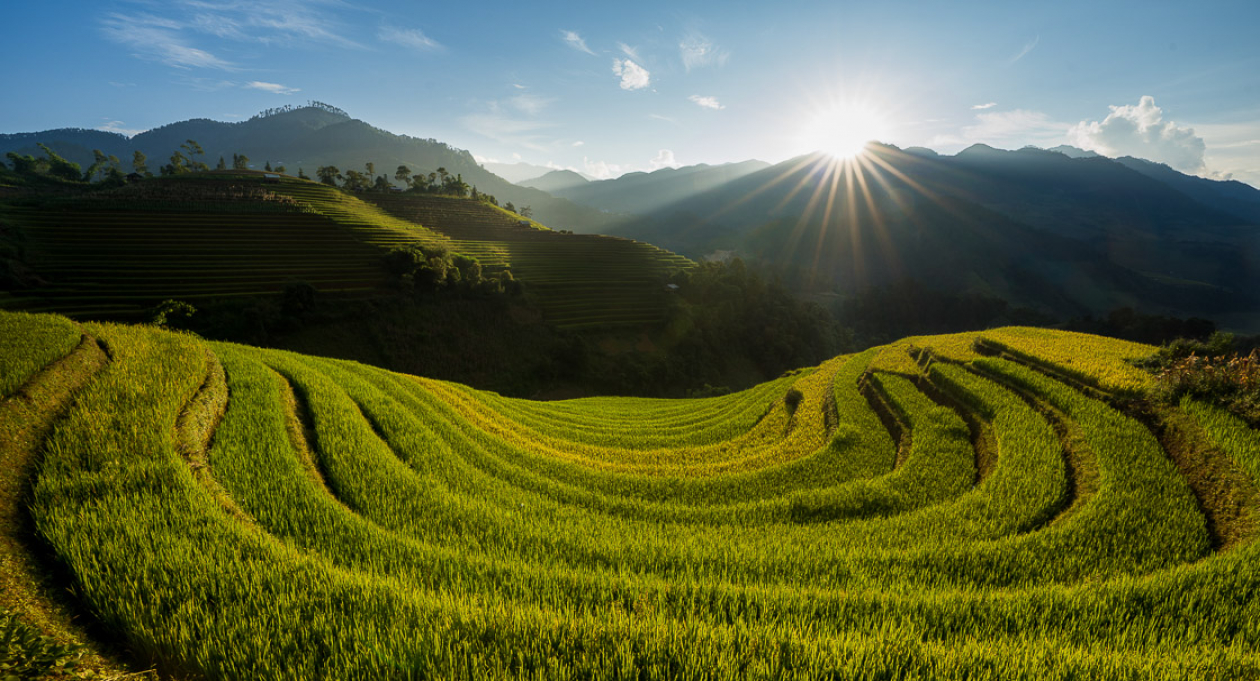
- Places to go
Each Vietnamese city exudes its own distinct character. Get a feel for Vietnam’s fascinating urban centres in these interactive tours.
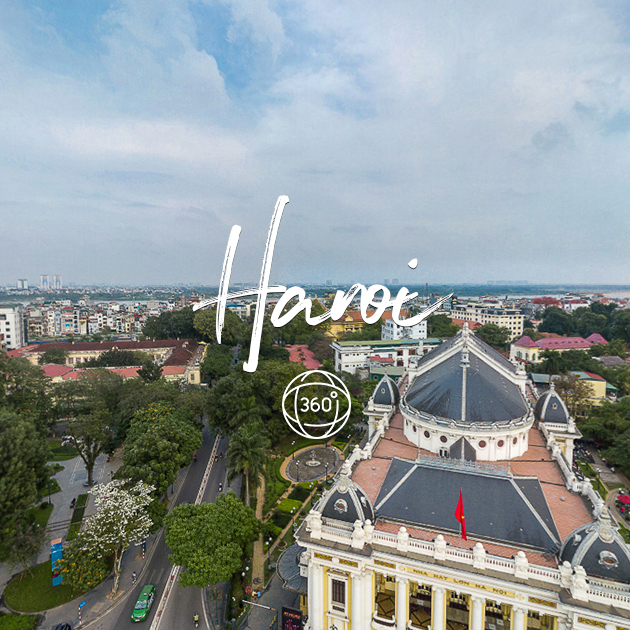
heritage sites
Curious what awaits you in Vietnam? Take a 360-degree tour of some of the country’s most compelling natural wonders and cultural attractions right here.

One of Vietnam’s strongest draws is the diversity of its natural beauty and landscapes.
The capital of Hanoi is your gateway to the treasures of the north: spectacular mountains, valleys and bays studded with limestone karsts. Smack in the centre, up-and-coming Danang is one of Vietnam’s most progressive cities. From here you have easy access to photogenic riverside towns, national parks and long, sandy beaches. The southern metropolis of Ho Chi Minh City will entice you with its cool culture and captivating streets (just watch out for those motorcycles.) Nearby, the Mekong Delta runs to the sea, passing on-the-water villages and mangrove forests along the way. And all down Vietnam's S-shaped coast, you’ll find islands big and small, just waiting to be explored.
Click on a city or region to find out more.
Northern Vietnam
The north of Vietnam makes a statement with majestic mountain ranges, centuries-old rice terraces, and fascinating ethnic groups. Read more
Top Destinations
Central vietnam.
Central Vietnam is known for its well-preserved historical sites, smiling locals, and soothing natural beauty. Read more
Southern Vietnam
From island escapes to non-stop action, southern Vietnam offers both vibrant urban energy and mellow countryside. Read more
- Ho Chi Minh City
Get an insider look at Vietnam’s best destinations. Let these local Vietnamese show you around their hometowns with personal stories, top tips, and must-do experiences.
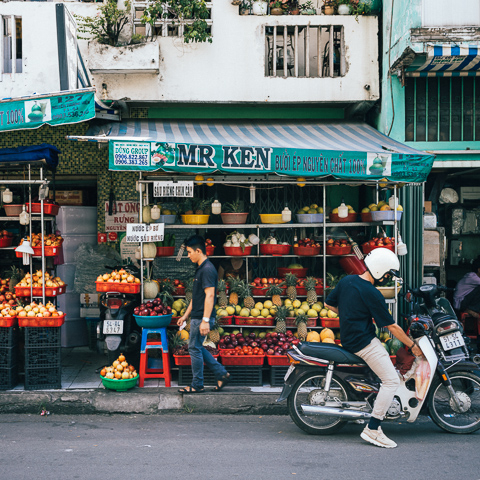
itineraries
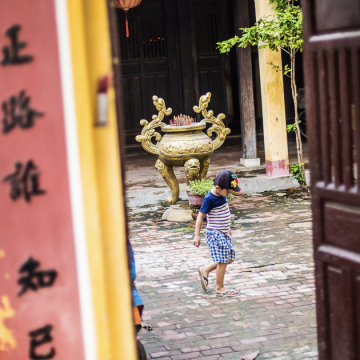
- You are here:
Create an account
Already have an account? Click here to sign in
By clicking submit, you agree to our Privacy Policy and Terms of Use
Sign in with your social accounts
Sign in with your email
Forgot password? Click here to get it back
Don't have an account? Sign up here
Forgot Password
The entered email has subscribed for Vietnam Tourism monthly newsletter

Vietnam Tours & Vacations

Vietnamese food is where it’s at.
Wherever we travel, it’s the flavors we remember best. A crusty bánh mì or streetside pho, seafood cù lao hotpots and (scarily addictive) coffee with condensed milk. Vietnam tours are tasty, plain and simple. We won’t just drop you in Halong Bay and call it a day. Our local leaders will introduce you to rice farmers in Sapa and fishermen on the Mekong Delta. They’ll guide you through the Cu Chi Tunnels, take you to the best beaches and on a street food crawl through Ho Chi Minh City. Our stomach’s rumbling already...
Our Vietnam trips
Let's create an exclusive trip for your group.
Vietnam tour reviews
Filter by rating
Halong Bay Junk Cruise
Vietnam Express Northbound
Three kinds of wow: Twitching in Vietnam
Time and place: Hanoi Old Quarter Market, 5 pm
Creative Cities: Hanoi
Travel globally and think locally with Intrepid leader San Tao
Slow drip: Vietnamese coffee culture
Follow the leader: Tu Vu will never stop learning about Vietnam
Saying yes with Intrepid leader, Huyen Nguyen
Vun Art: Changing lives in Vietnam one scrap at a time
We also travel to
Vietnam at a glance, capital city.
Approximately 98 million
(GMT+07:00) Bangkok, Hanoi, Jakarta
CALLING CODE
Electricity.
Type A (North American/Japanese 2-pin) Type C (European 2-pin)
Learn more about Vietnam
History and government, early history.
Vietnam has been inhabited since prehistoric times. Archaeological finds suggest that structured societies existed as early as the 1st millennium BC. Early society was mostly feudal and agriculture-based, with various dynasties overseeing different parts of Vietnam until the Chinese invasion of 111 BC, which saw the societies of Vietnam and China intertwined. Various Chinese dynasties dominated the area for hundreds of years, although revolts finally led to Vietnam gaining self-autonomy in 905. By 938, this period of Chinese imperial domination came to a close and Vietnam entered into an age of independence.
Recent history
During the 19th century, Vietnam came under the influence of French colonizers, who assumed control of Vietnam after the Sino-French War of 1884 and 1885. French Indochina was formed in 1887, and included parts of Vietnam, Cambodia and, later on, Laos. Although the French managed to suppress internal movements towards independence for many years, their control was finally relinquished in 1954 when Vietnamese forces overcame the French during the first Indochina War. Following this war, Vietnam was divided, with separate forces ruling the north (led by Ho Chi Minh) and the south (led by Ngo Dinh Diem, with support from the United States).
The second Indochina War created wide-scale devastation and turmoil for the people of Vietnam, leading to mass migration to other parts of the world as asylum seekers tried to escape the conflict. More recently, Vietnam has benefited from the free market economy set up in 1986. Vietnam's economy continues to expand, with agriculture and industry providing the backbone and the tourism sector also contributing. Although many Vietnamese people live below the poverty line, there have been widespread improvements in literacy and health, which hopefully will continue to improve.
Geography and environment
Occupying a long, thin part of the Indochinese peninsula, Vietnam shares borders with China , Laos and Cambodia . Much of Vietnam's terrain is mountainous, particularly the north and central highland regions. Although people still choose to live in the densely forested highland regions, most of Vietnam's population is concentrated in the cities of the low-lying areas, where infrastructure is more easily built and the land is fertile. One of the 12 great rivers of the world, the Mekong, runs through Vietnam and has been responsible for wide-scale flooding. A system of canals and levees has been quite successful in redistributing the water during monsoons, and has helped to alleviate flooding in the Mekong Delta and surrounding areas.
Vietnam has a nice mix of interesting markets and small shops, with handicrafts, art and clothing among the best picks.
It's a good idea to check with your local customs officials to ensure that you are able to bring certain items back into your home country. Australia and New Zealand generally have strict quarantine laws.
Things to buy in Vietnam
1. Tailored clothing
Hoi An is one of the best places in the world to get tailor-made clothing at a great price. Find a tailor, choose your fabric, get measured and return later to collect your custom-made fashion.
2. Hilltribe handicrafts
Some of Vietnam's hilltribe people make excellent woven bags, clothing and jewelry which make meaningful souvenirs for friends back home.
As one of the world's largest coffee exporters, Vietnamese coffee is among the world's best. If you’re a coffee fan, why not take a little taste of Vietnam home with you.
4. Lacquerware
The time-consuming, intensive process of creating Vietnamese lacquer art results in a beautiful, smooth and polished finish that adorns everything from bowls to paintings and jewelry boxes. While not the cheapest of souvenirs, authentic lacquer art is worth spending a bit more on.
Culture and customs
Vietnam's ancient culture can be traced back centuries and over the years has been influenced in different ways by the Chinese, Khmer, French and American cultures. For most Vietnamese people, connection to family and community is paramount - whether they are from rural villages or living in fast-paced cities.
Most festivals and holidays are spent with the extended family - participating in rituals, feasting on special foods, giving symbolic gifts and paying respects to ancestors. Most Vietnamese people practice a form of religion that is an interesting mix of Buddhism, Confucianism and Taoism, although there are also a large number of practising Catholics living in Vietnam.
Having endured the hardship that the Vietnam War brought in the 1960s and 1970s, most Vietnamese people are keen to get on with life, living with a sense of optimism and humility.
Similar destinations
Thinking about a trip to Vietnam but still browsing other destinations? Or, maybe you've already been and are looking for somewhere similar?
Cambodia vs Vietnam
Thailand vs Vietnam
Top 10 iconic landscapes of Vietnam
1. hạlong bay.
There's nothing quite like Halong Bay first thing in the morning. As the mists clear, hundreds of huge karst towers appear, looming high above the boat. In the soft morning light, it's like waking up in a watercolor painting of a mythical land. Float along the waters of Halong Bay on our 2 day Junk Cruise.
Jam-packed with imperial sites, Hue is one for the history buffs. Explore the Citadel with its ruined Forbidden Purple City before embracing your inner emperor and taking a dragon boat cruise down the Perfume River. Walk the historic streets of Hue on our 11 day Explore Vietnam tour.
3. Ho Chi Minh City
Still known as Saigon to most, HCMC is a city on the go. It's fast-paced, exciting and full of amazing sites. Temples and markets collide with churches and skyscrapers for a heady mix of traditional, colonial and modern. Explore Ho Chi Minh City's jam-packed streets on our 10 day Vietnam Express Southbound tour.
Motorbikes piled high with people, produce and even animals zip through the streets. It's crazy and haphazard and somehow it works. The best way to take it all in is from a rooftop cafe. Order an extra strong coffee and watch the chaos unfold below. Get lost in the beautiful Hanoi on our 10 day Vietnam Express Northbound tour.
This shoppers' paradise is home to more boot makers, tailors and handicrafts than you could visit in a lifetime. While you wait for your suit to be made, hire a bicycle and explore the Old Town - the streets are blissfully car-free. Shop 'til you drop on our 8 day Premium Vietnam tour or on our 8 day Treasures of vietnam tour.
Head to the hills and see the colorful villages of Vietnam's minority groups - the Zay, and the Blue and Black H'mong. The area is remote so the best way to experience it is on an overnight trek, spending the night as a guest of a local family. Escape to the hills on our 5 day Sapa Adventure or on our 11 day Vietnam: Hike, Bike & Kayak tour.
7. Mekong Delta
This massive area of floating markets, emerald rice paddies and lush islands is home to some of the friendliest people on earth. Take a boat trip to one of the sleepy islands to get a front-row view of life on the Delta, and meet the people who call it home. Adventure through the Mekong Delta on our 2 day Farmstay .
Further reading
Vietnam travel faqs, do i need a covid-19 vaccine to join an intrepid trip.
Trips from 1 January 2023 onwards
From 1 January 2023, Intrepid will no longer require travelers to provide proof of vaccination against COVID-19 (excluding all Polar trips and select adventure cruises).
However, we continue to strongly recommend that all Intrepid travelers and leaders get vaccinated to protect themselves and others.
Specific proof of testing or vaccination may still be required by your destination or airline. Please ensure you check travel and entry requirements carefully.
Do I need a visa to travel to Vietnam?
Most nationalities are required to obtain a tourist visa in advance to travel to Vietnam. When obtaining your visa you should allow 3 weeks for processing with your nearest embassy or consulate. The cost is approximately US$60 to US$100. Please check with your embassy or consulate for further requirements.
Some nationalities are exempt from visas for a stay of a maximum of 15 days, including British, German, French, Spanish and Italian citizens traveling to Vietnam (for all purposes). This exemption is based upon meeting all conditions prescribed by Vietnamese laws. If you are planning on staying in Vietnam for longer than 15 days you will need to obtain a visa extension in advance (please contact your relevant Consulate or Embassy). Please also check the requirements if you plan to re-enter Vietnam.
An e-Visa is available for some nationalities including passport holders from Australia, France, Ireland, Italy, Canada and the United States of America, valid for a single entry of a maximum of 30-day stay in Vietnam. Learn more about the eVisa on the immigration website .
E-Visas take up to 3 days to be processed. You will need a clear electronic copy of your passport data page and passport photo, and to make a non-refundable payment as outlined on the immigration website. Important information Keep the customs and immigration form you receive on arrival, as you need it to complete exit formalities on departure.
If you're traveling with us and your visa application asks for a point of contact, please write: Intrepid Vietnam 5th floor HiPT Building, 152 Thuy Khue Street, Thuy Khue, Tay Ho, Hanoi, Ph +84 4 3715 0996.
Most nationalities do not require a letter of invitation for Vietnam but if you do need one, please contact your sales agent for more information.
The page is for general information only and may be subject to change. It is your responsibility to obtain the relevant visa and travel information required for entry, departure and travel to each country or region you visit on your trip. You should confirm these with the relevant embassies and/or consulates.
Last updated: 31 July 2023
Is tipping customary in Vietnam?
Tipping isn't mandatory or customary in Vietnam, but a tip of spare change or another small amount would be appreciated by restaurants, drivers and other service workers, especially if the service has been particularly good .
What is the internet access like in Vietnam?
Internet access is widely available in tourist areas and big cities, which have many internet cafes. Internet access is less frequent in rural and remote areas.
Can I use my mobile phone while in Vietnam?
You'll be able to use your mobile phone in most urban areas of Vietnam, although remote and mountainous areas may not have network coverage. Ensure you have global roaming activated with your mobile carrier before you leave home if you wish to use your mobile while in Vietnam.
What are the toilets like in Vietnam?
You'll have to adjust to different standards of hygiene and sanitation while in Vietnam. The standard toilet is of the squat variety and this may take some getting used to, although western-style toilets can be found in large hotels and some tourist areas.
What will it cost for a…?
The currency in Vietnam is the Vietnamese Dong. Here's what you can expect to pay for a:
- Quick city bus ride = 5,000 VND-9,000VND
- Local-style coffee at a cafe = 20,000-30,000 VND
- Bowl of pho from street stall = 20,000-70,000 VND
- Dinner at a simple restaurant = 100,000-250,000 VND
- Dinner at an up-market restaurant = 300,000+ VND
Can I drink the tap water in Vietnam?
It is generally not safe to drink the tap water in Vietnam. For environmental reasons, try to avoid buying bottled water. Fill a reusable water bottle or canteen with filtered water instead. Ask your leader where filtered water can be found; some hotels we stay in may have drinking water available. It's also advisable to avoid ice in drinks and peel fruit and vegetables before eating.
Are credit cards accepted widely in Vietnam?
Major credit cards are widely accepted by large shops, hotels and restaurants in Vietnam. However, they may not be accepted by smaller vendors such as small family restaurants, market stalls or in remote towns and rural areas. Make sure you carry enough cash for purchases, since credit cards aren't always an option everywhere in Vietnam.
What is ATM access like in Vietnam?
ATMs are found widely throughout Vietnam, so withdrawing cash shouldn't be problematic in most areas. Some smaller villages and rural areas may not have ATM access, so prepare for this before venturing too far from a city or major town.
Do I need to purchase travel insurance before traveling?
Absolutely. All passengers traveling with Intrepid are required to purchase travel insurance before the start of their trip. Your travel insurance details will be recorded by your leader on the first day of the trip. Due to the varying nature, availability and cost of health care around the world, travel insurance is very much an essential and necessary part of every journey.
For more information on insurance, please go to: Travel Insurance
What public holidays are celebrated in Vietnam?
Public holidays celebrated in Vietnam include:
- 1 Jan: New Year's Day
- 21 Jan: Tết (Vietnamese New Year)
- 21 Apr: Gio to Hung Vuong Day
- 30 Apr: Reunification Day
- 1 May: Labour Day
- 2 Sep: National Day
Please note, Vietnam public holidays may vary.
What festivals are celebrated in Vietnam?
The major festivals celebrated in Vietnam are Tết (Vietnamese Lunar New Year, February), Reunification Day (30 April), National Day (2 September) and Tet Trung Thu (Mid-Autumn Festival, late September).
When is the best time to visit Vietnam?
The most popular times to visit Vietnam are spring (February-April) and fall (September-December) but because of the huge variations in latitude and altitude, there is no one best time to go to Vietnam. It’s a good destination all year.
What's the weather like in Vietnam?
Vietnam has an incredibly diverse tropical climate, and temperatures vary from 39°F in Sapa in winter to humid 97°F days in Saigon in the middle of the dry season. The monsoons bring heavy rain to the south, and a cooler winter to the north depending on when you plan to tour Vietnam.
What are the best things to eat in Vietnam?
Traditional Vietnamese food is typified by its use of fresh herbs and vegetables and its wide regional variance. Vietnamese food is influenced by its Chinese and Khmer neighbors and echoes French colonization. Some of the best things to eat in Vietnam are noodle soups (pho, bun mam, bun bo hue), bread rolls (banh mi), savory pancakes (banh xeo) and fresh tropical fruits.
What are the best things to drink in Vietnam?
Our list of best things to drink in Vietnam includes ice coffee, fruit smoothies, fresh coconut juice straight from a freshly cracked green coconut, sugar cane juice, local beers and artisan rice wine.
What to wear in Vietnam?
While the tropical climate lends itself to layered, breathable clothing all year round, if you are taking a tour in the North, cold winters mean you might need to bring a fleece or jacket.
What kinds of transport will I be using in Vietnam?
Intrepid believes half the fun of experiencing a new country is getting there, and getting around once there! Where possible, Intrepid uses local transport options and traditional modes of transport - which usually carry less of an environmental impact, support small local operators and are heaps more fun. Depending on which trip you're on while in Vietnam, you may find yourself traveling by:
- Overnight sleeper train
Traveling aboard an overnight sleeper train is a fun way to journey through Vietnam. Interact with other passengers or sit by a window and watch the world go by.
Curious? Click here read more about what to expect on an overnight train.
Take time to wave to locals as you cycle at a leisurely pace past rice paddies and through simple villages in rural Vietnam
These 3 wheeled vehicles are a great way to zip around the sights.
What kinds of accommodation will I have in Vietnam?
Traveling with Intrepid is a little bit different. We endeavor to provide travelers with an authentic experience to remember, so we try to keep accommodation as unique and traditional as possible. When traveling with us in Vietnam you may find yourself staying in a:
- Overnight boat
Sleeping aboard a boat on Halong Bay is a quintessential Vietnamese experience to be savored. Slip into relaxation mode as you take in stunning views of the surrounding limestone karst scenery.
Get acquainted with the Vietnamese way of life while on a memorable home stay. Be exposed to new languages, cuisine and customs while making friends with your hosts and neighbors.
Is Vietnam a LGBTQIA+ friendly destination?
The LGBQTIA+ community is gradually gaining recognition in Vietnam, with gay pride parades becoming a regular occurrence and a lift on same-sex marriage bans in 2015. With that said, Vietnam is still a conservative culture and many still hide their sexuality from their families. Ho Chi Minh City and Hanoi have some gay-friendly bars and events. It's generally recommended that both gay and straight couples resist showing public displays of affection.
For more detailed and up-to-date advice, we recommend visiting Equaldex or ILGA before you travel.
Does my trip to Vietnam support The Intrepid Foundation?
Yes, all Intrepid trips support the Intrepid Foundation. In fact, we make a donation on behalf of every traveler. Trips to Vietnam directly support our foundation partners, Blue Dragon Children's Foundation, Vun Art and WildAct.
Intrepid will double the impact by dollar-matching all post-trip donations made to The Intrepid Foundation.
Blue Dragon Children's Foundation Blue Dragon Children's Foundation is helping disadvantaged youth in Vietnam, fighting the causes of human trafficking and (where possible) reuniting homeless or trafficked children with their families. Donations from our trips help their team of social workers, psychologists, teachers, and lawyers to offer individualized support to every child rescued.
Find out more or make a donation
Vun Art Vun Art empowers people with disabilities in Vietnam through vocational training and employment opportunities. They teach traditional folk painting using recycled materials which provides job opportunities, helps to preserve the ancient artform and cares for the local environment all at once. Donations from our trips support Vun Art's capacity-building programs for people with disabilities, including trainees' allowance, transportation, and equipment.
WildAct protects migratory birds of Vietnam and reduces illegal hunting by educating local communities about the importance of conservation. Donations from our trips help WildAct run educational programs to stop the illegal hunting of threatened migratory birds through knowledge-sharing in local communities.
Is Vietnam accessible for travellers with disabilities?
Intrepid is committed to making travel widely accessible , regardless of ability or disability. That’s why we do our best to help as many people see the world as possible, regardless of any physical or mental limitations they might have. We’re always happy to talk to travelers with disabilities and see if we can help guide them towards the most suitable itinerary for their needs and where possible, make reasonable adjustments to our itineraries.
Despite having a high population of people with disabilities, accessible infrastructure and facilities are still limited in Vietnam. Chaotic traffic and pavements blocked by parked motorbikes and street stalls, uneven footpaths and high curbs add to the challenges of getting around for travelers with mobility or vision disabilities. Most entrances to hotels, shops, restaurants and tourist sites will have steps and many doorways will not be able to accommodate wheelchairs wider than 60cm. Some sights and destinations will not be fully accessible (ie. Ha Long Bay boats, Cu Chi Tunnels) but other places such as Hoi An are flat and much more wheelchair-friendly. There are likely to be situations where travelers with disabilities may need to rely on local people to help. Taxis are readily available and an affordable way to get around for travelers who are not confident in exploring independently on foot.
How do I stay safe and healthy while traveling?
From Australia?
Go to: Smart Traveller
From Canada?
Go to: Canada Travel Information
From the UK?
Go to: UK Foreign Travel Advice
From New Zealand?
Go to: Safe Travel
From the US?
Go to: US Department of State
The World Health Organisation also provides useful health information.
What is it like traveling on a small group tour?
Whether you’re a seasoned traveler or you’re about to embark on your first trip, traveling can be as intimidating as it is exciting. That's the beauty of a small group tour. From handling the logistics and organizing amazing cultural activities to local leaders who know each destination like the back of their hand (like which street has the best markets and where to get the most authentic food), traveling on a small group tour with Intrepid will give you unforgettable travel experiences without the hassle that comes with exploring a new place. Plus, you'll have ready-made friends to share the journey with. All you have to do is turn up with a healthy sense of adventure and we’ll take care of the rest.
Wander-Lush
Northern Vietnam Off the Beaten Track: 15 Alternative & Underrated Destinations for Your Travel Itinerary
Searching for the ‘authentic’ Vietnam? Curious to escape the path well-Instagrammed and see a different side of the country? Or perhaps you want to spread your tourism dollars by supporting emerging destinations and small communities. Whatever your motivation, there’s a way to see Vietnam off the beaten track.
While Ha Long Bay, Sapa and Ninh Binh are musts for any first-time visitor to Vietnam’s travel itinerary, sometimes it pays to shrug off the crowds and look beyond the major hubs.
From underrated cities to lesser-known mountain regions and rising ecotourism stars – from the best outdoor activities to living history lessons and hands-on cultural encounters – here are 15 of my favourite underrated destinations in Northern Vietnam .
Also read: 5 places you can’t miss in south Vietnam .
More from Vietnam
Discover the best city guides, itineraries, travel tips & hidden gems in my Vietnam Travel Guide.
Please note: This post contains affiliate links, meaning I may earn a commission if you make a purchase by clicking a link (at no extra cost to you). Learn more.
15 destinations where you can experience Northern Vietnam off the beaten track
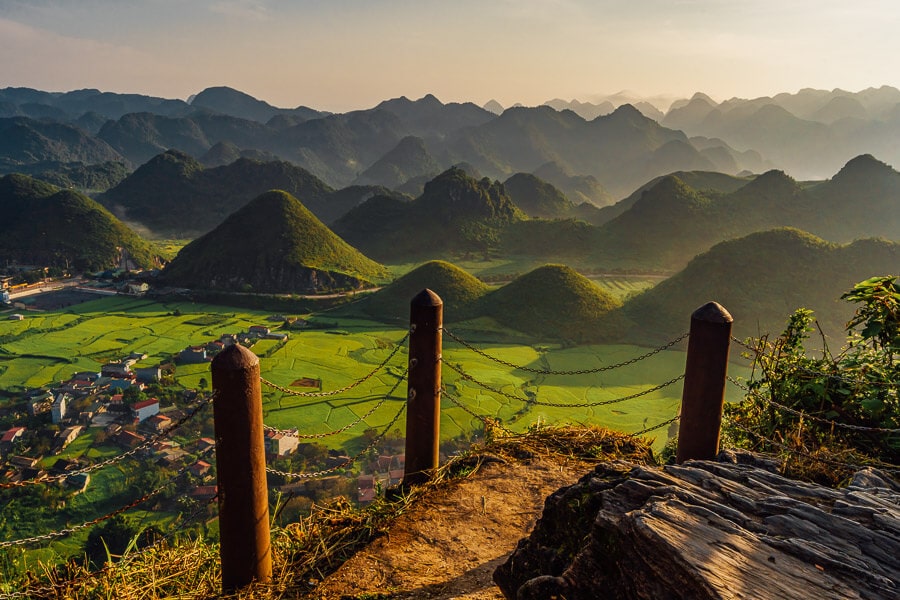
All but isolated from the rest of the country until the 1970s, you often hear Ha Giang described as Vietnam’s ‘final frontier’. The northern part of the province forms a natural land border with China and is characterised by soaring mountains, steep ravines, and the incredible Dong Van Karst Plateau.
Ha Giang is typically navigated by tracing the Dong Van Loop, a circuitous route that leads motorbike riders through some of Vietnam’s most majestic landscapes. It’s well worth stopping off in villages to indulge in some of the best trekking Vietnam (or anywhere else in Southeast Asia, for that matter) has to offer.
Overall, Ha Giang is yet to be touched by the heavy hand of tourism – but things are changing fast, and Dong Van is poised to become the next Sapa. Now might be your last opportunity to experience Ha Giang’s ethnic minority markets (an alternative to Bac Ha ) and family-run homestays . If you do decide to visit, make sure you choose a responsible tourism provider.
Read more: Touring Ha Giang with YESD, a responsible tourism enterprise .
How to get there: Limousine bus from Hanoi (6.5-7 hours travel time) → Buy your tickets online here through Get Your Guide . Where to stay: Cọ Home (Ha Giang) → Check prices here on Booking.com . Tour option: Private tour with YESD Vietnam (various itineraries from 2-7 days), including transfers from Hanoi, full accommodation/board and an English-speaking guide → See the website for details .
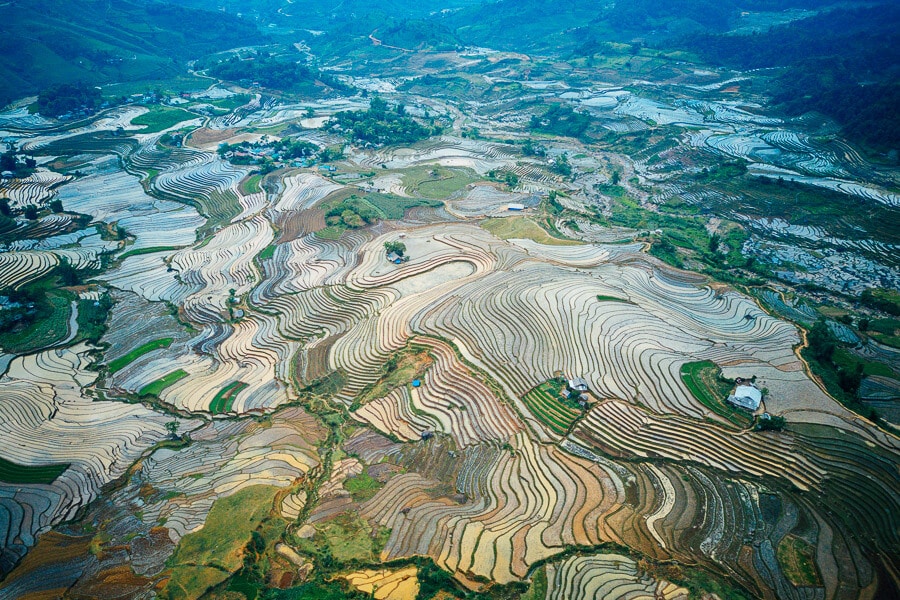
Located in remote Bat Xat District , I predict that Y Ty will emerge as another alternative to busy Sapa at some point in the future. The area boasts picturesque landscapes, idyllic hamlets, and because of the high altitude, opportunities to ‘chase the clouds’ – a popular pastime in Vietnam which involves snapping photos on misty mornings.
While Y Ty remains underdeveloped and tricky to access outside of group tours for now, a handful of NGOs, including CIRUM, are partnering with ethnic minority groups in the area to introduce sustainable tourism.
These projects run parallel to a legal program that’s working to secure land rights for members of ethnic minority communities, a pressing issue in this part of Northern Vietnam and a mission that’s certainly worth supporting.
How to get there: Sleeper bus or VIP minivan from Hanoi to Lao Cai (5.5-6 hours travel time) + transfer → Buy your bus tickets online here through Bookaway . OR Chapa Express sleeper train from Hanoi + transfer → Buy your train tickets online here through GetYourGuide . Where to stay: Homestay xá Hà nhì → Check prices here on Booking.com .
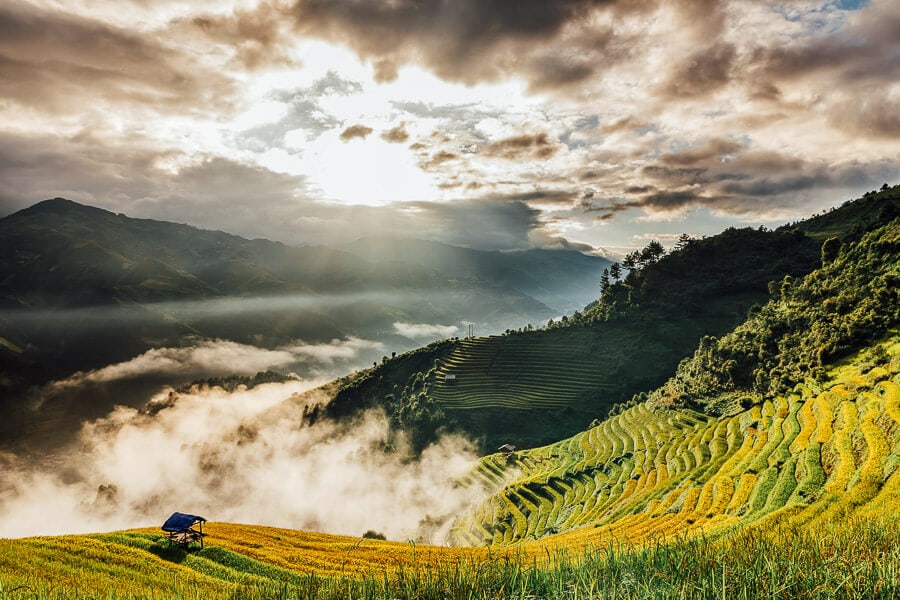
Mu Cang Chai
If you’ve seen those jaw-dropping photos of rice terraces in Vietnam, there’s a good chance they were snapped in or around Mu Cang Chai. You’d be hard pressed to find fields on this scale anywhere else in the country.
Rendered in shades of bottle green or wattle yellow depending on the time of year, the towering terraces are a weather beacon for the changing seasons and different stages of the rice harvest. What happens out here dictates the fortunes of hundreds of thousands of Vietnamese farmers.
Because of its remote location, Mu Cang Chai District receives relatively few tourists. But if it’s sublime hiking in complete solitude that you’re after, it’s worth the trek.
How to get there: Sleeper bus or minivan from Hanoi (7.5 hours travel time) → Buy your tickets online here through Bookaway . Where to stay: Hello Mu Cang Chai Homestay → Check prices here on Booking.com . Tour option: Private two-day tour with trekking and photo stops, including transfers from Hanoi and homestay accommodation → Book here through GetYourGuide .
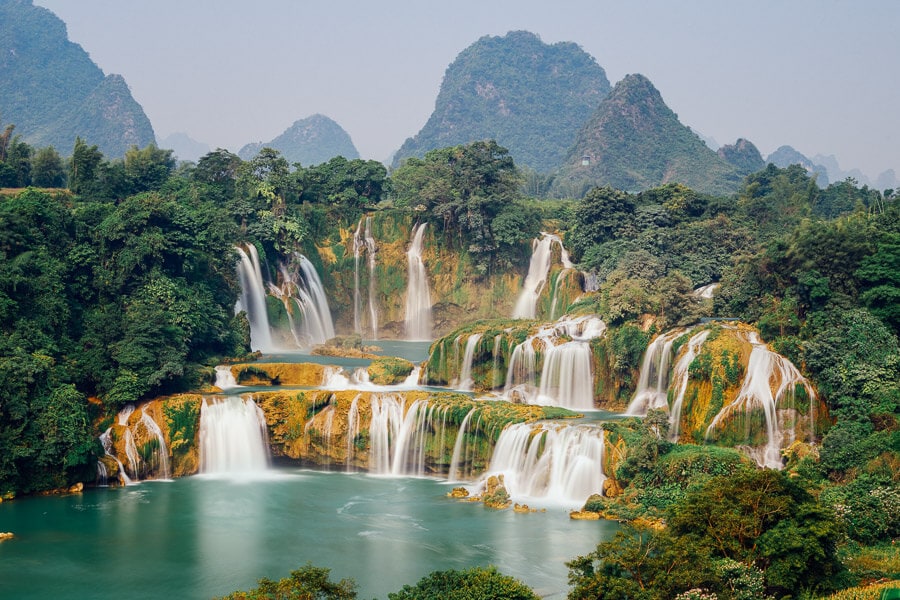
Detian Waterfalls (Ban Gioc)
Indisputably the most majestic waterfall in Vietnam, the Detian cascades (AKA Ban Gioc falls) are located on the Vietnam-China border in north-east Cao Bang Province.
The waterfalls appear vastly different depending on what time of year you go: In the dry season, there are two distinct waterfalls but in the wet season, the deluge gives the appearance of one giant cascade. The 30-metre sheer drop makes this the fourth largest waterfall along a national border after Victoria Falls, Niagara and Iguazu.
Nearby Cao Bang city is a great base to explore the Detian falls and other smaller waterfalls and lakes in the area.
How to get there: Sleeper bus or VIP minivan from Hanoi to Cao Bang (5.5-7 hours travel time) + transfer → Buy your tickets online here through Bookaway . Where to stay: Yến Nhi Bản Giốc Homestay → Check prices here on Booking.com. Tour option: Three-day tour to Ba Be Lake & Ban Gioc Waterfall, including private transfers from Hanoi, a boat trip on the Nang River and full accommodation/board → Book here through GetYourGuide .
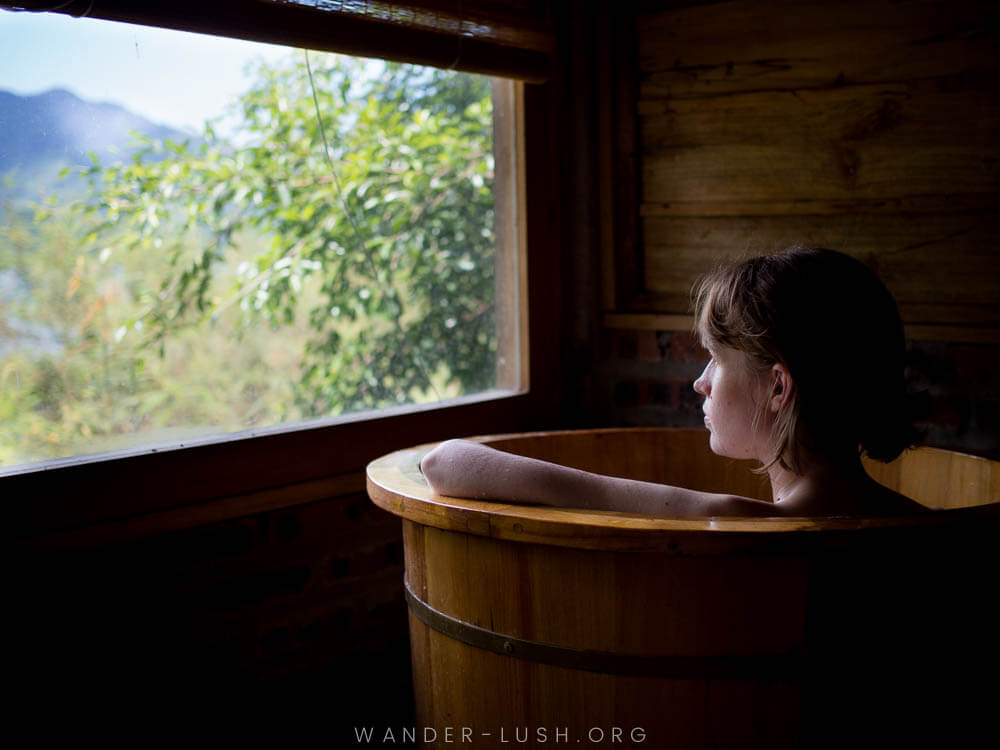
A few years ago, three communities in Da Bac District, Hoa Binh Province formed an alliance to bring tourists to their villages. Their project, Da Bac Community-Based Tourism , is a perfect example of how alternative tourism can thrive.
Visitors to Da Bac can enjoy homestays, delicious home-cooked meals, trekking, water sports (two of the villages have access to the Da Bac River and lake), and cultural activities. Or you could copy me and steep yourself in a wooden tub filled with steaming water and herbs. The bathing ritual is an ancient Red Dao herbal remedy said to improve circulation and general health.
Da Bac is visited by some group tours, but it’s still very much considered to be off the beaten track. Families here need support from tourists like you in order to keep their project afloat. If you’re interested in giving back to ethnic communities while you’re in Vietnam, Da Bac is the perfect place to do it.
Read more: Our terrific homestay experience in Da Bac .
How to get there & where to stay: Multi-day itinerary with Da Bac CBT, including transfers and full room & board → See here for details .
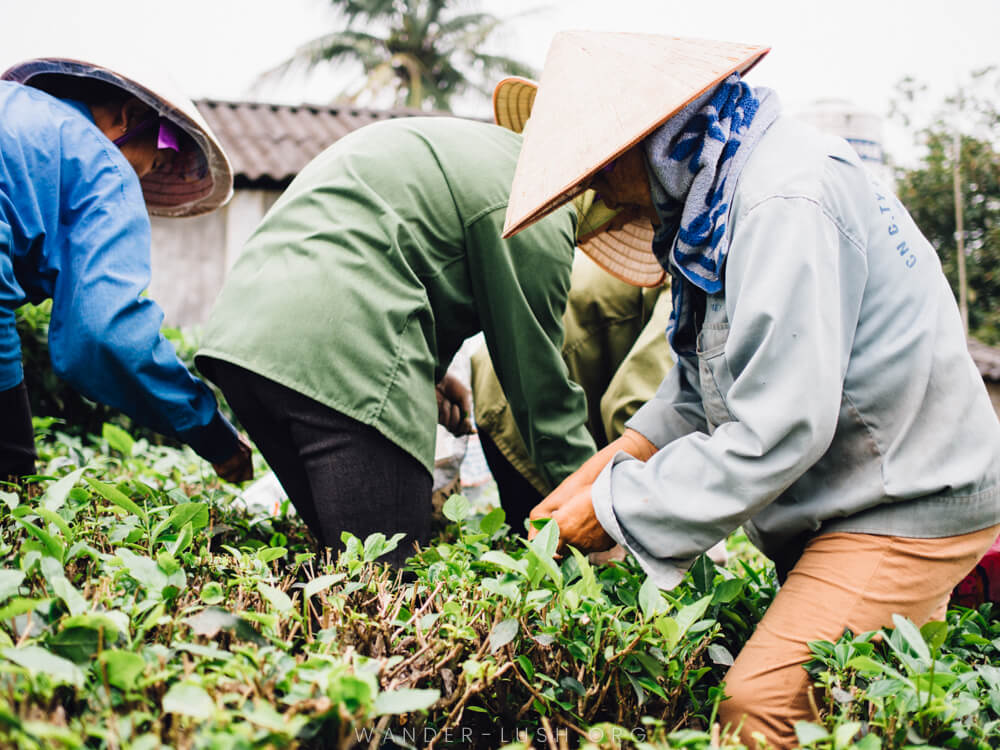
Thai Nguyen
Most people associate Vietnam with coffee . But before French colonisation, it was a tea-drinking nation. Thai Nguyen Province, just north of Hanoi, is the hub of the country’s tea industry and grows much of the green tea that Vietnam exports. You can find packets of loose leaf bearing the province’s name all over Hanoi and Northern Vietnam.
There are dozens of privately owned tea plantations located close to Thai Nguyen city, itself a modest urban area. Owners welcome guests to sit down for a tea tasting before walking them through the fields to watch the pickers at work.
Thai Nguyen is also home to the Museum of the Cultures of Vietnam’s Ethnic Groups and the intriguing Thai Hai Tay Ethnic Village. I highly recommend both.
How to get there: Taxi or minivan from Hanoi (1.5-2 hours travel time) → Buy your tickets online here through Bookaway . Where to stay: Nam My Van Homestay → Check prices here on Booking.com .
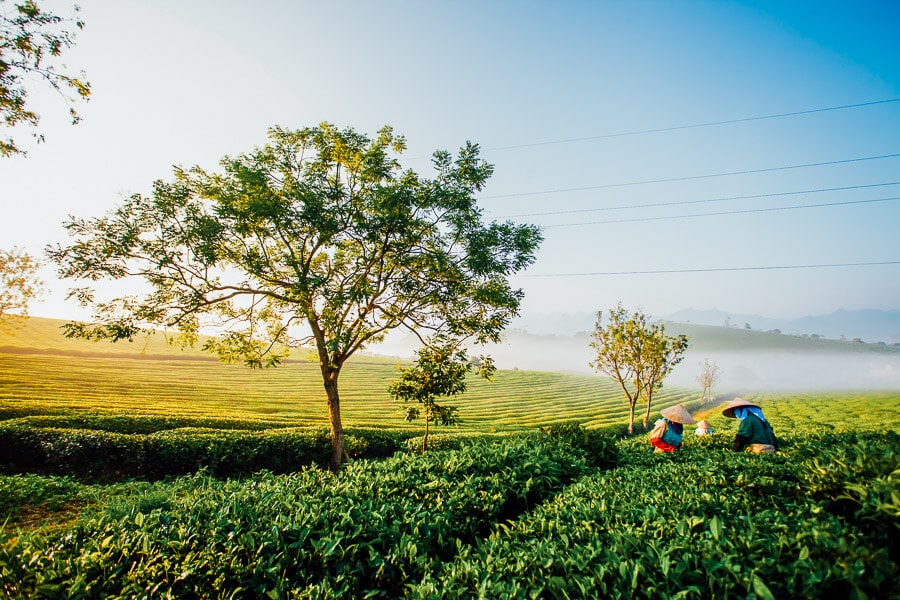
Poor old Moc Chau District is almost completely overshadowed by neighbouring Mai Chau. Located less than 100km up the road in Son La Province (but admittedly a little harder to reach by public transport), Moc Chau is a great alternative to the tourist-heavy Mai Chau Valley.
The best time to visit Moc Chau is in the spring, when the landscape is engulfed in blooming cherry blossoms. Other varietals paint the hills different shades at other times of year.
Like Thai Nguyen, Moc Chau has something special in stall for tea lovers : Verdant tea hills run to the horizon. Visit during the harvest season to watch workers busy in the bushes.
How to get there: Bus or VIP minivan from Hanoi (5-6 hours travel time) → Buy your tickets online here through Bookaway . Where to stay: Hillside House → Check prices here on Booking.com . Tour option: Three-day Moc Chau and Mai Chau tour from Hanoi, including private transfers, meals and bungalow accommodation → Book here through GetYourGuide .
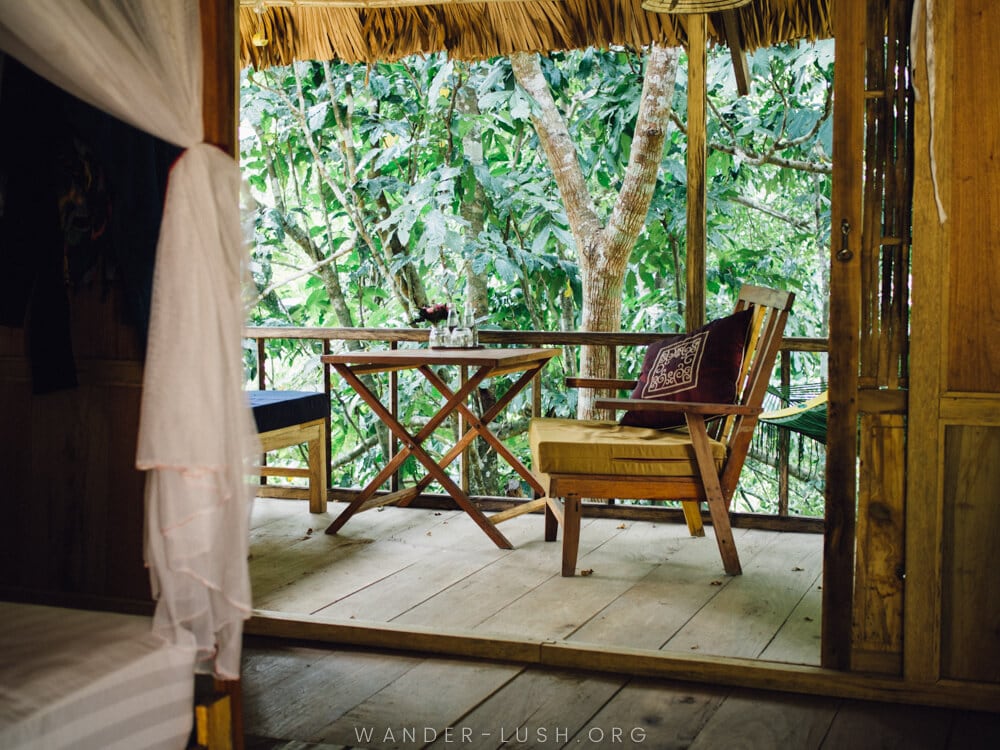
Pu Luong Nature Reserve
Pu Luong is probably the most pristine patch of land I saw during my time in Vietnam. Protected since 1999, the 17-odd hectare reserve is valued for its flora and fauna.
A number of ethnic Thai and Muong communities dwell inside the park’s boundaries, following a largely traditional lifestyle. Among their pursuits is building the incredible bamboo water wheels that Pu Luong is known for. These magnificent structures harvest water from low-lying streams, filtering it into the rice fields via a series of bamboo pipes. It really has to be seen to be appreciated.
Ancient technology set against virgin forest, verdant fields and thatched-roof hamlets: Pu Luong is exactly the sort of landscape Vietnam dreams are made of.
Access to Pu Luong is fairly limited, which of course is a bit part of its appeal. When we visited in 2018, we only saw a few other tourists. It’s possible to trek through the park on a multi-day hike. There are also homestays where you can base your stay and embark on shorter walks.
Read more: Waterwheels and rice fields in Pu Luong .
How to get there: VIP minivan from Hanoi (3.5-4 hours travel time) → Buy your tickets online here through Bookaway . Where to stay: Pu Luong Ecolodge → Check prices here on Booking.com .
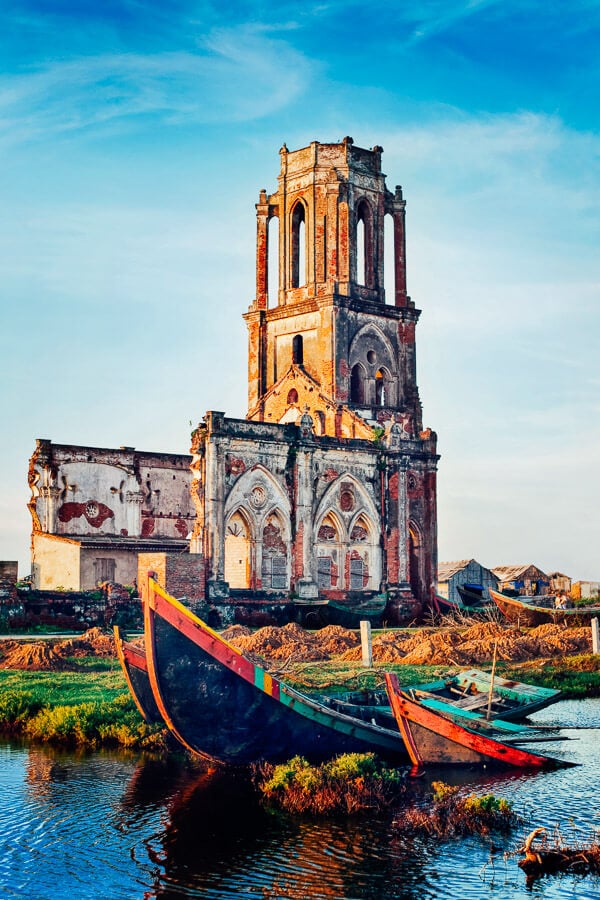
Now there’s a sight I bet you weren’t expecting in Northern Vietnam. Nam Dinh Province, which stretches all the way to the Gulf of Tonkin through the fertile Red River Delta, is famous for its high concentration of Roman Catholic churches. This was the first place missionaries to Vietnam landed in the 1500s, thus Nam Dinh is known as the country’s cradle of Catholicism.
Many of Nam Dinh’s churches are still used by the Catholic community today. Others have been abandoned and left to nature. The architecture in this part of the country is a revelation and something not many tourists get a chance to see.
The most impressive cathedral of the bunch (by my measure) lies in Hai Ly commune. The 1943-built St. Maria Madalena was originally constructed inland, but because of coastal erosion, is now perched precariously on the shoreline.
How to get there: Train, bus or minivan from Hanoi → Buy your tickets online here through Bookaway . Where to stay: SOJO Hotel → Check prices here on Booking.com .
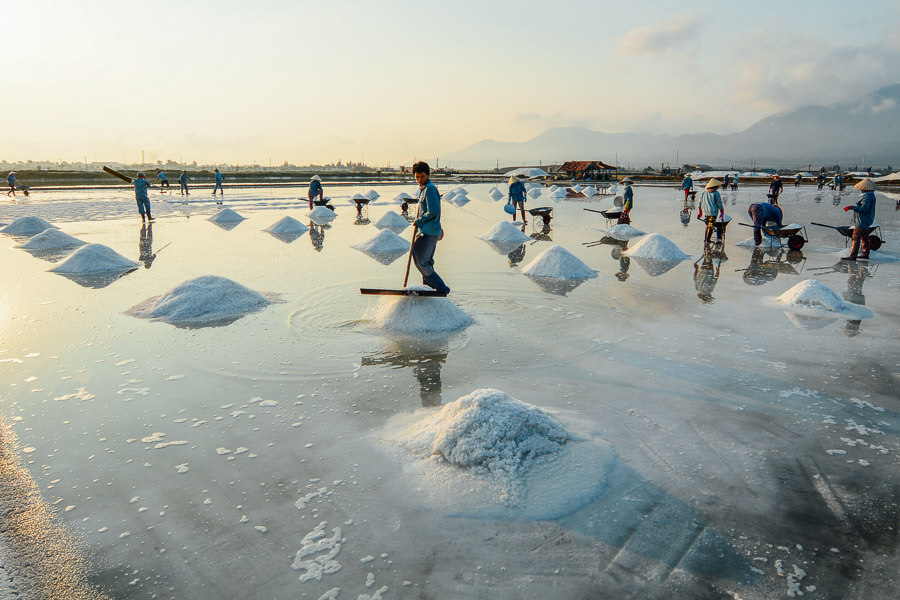
Diem Dien Salt Flats, Thai Binh
You’ve probably heard about Cambodia’s salt pans in Kampot and the Hon Khoi salt fields in Nha Trang, but did you know salt is harvested in Northern Vietnam, too?
It may be one of the country’s poorest provinces, but Thai Binh is a real gem. Located close to Hanoi on the train line to Ninh Binh , the traditional industry along the coastline in villages such as Diem Dien is sea salt.
Every day, hundreds of workers descend on the burnished fields to harvest basket loads of crystals. A visit to Diem Dien and the other salt villages in Thai Binh provides some unique photo opportunities. It’s also a window onto one of Vietnam’s most gruelling industries and the lives of those who toil on the salt fields to supply our pantry staples.
How to get there: Bus or car from Hanoi to Thai Binh (2-3 hours travel time) + transfer → Buy your tickets online here through Bookaway . Where to stay: Khách sạn Hoàng Gia → Check prices here on Booking.com .
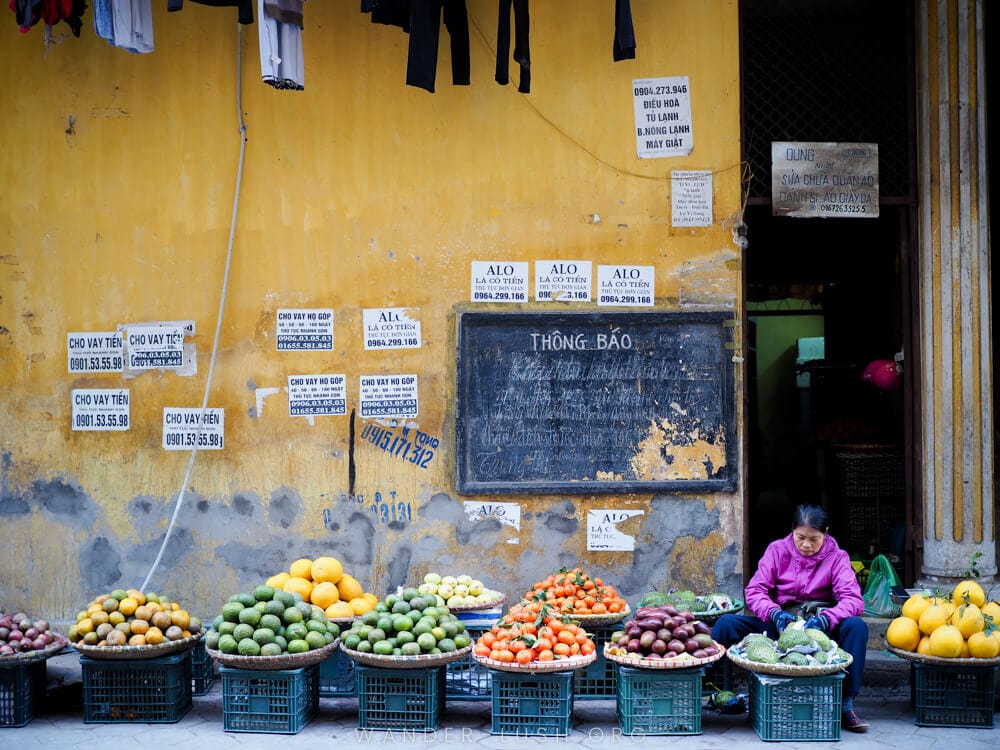
Hai Phong City
Despite being the second-largest city in Northern Vietnam, most tourists skip Hai Phong, using it as a stepping stone to Cat Ba Island instead. Cat Ba wasn’t exactly my cup of tea (hence it’s absence from this list). Hai Phong , on the other hand, utterly charmed me.
I learned from my work colleagues that Hai Phong has a reputation among Vietnamese for being a bit rough – probably because it’s a port city. I didn’t get that vibe at all. My impression of Hai Phong is that it has all the charm of Hanoi’s Old Quarter but with less traffic and no tourists.
Highlights include mango-coloured colonial buildings (the French also settled Hai Phong and left their mark here, too), and a bustling marketplace. Hai Phong hosts an annual spring flower festival, which would be wonderful to see.
The road that connects Hai Phong to Hanoi is the best highway in Northern Vietnam, making it a quick and convenient getaway from the capital.
Read more: My quick guide to Hai Phong city .
How to get there: Train, minivan or car from Hanoi (from 2.5 hours travel time) → Buy your tickets online here through Bookaway . Where to stay: HK Apartment & Hotel → Check prices here on Booking.com .
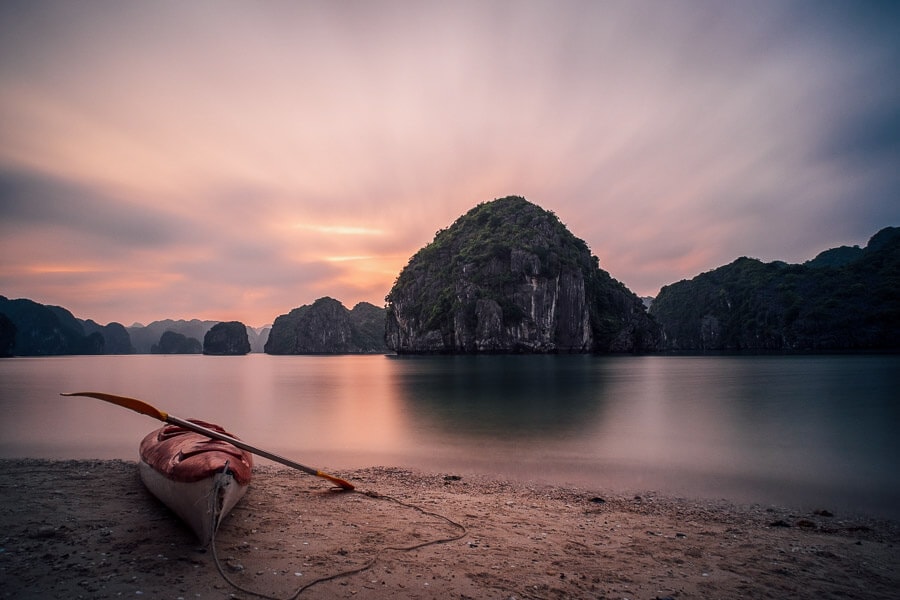
An alternative to busy Halong Bay and budding Bai Tu Long Bay, Lan Ha Bay is a more obscure base for exploring the waters off Northern Vietnam’s coast. The landscape of karst rock formations is almost identical, yet junk boats are far and few between, which means the area is much quieter and less polluted.
Another advantage Lan Ha has over Halong is the multitude of white-sand beaches that crest several of the larger rocky islands. Kayaking, snorkelling and swimming are all available, either as part of a day excursion or a longer overnight stint.
It’s less common to spend a night on the water here: Instead, many people choose to bunk down at a rural homestay or island bungalow.
How to get there: Bus + ferry from Hanoi or Hai Phong to Cat Ba island (2-4 hours travel time) → Buy your tickets online here through Bookaway . Where to stay: Lan Homestay (Cat Ba) → Check prices here on Booking.com . Day trip option: One-day kayaking experience and cooking class on the bay, including transfers from Hanoi → Book here through GetYourGuide .
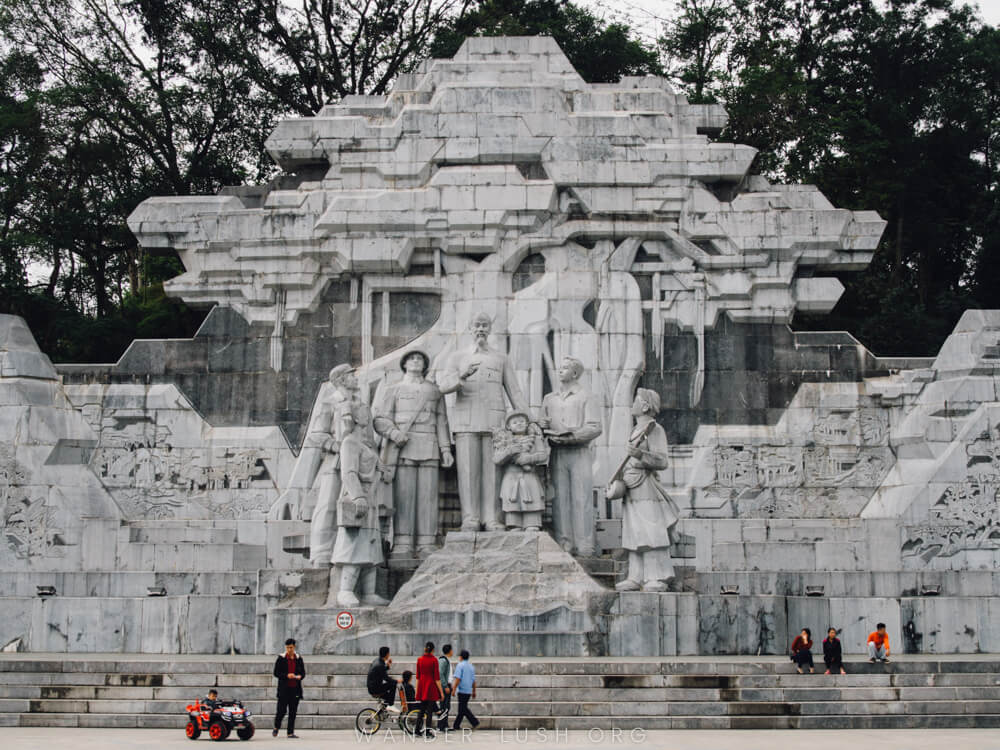
Tuyen Quang
The small city of Tuyen Quang is steeped in revolutionary history. Landmarks such as Hong Thai Temple and Tan Trao banyan tree are tied up with Vietnam’s struggle for independence.
Na Lua, the shack where Ho Chi Minh lived for a period in 1945 while plotting the French resistance, is preserved in Tuyen Quang, and is something of a pilgrimage site for Vietnamese nationalists.
There’s also a cluster of pretty temples and an impressive concrete monument, which has ‘Communist chic’ written all over it. Tuyen Quang might not be everyone’s cup of tea, but I found it intriguing.
Mineral springs and caves can be visited on Tuyen Quang’s outskirts, along with nearby Thac Ba Lake.
How to get there: Local bus from Hanoi (3-4 hours travel time) → Buy your tickets online here through Bookaway . Where to stay: Muong Thanh Grand Tuyen Quang Hotel → Check prices here on Booking.com .
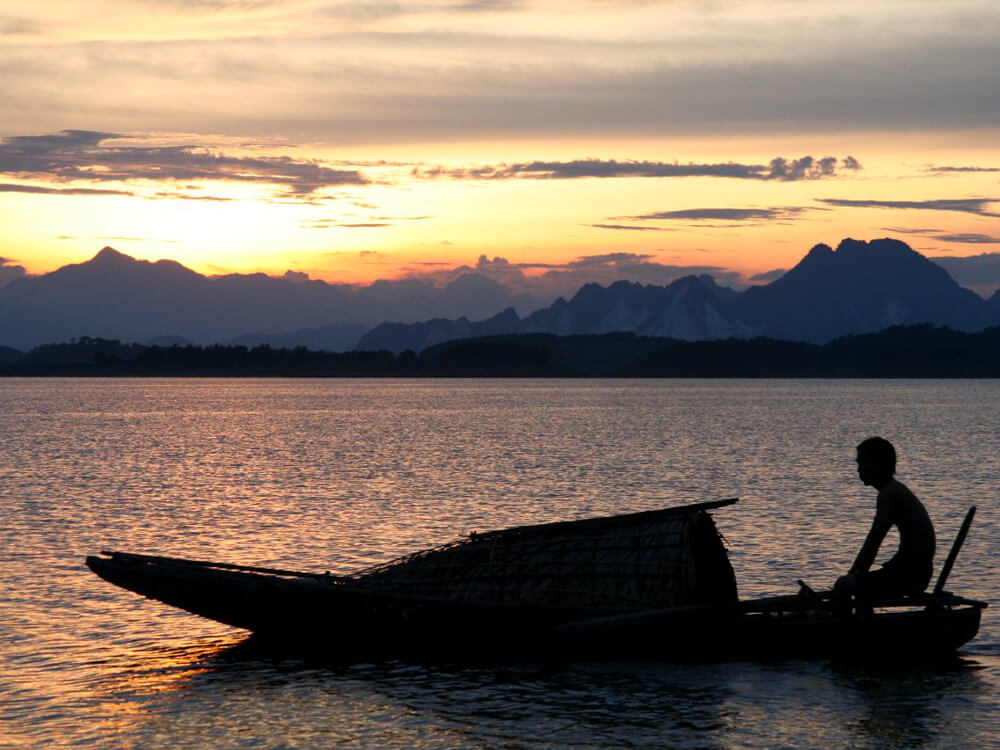
Thac Ba Lake
Located roughly halfway between Hanoi and Sapa, Thac Ba Lake is a man-made lake that was created in the 1970s by way of a hydroelectric dam.
When viewed on Google Maps, the lake looks like a mottled mess. Those jagged blots are actually hundreds of individual islands – 1,300 to be precise – covered in shaggy forest.
Homestays around the lake and in the nearby city of Yen Bai offer boat tours and other water activities for tourists. Vu Linh, a stilted village on the lake, is a nice place to base your stay.
How to get there: Local bus or transfer to Yen Bai + transfer (3-4 hours travel time). Where to stay: Xoi Farmstay (Yen Bai) → Check prices here on Booking.com .
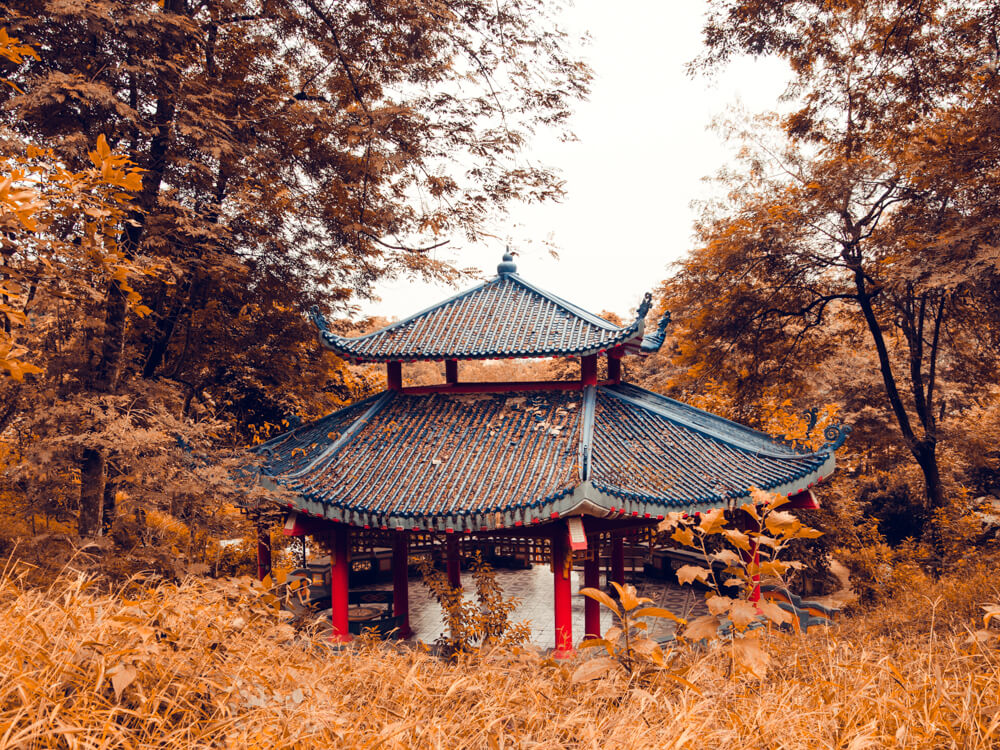
Ba Vi National Park
Just a stone’s throw from Hanoi, it’s a wonder why more tourists don’t take the time to visit Ba Vi, one of Vietnam’s loveliest national parks . Popular with Vietnamese families, especially on weekends and holidays, Ba Vi is something of a local icon. A statue of Ho Chi Minh and a temple dedicated to Uncle Ho sit atop the park’s highest peak.
There are swirling rumours that the independence leader is actually buried somewhere in Ba Vi and that it’s a wax model lying in the Mausoleum in Hanoi. Either way, Ba Vi is a spiritual and auspicious place.
I recommend you take your own transport so you’re free to explore Ba Vi’s winding paths and abandoned buildings at your own pace. There are also a number of hiking trails within the park. If you’re looking for a place to stay the night nearby, I highly recommend Uncle Ty’s Farmstay .
How to get there: Motorbike, taxi or local bus from Hanoi (1-2 hours travel time). Where to stay: Uncle Ty’s Farmstay (Ky Son) → Check prices here on Booking.com . Day trip option: Full day trekking tour from Hanoi with transfers → Book here through GetYourGuide .
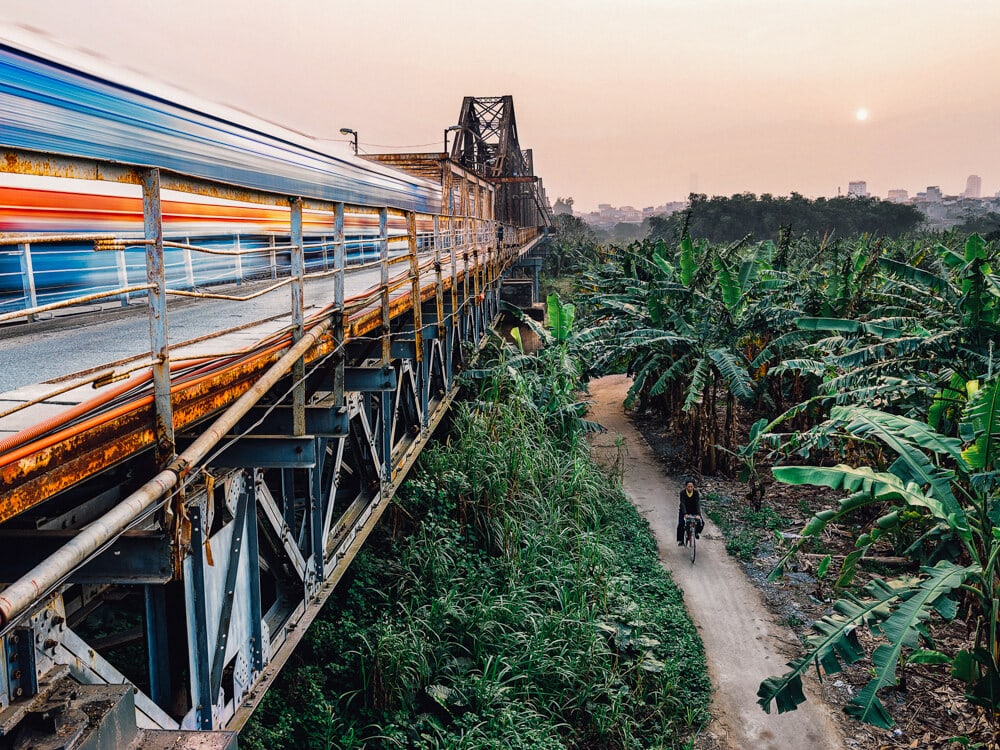
Bonus: Getting off the beaten track in Hanoi
Even if you’re trying to avoid Northern Vietnam’s hotspots, a few days in Hanoi is an absolute must for every first-time visitor . I called this hectic city home for a full 12 months and still only managed to scratch the surface. Hanoi is absolutely huge .
There are plenty of residential areas and historic suburbs where you can escape the chaos of the Old Quarter. Equally, there are a limitless number of ‘secret’ spots hidden right in plain sight – such as Long Bien Bridge and ‘banana island’ – which evade most tourists’ radars.
Wake up when the city rises to see Hanoi from a totally different perspective. Take a day trip to Duong Lam Ancient Village on a weekday to experience a slice of village life.
Spend the night in a beautiful Airbnb to experience Hanoi’s heritage architecture and winding alleyways hands-on. There are plenty of opportunities to get off the beaten track in Northern Vietnam’s biggest metropolis.
Read more: My guides to Ngoc Ha and Truc Bach , my favourite inner Hanoi neighbourhoods.
Map of alternative places to visit in Northern Vietnam
Use the map to start planning your Northern Vietnam off the beaten track adventure.
Click here to open and save a copy via Google Drive .
Vietnam essentials
Here are the booking sites and services I personally use whenever I travel to Vietnam .
FLIGHTS: Find affordable flights to Vietnam using Skyscanner .
VIETNAM VISA: Use iVisa to check if you need a tourist visa for Vietnam and apply for an expedited e-visa online. Use OneWayFly to obtain proof of onward travel/hotel reservation if required.
TRAVEL INSURANCE: Insure your trip with HeyMondo , my preferred provider for single-trip and annual travel insurance.
AIRPORT TRANSFERS: Pre-book a private hotel transfer from Hanoi Airport or Ho Chi Minh City Airport via Get Your Guide.
SIM CARD: Buy an eSIM and data package for Vietnam online before you go. My top choice is the Asia Link Regional eSIM by Airalo (10 GB for 30 days).
ACCOMMODATION: Find the best hotel deals in Vietnam on Agoda or book a Vietnam hostel .
TRAIN TICKETS: Reserve your Vietnam Rail tickets for the train to Sapa , Da Nang, Hue or Saigon via 12GoAsia.
BUS TICKETS: Buy your domestic bus or plane tickets in advance using 12GoAsia or Bookaway .
FOODIE EXPERIENCES: Find the best cooking classes and foodie experiences in Vietnam on Cookly. Here are my top 15 Vietnam food experiences to help you decide.
DAY TOURS: Find the best city tours and day excursions in Vietnam on Get Your Guide. Check out my top 10 best Vietnam day trips for more inspiration.
HALONG BAY: Consult my comprehensive Halong Bay guide to find the best cruises & tours.
VIETNAM GUIDEBOOK: Pick up a copy of the latest Lonely Planet guidebook for Vietnam .
Where is your favourite place to experience Vietnam off the beaten track? Which of these alternative destinations would make it onto your Vietnam itinerary?
33 Comments
Thank you for this very beneficial blog! Keep up the good work.
GREAT photos Emily,
I remember my 3 week moto trip of the northern loop, one of the best travel experiences ive ever had. My ass has never really been the same again! I think we did 200k per day on average.
I found this site as Im reviewing a contract to work in Haiphong, you give it 4 or 5 stars. Ive also heard various slightly offputting comments. I too seemed to bypass it too on the ha long/cat ba 5 day excursion.
I have 2 big questions: what camera and lenses do you use?? your shots are amazing when were you there? Ive been living in Vietnam 8 years, things develop and change so fast.
Im going to read this all properly later, enjoying it … those photos!! Ive only been in the north during Summer , Ha noi is possibly the most hot, humid, still place Ive been in Summer, but thats the big school break. The photo of the bridge in Ha Noi I decided to cross at the tail end of a 10 km city walk, at noon, I was drenched, possibly limping… getting crazy looks from locals. Now I completely avoid the sun here after so many years .
thanks for this great project Mike
Hi Mike, thanks so much for the comment! I was living in Hanoi 2017/18 (had to check my calendar, feels so long ago now!). Well overdue for a return visit. I use a 25mm prime lens for most of my photos. Glad you like them!
I enjoyed Haiphong very much, I’m not sure what it would be like to live there but as a tourist, it was wonderful. Especially as a contract to Hanoi.
Hi Emily, I am really surprised when looking at the list of destinations in your article. As a Vietnamese born in northern Vietnam, these destination names are really familiar to me. But as I am working for a travel agency in Hanoi and contact with many international tourists and almost everyone is very unfamiliar with these places in the north. Glad and grateful for your time in exploring these interesting, authentic lands.
Hi Emily, I read some of your blogs on exploring different parts of Vietnam in length. Each of the blog is awesome. I am travelling to Vietnam, starting from HCMC and flying out of hanoi. I have total of 10 days. Based on your trips, I need lot more days to explore but cant afford that. I want to have mix of city and nearby spots to explore. This is what I have thought: 1. 1 day in HCMC 2. Mekong Delta or Ca Pho – can we do day trip to Ca Pho. I have to come back to HCMC, since I have flight to Da nang. 3. Da Nang to Hoi an & hue. I noticed Da Nang is in middle between Hoi an & Hue. – 2.5 days what is recommended to be based at Hue or Hoi An ? and then do day trip to either of the city 3. Take overnight train to Sapa and spend 1 day there and next day train to Hanoi. Not sure if its feasible or go straight way to Hanoi. 4. spend 2 days in Hanoi and Halong Bay 1.5 days. What do you recommend exploring from Hanoi close by? I dont want to end up on road all the time and chasing activity list. i am travelling with a friend, who is less of an adventure on hiking side but definitely more interested in food exploration being a chef. appreciate your thoughts.
thanks Aarti
My initial impression is that your itinerary is a bit rushed. I’d love to offer you detailed feedback – I have an itinerary planning service if you’re interested. Sorry I don’t have more time to answer your questions in detail! Let me know if you’re interested and we can chat more over email.
Hi Your list of places sounds like what we are looking for. We have one month in Vietnam this December/January . What I am unsure of is if all these places are easily accessible by train or if we need to organise a vehicle. My husband has a friend who hired a driver and toured a similar route. We will be travelling with our 5 year old and 8 year old so need the travel to be fairly simple and safe? What do you recommend. It to travelled in Vitenam 2002 and am after an experience for our family that is not too touristy.
Some are accessible by bus, but you’ll need a driver for others. If you’re travelling with kids, I think a car and driver would be the best way to go!
Ok thanks that’s what we thought. Any ideas which companies offer this service.
Hi Emily, thanks for all the interesting and practical information on your blog. We are traveling to Hanoi for the second time in November. We are considering doing a loop including Duong Lam, Ba Vi, Mai Chau, Pu long and Nhim bin. We wanted an idea of how many days we should allow and which direction to travel first. Much appreciated.
Hi Roschelle, sorry for the delayed reply. I think 1-2 days for each is plenty (maybe 3 days each for Ninh Binh and Mai Chau). Duong Lam can be seen in a day. I would definitely head to Ninh Binh first, then to Pu Luong, and onto Mai Chau (this is the way we travelled too).
Let me know if there’s anything else I can help with!
Hello Emily, I’m so glad I found your blog! We’re heading to Northern Vietnam for 3 1/2 weeks in two weeks with our 10 and 13 years old daughters. We fell in love with Vietnam in 2002 and we’re not sure what we’re going to think of the country after all these years, so we are searching for off thé beating tracks idea… but not too much still because of the kids. We have a Airbnb near the cathédral in Hanoi, but I really want to know where are the great less touristy neighborhood. We will also go to Ta Van, we have 3 days in Bai Tu Long Bay, hopefully a night or two in Haiphong, then a ricefield homestay near Ninh Bin, then Pu Luong. How does it sound to you? Anything we should change since we still have a few days to cancel any reservation? Should we cut off time in Tavan to stop to Mu Cang Chai ? Is Moc Chau worth the drive with children? Thanks a lot!
Hi Isabelle! Awesome. I bet you’ll find things have changed a lot!
My favourite Hanoi neighbourhoods are Ngoc Ha (where I lived) and Truc Bach. I have guides to both on my site – just look under the Vietnam category.
Mu Cang Chai is spectacular but a long drive. I like the sound of your plan!
Thanks Emily, we’ve changed our last Airbnb to be in Truc Bach!
Great choice! Make sure you eat ‘pho cuon’ at one of the Truc Bach cafes and try State Run Foodshop. Two of my favourites!
Good to read this. We want to stay a month at one spot to ‘feel’ and explore authentic Vietnam. Which place should you suggest? Most places a read about are short stay visit spots.
Hi Ronald, cool! If I were you, I would choose a nice homestay with a family who would be happy to spend time with you. Hoa Binh province might be ideal, since you can easily get back to Hanoi if you need.
A month is a long time – I’m sure you’ll have a great experience!
I’ve been wanting to make it to Southeast Asia, specifically Vietnam, for years but the well-defined tourist trail has significantly deterred me. Thank you thank you for this amazing guide!!
You’re most welcome, Caitlin! Happy travels!
Hi, Thank you for your wonderful blog. I have been volunteering for 2 months in Northern Thailand – with Warm Heart, a non-profit that provides homes and education for HillTribe children. I have loved getting to know Chiang Mai and Phrao. I am going to Hanoi for only 5 days before flying back to San Francisco. On your recommendation, I am staying at Indigo Snail. Now I need to decide whether to go to Halong Bay or spend a day or two in Hanoi. Thanks again!
Wonderful to hear, Debbie! It’s an excellent homestay and Sue is a great host.
Hanoi is a fabulous city—more than enough to keep you entertained.
Enjoy Vietnam!
Hi Emily, I’m grateful for your useful travel blog. I will be visiting Vietnam for my first time in December for 3 weeks. I plan to only be in Northern & Central Vietnam. I’m trying to decide which rural sites for multi-day stays/tours. I’m hoping to do some trekking and exploring culture(textile, food) in these villages. Can you rank Ha Giang, Pu Luong, Ninh Binh region, Phong Nha, and Mu Cang Chai in order of your preference for my itinerary ? I know I can’t see them all and some maybe similar to each other on the list. Thank you for your kind consideration, Althea
Hi Althea, they are all very different and it would be difficult to ‘rank’ them – but Ha Giang is definitely something special. Pu Luong too. The others are quite touristy by comparison with the exception of Mu Cang Chai, which is more difficult to get to.
I loved my two weeks in Vietnam. When leaving, I knew I had to go back as there was so much more to see and understand about the country. This post is so wonderful. And the photos are stunning! All these places look and sound incredible and I hope to get to them all. Though, I did do a hike to Hang En Cave in Phong Nha and it was one of the best experiences I’ve ever had. I can’t wait to go back and see more of that park. Thanks for sharing!
Excellent! I loved Phong Nha too! We were there for New Years and spent the first day of the year cycling through the National Park. It was just perfect. There’s SO MUCH to do in Vietnam! Even I feel like I still need to go back!
Omg, I wish I had this list when I went to Vietnam last year! We got to go to Da Bac which was incredible, we hiked with locals and celebrated Tet with them (their new year). I’m dying to go back so I can visit Son Doong Cave and do some camping.
That’s awesome, Andy! So happy to hear you got to Da Bac. Don’t worry—there’s way too much to see in Vietnam for just one visit. You’ll have to go back! Phong Nha is wonderful, too.
A great post with some different destinations . Loved the imagery too.
These places just look absolutely stunning. I have sadly just left Vietnam, but I will definitely pin this for my next visit!
Thank you so much for this very different post about Vietnam. I have been to Hoi An and really want to see more of the country. Great inspiration for my future travels!
Thanks Elisabeth! Hope you make it back soon!
Yes! The Ha Giang Motorbike Loop was definitely one of the highlights from my trip around South East Asia, if not the best part. Haven’t heard of most of the others, so thank you for sharing 💕
So glad to hear that, Sandy! I love Ha Giang too!
Leave a Reply Cancel reply
Your email address will not be published. Required fields are marked *
- Subscribe to future posts
Best time to visit Vietnam & weather
The weather and the best time to visit Vietnam vary enormously between the north and the south. Depending on where you want to spend most of your time, make sure you are prepared for the weather.
What is the best time to visit Vietnam
The best time to visit Vietnam is from December to April. The temperature is pleasant and there is almost no rain. But the best time to visit Vietnam also depends on where in Vietnam. In the north it can get quite cold in December and January. Therefore, view the weather by month for each region. March is the best month to travel throughout Vietnam.
High season (June-July)
High season for traveling to Vietnam is usually in June and July. Although this is a peak season for the Dutch due to school holidays, the Vietnamese school holidays are also overlapping at the moment. Prepare for busy airports and full flights, especially if you plan to explore more of Southeast Asia while you are there. If you want to travel cheaply, this period, as well as during Tet (early February), may not be the best time to visit Vietnam. You will find that many hotels and flights are fully booked if you look for it at the last minute. With many people on the move, it’s best to plan in advance to get some good deals on flights and accommodation.
Low season (September-October)
This is the cheapest time to fly to Vietnam. Not only can you save a lot on airline tickets, but you also have less crowds during your holiday!
Rain season (monsoon season)
As with most destinations, you can still enjoy Vietnam during the monsoon season (April to October), but there are some reservations. You meet fewer travelers and many more mosquitoes during the rainy season. Negotiating better prices for accommodation becomes easier, and tours can be cheaper, but outdoor activities become soaked experiences. Transport delays happen. Buses may not run during long periods of heavy rainfall, because sometimes roads get flooded and become more dangerous to drive.
Typhoon season
Although nature does not always play by the rules, hurricane season (typhoon season) usually ends every December around December. The start dates depend on which part of Vietnam: north, central or south. In general from August to November and October is generally the most stormy month.
When are the rice fields the most beautiful?
If you have ever dreamed of seeing the beautiful golden rice fields, be on time, the harvest season only lasts 1 month! Vietnam has beautiful rice fields in different locations in the countryside from north to south.
Terraced fields in the mountainous provinces in the north of Vietnam are the best at the end of September and October , when the harvest season starts and then show beautiful colors.
Best time to visit Vietnam per region
North vietnam.
North Vietnam (Hanoi, Halong Bay, Sapa, Mai Chau & Ninh Binh) has a clear winter and summer season. The cool but mostly dry winter lasts from November to April, at an average temperature of 17-22 ° C with the coldest months of January – March. The summer lasts from May to October when it is hot and humid and the region has the most rainfall. July to September are often the wettest months of the year.
Central Vietnam
Central Vietnam (Hoi An, Da Nang, Hue) has warm and dry weather from mid-January to the end of August, with temperatures often reaching mid-30 degrees. During the winter months, rainfall increases with the peak levels in October and November, sometimes in the form of typhoons.
South Vietnam
With temperatures remaining constant throughout the year, the climate in the south (Ho Chi Minh City, Mekong Delta, Mui Ne, Phu Quoc) is split into two simple seasons, wet and dry. The dry season starts in November and ends in April / beginning of May, with a little warmer and more humid at the end of February to May. The wet season lasts from May to early November, with the months of June, July and August receiving the most rainfall of the year.
Weather by month
View the weather each month to see what you can expect when you are in Vietnam. Keep in mind that the explanation below is an estimate of what you can expect in Vietnam, because in practice it happens that, for example, the rainy season starts later or earlier and continues longer or shorter. You can also read more about the holidays and events per month in Vietnam.
During this time of the year, dry and pleasant weather can be enjoyed in most of the country, with the only exception being the northern regions. Temperatures can drop dramatically in these areas, especially in the mornings and late evenings it feels much cooler. This is especially the case for Sapa and Ha Giang. For the best beach weather you have to go to Phu Quoc with guaranteed sunshine. It is good to know that the Halong Bay can be quite blurry at this time of year and you may not get the best views.
The cold mornings begin to disappear in the north and hot dry weather is expected in most of the country. North Vietnam remains an exception and feels colder. Good to know is that while traveling in February during TET (Vietnamese New Year) the majority of shops, museums and restaurants are closed for about a week.
This is high season for travel to Vietnam and the best time to visit. Beachgoers now have a better choice of destinations, with Mui Ne, Con Dao and Nha Trang all getting good weather. Hoi An is also a great beach destination by the end of the month. This is the perfect time to visit Halong Bay, which should have a clear blue sky without haze.
Like March, April is the best time to visit to travel to the country and you will see more crowds, with fantastic weather everywhere.
It is getting hot and May offers a wonderful opportunity to miss the April high season prices. Rain has yet to come, but by the end of the month you can expect a rain shower in the northern and southern regions.
You may get occasional rain in the north and south of the country, but Hanoi, Mai Chau and Halong probably have a clear blue sky most of the time. The best place to be is in Central Vietnam, where the sun is still shining. Very little rain is expected in Lang Co, and Hoi An serves as a beautiful beach destination. Grab your chance in the off season before the school holidays start next month.
Central Vietnam is the best place to be, with hours of sunshine and little rain. The rest of Vietnam is likely to experience some showers, but not enough to influence your pleasure.
Central Vietnam is the best place to visit at this time of the year, although the rest of the country is still worth a visit, if you don’t mind having occasional rain. Although flights can be more expensive, hotels offer great promotions during the Vietnamese low season.
Catch the last sun on the central coast of Vietnam before the rain occurs more often at the end of the month. The north and south are usually very wet at this time of the year, but hotels are cheap.
The sun is returning to the north of the country and this is a great time to go to Sapa or leave the beaten track in Ha Giang. Although this is not the best time for a beach vacation, Vietnam has so much more to offer and traveling in October means you skip the crowds.
The high season begins again and many people head to Vietnam for the colder winter months in the north. By the end of the month, the entire country is generally hot and dry, with the exception of the central region, which can have some showers.
There is still a chance of rain in the central part of the country; however, the rest of Vietnam will be hot and dry. The beach season starts again on Phu Quoc. It is advisable to book early for the Christmas period, because there is not much available.
- Ho Chi Minh City
- Mekong Delta
- Language & travel dictionary
- Electricity
- Internet & calling
- Best travel time & weather
- Hoe does it work?
- Visa on Arrival
- Visa at embassy
- Holidays & Events
- People & minorities
- Flights to Vietnam
- Domestic flights
- Motorbike buy/rent
- Train travel
- 15 most beautiful destinations
- 20 best things to do
- 10 best off the beaten track
- 10 most stunning beaches
- 10 best rice fields places
- 10 best adventures
- 10 cultural experience
- All travel inspiration
- Package trips
- Custom made trip
- Destination Guide
- Essential Guide
- Getting Around
- Vietnam Month by Month
- Inspiration
- Vietnam blog
- Travel tips
- Custom Made Trip
- Day- & Multiple Day tours
- Holiday Packages
- Local Meo Vac Homestay
- Local Dong Van Homestay
- Our Team & Company
- Our Customers & Reviews
Copyright © 2023 Local Vietnam
Start typing and press enter to search
Free ebook vietnam travel guide.


Where To Go In Vietnam With Kids (& Important Planning Tips)
V ietnam is a rich, vibrant country brimming with options to satisfy travelers of all ages and interests, from breathtaking landscapes, beautiful beaches, rich culture and history, to amazing food.
So how do you decide where to go on a family holiday in Vietnam with kids? In this guide you’ll read about some of the best places in Vietnam for families to help you narrow down your choices. I’ll also share some logistical tips to help you craft your family’s ideal Vietnam itinerary.
To give you some context, I’m Vietnamese-American and have visited Vietnam several times. This was the first visit for my husband and kids and it was great to be able to show them the Vietnam I know while also seeing the country through their eyes as tourists.
How long should you stay in Vietnam with kids?
When are you traveling to vietnam with kids, how big is vietnam, getting around on a vietnam trip with kids, where to stay in vietnam with kids, paying for things in vietnam, food in vietnam, best places in vietnam for nature lovers, where to experience vietnamese history and culture, best beach destinations in vietnam, mapping where to go in vietnam with kids, before you go…, planning a family trip to vietnam: getting started.
Before you start planning a family trip to Vietnam, you’ll need to think about a few factors.
If you’re coming from the US and traveling with kids, I don’t usually recommend trips to Asia shorter than 10 days. You lose so much time to travel and jet lag. If that’s all the time you have, it’s recommended to choose two bases to stay in that will allow you to take some interesting day trips.
A more comfortable Vietnam itinerary for families is around 15-20 days. That’ll give you time to settle in and stay in a few different places depending on how fast you like to travel. There’s really no upper limit on how long you should stay in Vietnam with kids. The country offers a huge range of family-friendly things to do, different geography, and even different cuisines.
We spent just over two weeks in Vietnam, plus the time to fly back and forth to our home base on the east coast. The 20+ hours of travel each way and 11 hour time difference were no joke!
Be sure to note the weather when you go to Vietnam – it’s a very long country with very different weather conditions from North to South.
In central Vietnam seasonal floods are an annual event and can be very serious. Wet/typhoon season is a phenomenon. If you want beach time in Vietnam, consider the weather when picking between Phu Quoc and Nha Trang/Da Nang. If Hội An is a must-see, don’t go in Sept/October, when flooding is common.
The other important consideration is how crowded certain places will be when you plan to visit. The Lunar New year is a special time in Vietnam, but prepare for huge crowds, high prices, and reduced hours or closures at some attractions as locals take time off.
We visited Vietnam in December, which offered a nice balance of moderate temperatures without too much rain.
The total area of Vietnam is just a little smaller than Arizona, but its shape makes many popular destinations much further apart. You could cross Arizona by car in about 6 hours east to west and 7 hours north to south.
But from Hanoi to Can Tho, for example? You’re looking at 30 hours of drive time – and Hanoi isn’t even the furthest north area of Vietnam that some tourists visit. Keep this in mind as you plan your trip so that you allow enough time for ground transportation or enough money for domestic flights – more on this next. At the end of this article I’ve included a map showing you where all of the destinations in this article are located.
Once you arrive in Vietnam, it’s fairly easy to get around with kids. Rideshare service Grab is convenient and inexpensive, and private drivers for larger vehicles can be hired easily through any agent, hotel, or tour.
If you want to cover lots of ground quickly between cities, you can also get inexpensive domestic flights. Vietnam Airlines (international carrier), Bamboo (low cost carrier), and Vietjet (low cost carrier) offer many regional flights, with Vietnam Airlines having a stronger record of on time flights.
For a more leisurely pace, you can also take trains in Vietnam to get between the major cities. But they can be much slower than flying. For example, you can get from Hanoi to Hue in just over an hour by air while the same route would take 13 hours by train or bus. But it’s a beautiful ride and there are some luxury train options available that could give you a really unique experience in Vietnam.
There are many different accommodation choices for your trip to Vietnam with kids, from hotels to overnight Ha Long Bay cruises to homestays. You might want to consider booking a few different styles to get a fuller look at Vietnam.
Hotel rooms often accommodate two adults and two children under age 6 but this can vary by property. Children 6-12 are often required to have an additional bed, a second room, or a family suite. Children 12 and up are often considered adults for hotel occupancy. Each hotel will have its own rules, so guests should always consult the hotel’s policy when booking.
One nice thing about taking a family trip to Vietnam is that many hotels – even luxury brands – are extremely affordable. While you might usually skew toward budget-friendly places to stay, Vietnam offers plenty of luxury hotels for under $100 USD per night. Your kids will feel spoilet, and so will you!
While hotels, Grab, large restaurants and tourist shops offer credit card payments, much of Vietnam remains a cash culture. Street food, local vendors, some private drivers and tours, and many markets accept cash only.
ATMs are available throughout the country, but many charge high fees and have low limits on the maximum that can be withdrawn in one transaction. Consider opening a checking account with a bank that reimburses for ATM fees – Schwab is an incredibly popular option among frequent travelers for exactly this reason.
Airports and Banks often offer mediocre exchange rates. The most favorable exchange rate can usually be found in local gold and jewelry shops, which are authorized for currency exchange. Large hotels often offer competitive exchange rates for their guests as well.
Food in Vietnam is diverse, flavorful and vibrant, with many regional specialties and choices for all eaters. Steaming bowls of phở are just the start as you’ll find yourself immersed in an abundance of choices. Street food vendors, night markets, hole-in-the-wall restaurants specializing in one dish, and countless fantastic restaurants are found throughout the country, with many choices for vegetarians and vegans, gluten-free diets.
Do carry a card in the local language if traveling with food allergies or other dietary restrictions – shellfish is used in many classic Vietnamese dishes, and several dishes are garnished with nuts. Larger restaurants in cities are best accustomed to accommodating severe food allergies.
Places to Visit in Vietnam with Family
Halong bay .
This UNESCO World Heritage Site is one of the most iconic backdrops in Vietnam. With hundreds of islands and islets dotting the bay, many with large limestone cave systems to explore, Halong bay is a must see destination for nature lovers. It’s one of my personal favorite places to go in Vietnam because of its unparalleled natural beauty.
Where to stay in Ha Long Bay with kids : There’s no better way to experience Ha Long Bay than by boat. The area offers dozens of choices for one and two night cruises of the bay which include tours and excursions of some of the larger islands, as well as kayaking, swimming, squid fishing, and other onboard activities.
Many 2 night cruises include a visit to Cat Ba Island, where visitors can bike to traditional villages and take in the beautiful scenery. Both adult and children’s bikes and helmets are readily available, and visitors who prefer not to bike can ride an electric cart instead. If you can swing 2 nights rather than one, I definitely recommend it!
Here are some good family-friendly Halong Bay cruise options – take note of occupancy, as some can accommodate a maximum of three people per room:
- Ambassador Halong Cruise – large 5-star boat
- Halong Capella Cruise – offers a family suite for 4 and a modern feel
- Orchid Classic Cruise – 2-night itinerary available, with a variety of room types up to family suites
- Peony Cruises – 2-night itinerary available, with a variety of room types up to family suites
Known as Halong Bay on land, the areas of Tam Cốc and Trang An in Ninh Bình offer stunning vistas steeped in natural beauty. Sampan boats navigate waterways, grottos, and lead to pagodas nestled against mountains. Hiking to Mua Cave and biking around the countryside are also extremely popular, with adult and children’s bikes and helmets available at several locations.
Where to stay in Ninh Bình with kids: Ninh Bình is home to a wealth of incredible homestays, where visitors can immerse themselves in local life and culture in more rural areas. Accommodations can vary between simple to luxurious.
Luxury: Wyndham Grand Vedana Ninh Binh
This is often under $100 per night despite the high-end feel!
- Mid-range: Ninh Bình Hidden Charm Hotel & Resort and Emeralda Ninh Bình Resort
- Budget: Bungalows Tam Coc Horizon Bunglalow
The capital city of Vietnam offers a mix of culture, history, thriving markets and restaurants. Immerse yourself in Vietnamese culture by strolling the Old Quarter, attending a Water Puppet Show, and taking a street food tour. Visit pagodas, the Imperial city of Thanh Long, and have a coffee on train street as trains pass through the city a few feet from your seat.
Where to stay in Hà Nội with kids : The Old Quarter is the perfect place to immerse yourself in the city, and you’ll find plenty of great places to stay in Hanoi with kids at all price points.
- Luxury: Sofitel Legend Metropole Hanoi
- Midrange: La Siesta Classic Ma May
- Budget: Labevie Hotel
Formerly known as the imperial city of Vietnam, Huế boasts a rich history and architecture from the Nguyen Dynasty, the last dynasty of Vietnam. You can visit the Citadel, tombs, and temples, as well as enjoy delicious central Vietnamese cuisine.
Where to stay in Huế with kids : Vinh Ninh – the city center
- Historical French Colonial mainstay: Hotel Saigon Morin
- Mid-luxury: Senna Hue Hotel
- Budget: The Scarlett Boutique Hotel
Hội An
This charming UNESCO World Heritage site is a favorite among tourists for its narrow streets, lanterns, tailors, and beaches. To be clear, you aren’t going to fin a sleepy “hidden gem” like you would have thirty years ago. But I still love it, and I really believe you will too.
One of the finest preserved representations of a Southeast Asian trading port dating back to the 16th century, the ancient town is a remarkable example of blending cultures, with Japanese, Chinese, and Portuguese influence on display along with the indigenous Vietnamese population. The House of Tan Ky is a beautifully preserved 18th century merchant’s home that you can’t miss.
Hội An is also the place to have custom clothes made from some of the finest tailors in Vietnam. On beautiful days, An Bàng beach’s white sands welcome visitors to relax, swim, and snorkel. At night Old Town comes alive with bright lanterns lining the streets and adorning the boats on the water.
Where to stay in Hội An with kids : Base yourself within walking distance to Ancient Town
- Luxury: Mulberry Collection Silk Village
- Mid Range: La Siesta Hội An Resort and Spa
- Budget: Vinh Hung Riverside Resort and Spa
Known as the City of Eternal Spring, Da Lat was a French colonial resort famed for its beautiful flowers and nearby stunning waterfalls. Explore French colonial architecture, stroll beautiful gardens, and visit the iconic “Crazy House,” the whimsical creation of architect Dang Viet Nga.
Where to stay in Da Lat with kids: Phuong 1, the city center
- Luxury: Khách sạn Dalat Palace or Ngoc Phat Dalat Hotel
- Mid Range: CozyNook Boutique Apartments
- Budget: Dalat Wind Hotel or Mỹ Lan Hotel
The third largest city in Vietnam, Da Nang is famed for its beautiful beaches and clear blue waters. The bustling city is also a mecca for shopping and delicious central Vietnamese cuisine. Nearby attractions include the Marble Mountains, temple of the Lady Buddha, and the UNESCO World Heritage site of Mỹ Sơn Sanctuary (Champa temples frequently referred to as the Angor Wat of Vietnam).
Where to stay in Da Nang with kids : Along My Khe beach, or near the Han River Waterfront to enjoy the city.
Luxury: InterContinental Danang Sun Peninsula Resort
Book this hotel for free using the welcome bonus from this credit card !
Mid-range: Hyatt Regency Danang Resort And Spa
- Budget: Yarra Ocean Suites Danang
This south-central beach city itself boasts beautiful beaches and parks, as well as luxurious resorts on the local islands. Hon Tre is home to VinPearl, the popular resort and amusement park. Nha Trang is also rich with diversity, with three of its highest points topped with Cham, Buddhist, and Catholic places of worship.
Where to stay in Nha Trang with kids :
For a family luxury resort experience, VinPearl resort on Hon Tre island has beautiful beaches, an amusement park and many amenities.
For exploring Nha Trang, the long stretch of city along Tran Phu Beach is perfectly situated to enjoy beach, city, and parks in easy walking distance.
Luxury: Intercontinental Nha Trang
- Mid-range: Novotel Nha Trang
- Budget: Ibis Styles Nha Trang
Phú Quốc
Vietnam’s largest and western-most island, Phú Quốc boasts beautiful white sand beaches with a backdrop of tropical forest, national parks, traditional fishing villages, and bustling markets. It’s even home to the world’s longest cable car!
Where to stay in Phú Quốc with kids:
- Luxury: JW Marriott Phú Quốc Emerald Bay
Mid-range: Intercontinental Phú Quốc Long Beach
- Budget: Pullman Resort Phú Quốc
Now that you’ve gotten an overview of where to go on a Vietnam family trip, use this map to help you narrow down your options and put it all together!
If you’re up for an even longer family travel adventure, consider hopping a quick flight across the peninsula to Thailand! There are lots of great sites and experiences whether you’re exploring the hustle and bustle of Bangkok or the quieter northern cities of Chiang Mai and Chiang Rai .
Want to get more helpful travel tips like this? Sign up for our email list!
The post Where To Go In Vietnam With Kids (& Important Planning Tips) appeared first on The Family Voyage .
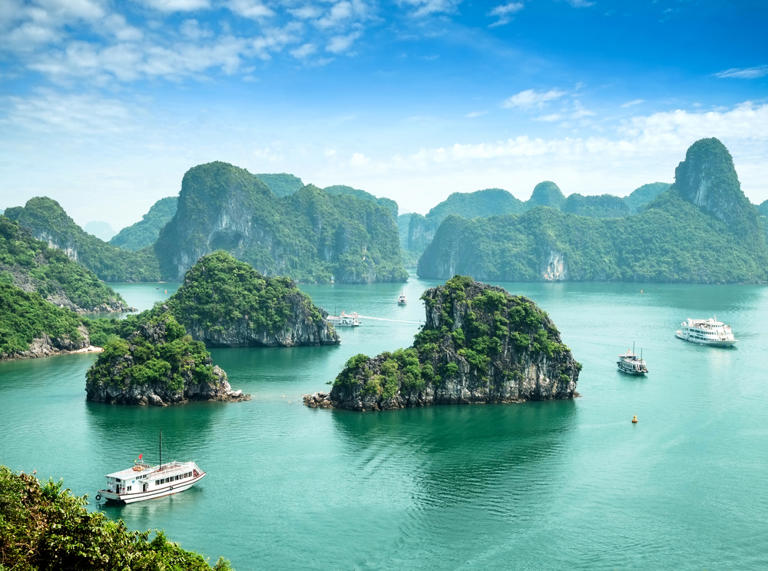

- Forgot your password
- Join Lotusmiles Now
- Search Search Search
Select Region and Language
Country/Region
Best Fare Finder
Hplsecondmegamenu.
- Flights from San Francisco to Ho Chi Minh City
- Flights from San Francisco to Ha Noi
- Flights from San Francisco to Da Nang
- Flights from Ho Chi Minh City to Da Nang
- Flights from Ho Chi Minh City to Hanoi
- Flights from Hanoi to Da Nang
Top Destinations
- Ho Chi Minh city
Popular Countries
- Flights to Vietnam
- Flights to Japan
- Flights to Cambodia
- Flights to Thailand
- Flights to Taiwan China
- Flights to Singapore
- All Countries
Timetable & Route map
- Worldwide route map
The experience
- Business class
- Premium Economy class
- Economy class
- Inflight entertainment

- Hand baggage
- Free checked baggage
- Excess baggage
- Special baggage
- Restricted baggage
- Baggage claim
Online check-in
- Kiosk check-in
- Telephone check-in via hotline
- Airport check-in
Airport & Transit
- Airport guides
- Lotus lounge
- SkyPriority
Travel Guide
- Travel document
- Entry and exit/transit regulations
How to book a flight & make payment
- How to book air tickets online
- Payment methods
- How to refund tickets
- How to change tickets
- How to cancel bookings
Book a flight & Manage booking
- Book a flight
- Manage booking
Fare conditions
- Fare types & rules
- Taxes, fees, charges & surcharges
Additional services
- Vietnam Airlines Sky Pass
- Advance seat selection
- All additional services
Special services
- Travelling with pets
- Special meals
- Infants and children
- Unaccompanied minors
- Passengers with disabilities
- Pregnant passengers
- Passengers with medical conditions
- Special service charges
Member benefits
- Introduction
- Membership benefits
- Membership eligibility
- Lotusmiles Enrollment
- Manage my account
- Family account
- LotuSociety
- Vietnam Airlines
- Airline Partners
- Banking and Finance Partners
- Other partners
- Claim your miles
- Spend and Earn
- Accumulated miles redemption
- Purchase tickets by cash and miles
- Miles redemption for award tickets
- Redeem miles for baggage awards
- Redeem miles for upgrade
- Other miles usage
- Donate miles
Buy & Transfer miles
- Buy qualifying miles
- Buy & Transfer bonus miles
Products & Offers
- Lotus lucky number
- Lotus insurance
- Lotus offers
- Search Vietnamairlines.com
- Travel information
With Online Check-in, passengers can actively check in using Vietnam Airlines' website or mobile app.
To check-in online on the Vietnam Airlines website, passengers follow the steps below.
Step 1: Passengers go to the website vietnamairlines.com , at the "Check-in” section, enter the Reservation Code (PNR) and Family Name, and click "Check in".

Step 2 : Check the information again and select “Start check-in”;

Step 3 : Check the information in the reservation code and supplement frequent customer information, or proceed to check in for another reservation code (if desired).

Step 4 : Confirm consent to the passenger's regulations on baggage restrictions.

Step 5 : Seat selection: Select seats on the seat map. After selecting the desired seats, click “Confirm seats and receive boarding passes”.

Step 6 : At this step, passengers review their itinerary information and keep in mind the time they should arrive at the boarding gate. To receive a boarding pass, click “View boarding pass” and select “Send boarding pass”.

On the "Select how to receive a boarding pass" screen, passengers can choose whether to receive the boarding pass via email in PDF format or as a Passbook card (for use in an iPhone or iPad Wallet).

About Collection and Use of Personal Information
Passengers are required to have adequate travel documents for all flights on all concerned airlines and to abide by national laws and regulations. Vietnam Airlines does not take responsible if passengers are denied entry into any country.
Please visit here for more details.
Agreement Policy
YOU ARE ABOUT TO LEAVE VIETNAMAIRLINES.COM
Otp verification.
This website is using cookies. For the best possible web experience, please provide your authorisation to use our cookies and to permanently remove this message
Click here to find out more about the cookies we use and how to manage them

IMAGES
VIDEO
COMMENTS
10. Ha Giang. Best for mountain views. Trekking to the minority villages in the hills around Sapa is one of Vietnam's top draws, but the country's trekking capital feels rather commercialized these days. Hikers have to walk further every year to find the rural idyll that first drew people to the northwest.
Here are the best times to visit Vietnam for sunny weather, fewer crowds, and activities like hiking in Sa Pa and cruising Ha Long Bay.
4. Phong Nha-Ke Bang National Park. Phong Nha-Ke Bang National Park. One of the best places to visit in Vietnam for caving, World Heritage-listed Phong Nha-Ke Bang National Park is a dramatic karst mountain formation honeycombed with huge caverns, which are home to superb stalactite and stalagmite displays.
BEST TIME TO VISIT VIETNAM. The best time to travel to Vietnam really depends on what you are looking for in terms of weather, scenery and budget. Peak season occurs from mid-December through to February. But expect prices to double during this time. The low season is perfect for those on a budget. Low Season - April to June, September to ...
Ba Be National Park (Near Sapa) Bach Ma National Park (between Dan Nang and Hue) Dong Ha - for DMZ tour (Between Dong Hoi and Da Nang) 2 Week Vietnam Itinerary - 1 Week in the South. Day 1 - Nha Trang. Day 2 - Dalat. Day 3 - Mui Ne. Day 4 and 5 - Ho Chi Minh City. Day 6 and 7 - Phu Quoc Island.
The Mekong Delta. First on the list of places to visit in Vietnam is the mighty Mekong. The Mekong Delta is a biodiversity hotspot and a place of calm. With an almost endless system of rivers and creeks to follow, the Mekong Delta is truly special. Getting to the Mekong Delta from Ho Chi Minh is rather easy and is worth weaving your way out of ...
Live fully in Vietnam. Vietnam opens its door widely to welcome visitors all around the world! Starting from 15th August 2023, Vietnam extends e-visa validity to 90 days and unilateral visa exemption will be valid in 45 days! We are more than happy to welcome you all here and admire our stunning landscapes, free your soul on white sandy beaches ...
3. Ha Long Bay. Landscape with amazing Halong bay, Vietnam. Ha Long, a UNESCO World Heritage Site, is a place of mystical beauty, a myriad of limestone karsts and blue waters. Legend has it that this is the place where dragons decided to descend to rest, as 'ha' means to descend in Vietnamese, and 'long' is dragon.
Here are the top 10 places to visit in Vietnam nominated in 2022. Map of the best places to visit in Vietnam. 1. Ha Long Bay. Off Northeast Vietnam, Ha Long Bay was designated as one of the World Heritage Sites in 1994. For many reasons, Ha Long Bay has to be on your list when you travel to Vietnam. Having been known for thousands of limestone ...
17. Da Nang. Nestled on the central coast of Vietnam, Da Nang is an energetic coastal city with a historic French colonial port. It is known primarily for its fantastic beaches, including the famous My Khe Beach, which Tripadvisor has named as one of the best beaches in Asia.
Check out The Best Time to Travel to Vietnam for complete details! What To Expect. Language: The official language in Vietnam is Vietnamese. Currency: The currency of Vietnam is the Vietnamese Dong. Credit Cards and ATMs: You won't have a problem finding ATMs in Vietnam's big cities like Ho Chi Minh and Hanoi. Most ATMs accept Visa cards ...
The menu offers artisanal cheeses and high-end charcuterie, as well as a mix of neat jams and other items from various provinces in Vietnam. The coffee is well-priced and equivalent to any place in town. The meals are a bit more dear, with most things starting at 100,000+ dong per dish.
Let Vietnam's tourism board guide you to the country's best destinations with 360-degree tours of top attractions, must-do experiences, and insights from locals.
A decent budget in Vietnam would be anything from $25-30 a day. If you stick to just street food and hostels, traveling Vietnam is incredibly cheap. While the conversions can get a bit tricky (you're always a millionaire in Vietnam), you will eventually get used to it. Listed below are rough prices of basic costs:
Wherever we travel, it's the flavors we remember best. A crusty bánh mì or streetside pho, seafood cù lao hotpots and (scarily addictive) coffee with condensed milk. Vietnam tours are tasty, plain and simple. We won't just drop you in Halong Bay and call it a day. Our local leaders will introduce you to rice farmers in Sapa and fishermen on the Mekong Delta. They'll guide you through ...
DAY TOURS: Find the best city tours and day excursions in Vietnam on Get Your Guide. Check out my top 10 best Vietnam day trips for more inspiration. HALONG BAY: Consult my comprehensive Halong Bay guide to find the best cruises & tours. VIETNAM GUIDEBOOK: Pick up a copy of the latest Lonely Planet guidebook for Vietnam.
Check out all the places seen in this video: https://www.touropia.com/best-places-to-visit-in-vietnam/A long, narrow country squeezed in between the South Ea...
This is high season for travel to Vietnam and the best time to visit. Beachgoers now have a better choice of destinations, with Mui Ne, Con Dao and Nha Trang all getting good weather. Hoi An is also a great beach destination by the end of the month. This is the perfect time to visit Halong Bay, which should have a clear blue sky without haze.
A more comfortable Vietnam itinerary for families is around 15-20 days. That'll give you time to settle in and stay in a few different places depending on how fast you like to travel.
To check-in online on the Vietnam Airlines website, passengers follow the steps below. Step 1: Passengers go to the website vietnamairlines.com, at the "Check-in" section, enter the Reservation Code (PNR) and Family Name, and click "Check in". Step 2: Check the information again and select "Start check-in";. Step 3: Check the information in the reservation code and supplement frequent ...